

Trimaran Seaworthiness Explained! Will it Flip?
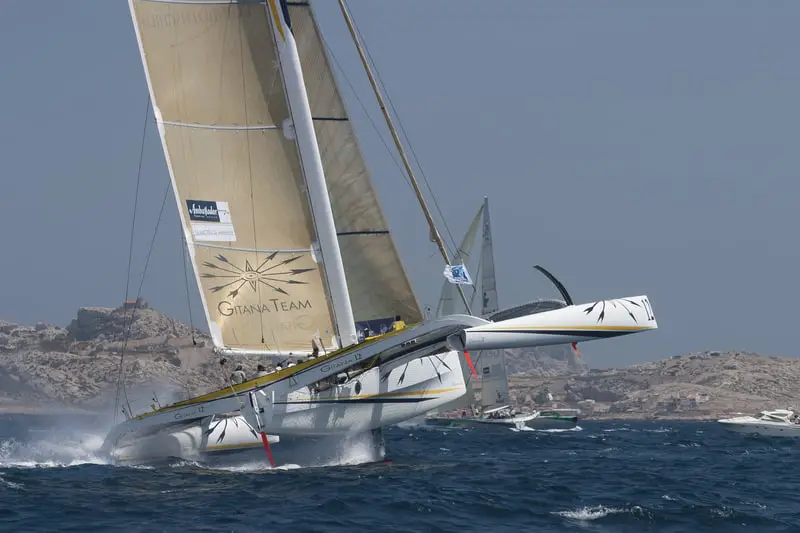
As an Amazon Associate, we earn from qualifying purchases. We may also earn commissions if you purchase products from other retailers after clicking on a link from our site.
Trimarans are known for their speed and excellent performance. However, not every vessel performs well in the ocean’s rolling waves, which begs the question – are trimarans able to handle rough seas?
Trimarans are seaworthy because their tri-hull construction makes them incredibly stable, even in the roughest sea conditions. They are lightweight, very buoyant, easy to handle, fast, and resistant to capsizing. Trimarans also have a shallow draft.
So, let’s get into the details and discuss why trimarans are an excellent choice for seafaring. I’ll tell you more about the features that make them safe and ideal for traversing the oceans. So, let’s get into it.
Table of Contents
What Makes A Trimaran Seaworthy?
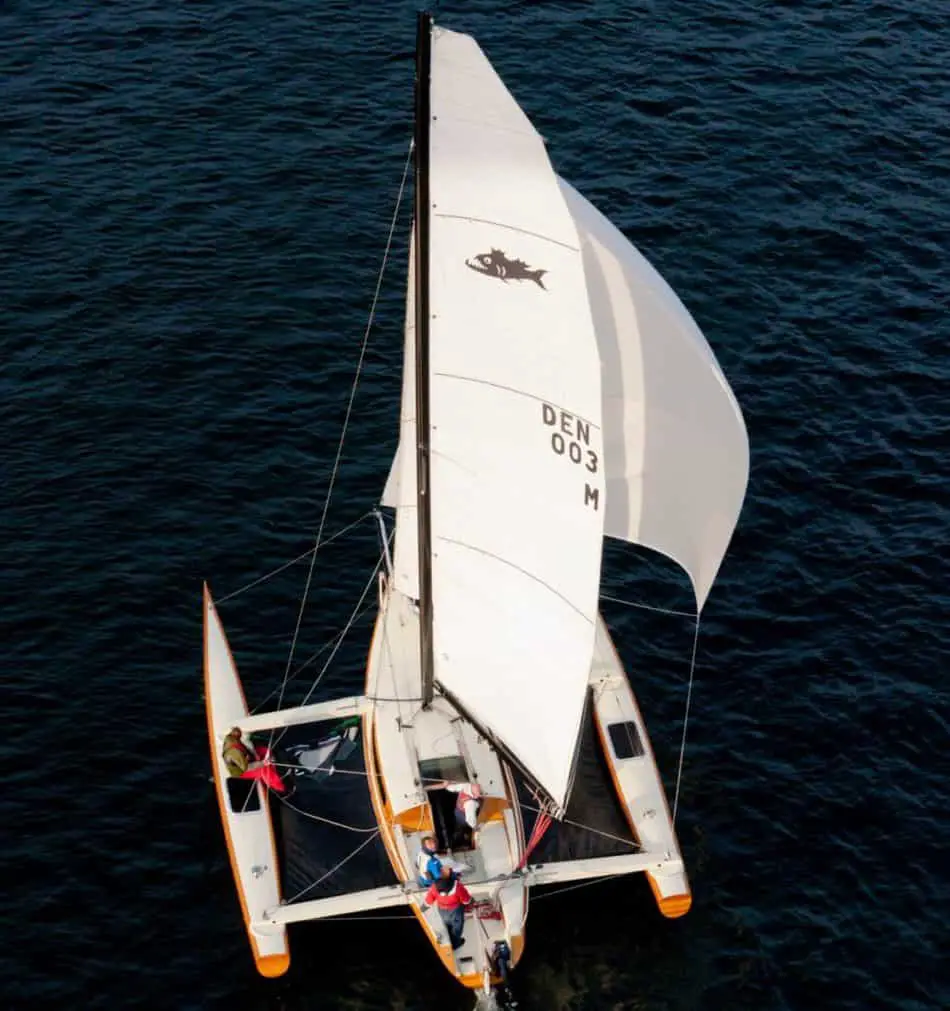
A trimaran is seaworthy because of its wide base giving it capsize resistance, its high speeds allowing for outrunning storms, and good maneuverability, making transiting stormy areas with precision, safer.
I’ll describe these factors in more detail below:
Buoyant Construction
One of the most important factors making trimarans seaworthy is their buoyant construction.
Modern trimarans are made from two lightweight fiberglass layers with a foam core, giving them exceptional buoyancy.
This should be seen in comparison to their lead keel counterpart, the monohull.
Trimarans also consist of various sealed parts, allowing them to remain afloat if one or more parts become damaged in a collision. If the worst came to the worst and the ocean obliterated the entire trimaran, there would still be buoyant pieces to act as rafts for the crewmembers to hold onto.
Many trimarans also have watertight crossbeams between the hulls, further increasing their buoyancy.
If the trimaran were to become filled with water, any of its hulls would be able to keep it afloat.
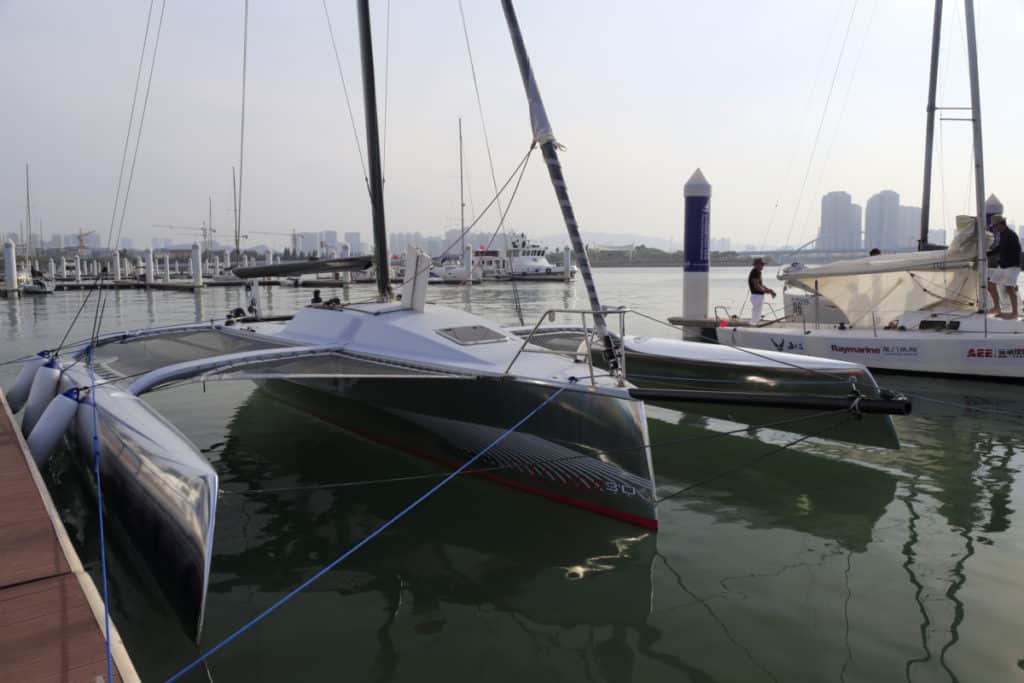
Catamarans are known for their excellent stability, and if they heel (lean over with wind-filled sails), they can right themselves up to a 12° angle before flipping over.
To understand when a catamaran or trimaran will capsize, I suggest you read this article: Why Catamarans Capsize .
On the other hand, Trimarans are well-known for their righting torque (the ability of a vessel to right itself before flipping over). These vessels can reach a 27° angle before they flip over, but the trimaran will likely remain floating even if this happens.
So, although they heel more than cats, and studies suggest they would capsize “more easily”, they are very stable.
This stability and ability of trimarans to keep themselves upright are due to their wise base. Just like when someone pushes you, you take a step to widen your base, so do the trimarans amas (the floats to either of the side of the center hull).
This means that the wind’s force can push harder on the sails before it flips, harder than if it had a narrow base (monohull or cat).
With its tri-hull design, a trimaran’s weight is distributed primarily on the middle hull. This mid-central balance provides a lot of vertical stability for the vessel, but the two outrigger hulls (a.k.a. amas, connected via lateral beams) give added sideway stability. Its multi-directional strength allows a trimaran to remain stable even in the roughest seas.
While monohulls are heavy and tend to go through the waves, trimarans are light and go over. This means higher speeds but also a different more bumpy ride, at least while going into the wind.
A trimaran’s three hulls will contact the wave at different points. However, because their hulls are slimmer than a monohulls, they can slice through waves more easily but will lack the kinetic energy to drive through.
Shallow Draft
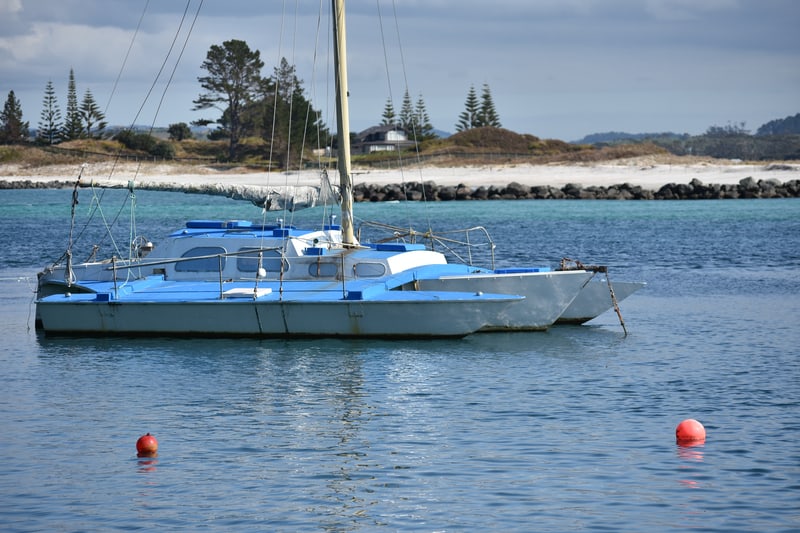
A boat’s draft refers to the distance between the bottom of the boat and the waterline. Trimarans have a very shallow draft due to their lightweight construction, hull design, and buoyancy.
A trimaran’s shallow draft means that it will be able to sail in waters that monohulls can’t. This allows for more shallow water harboring options, something that can be very useful when a storm is approaching.
Maneuverability
Lightweight and responsive steering means not only that a trimaran is fun to sail, but it also allows for more precise maneuvering. This is not only useful in marinas when navigating tight quarters, but it is also essential when transiting large waves at the right angle.
Capsizing Resistance
A trimaran’s design makes it very unlikely to capsize as it has a fast-draining deck, open-weave wing nets, and a wide base.
The fast-draining deck and cockpit have drainage holes to help prevent waterlogging in extreme conditions.
Trimarans also have open-weave wing nets to help decrease windage and reduce the amas susceptibility to digging into the water when waves crash over it.
As noted above, the trimarans main feature, the wide stance, allows for more power to the sail before there is a need to reef. This means higher speeds!
Speed is not a primary factor contributing to seaworthiness, but speed can improve a boat’s safety in storms.
If the trimaran encounters a dangerous storm, its high-speed capability allows it to move out of the stormy area faster, decreasing the chances of an accident.
Safe Cockpit
Trimarans usually have sealed or partially sealed cockpits with windshields, allowing the captain and crew members to navigate the vessel comfortably, even in extreme weather conditions.
A trimaran’s protected cockpit also helps keep the vessel’s essential navigational equipment safe during stormy conditions, contributing to its seaworthiness.
Final Thoughts
So are trimarans safe in rough seas.
Are you in the market for a new boat and considering a trimaran? If so, you may wonder how safe they are on rough seas.
Trimarans are safe in rough seas because they have high righting torques, and conditions have to be extreme before they flip over. They have excellent vertical and lateral stability due to their tri-hull design, and their buoyant construction helps keep them afloat.
Trimarans are some of the speediest vessels out there, and in rough seas, they can move out of the stormy area and into safety. They are also easy to handle and have protected cockpits, making them safer to use on rough seas.
Trimarans are seaworthy because they have three hulls, giving the vessel excellent stability, even in extremely rough seas. They consist of lightweight and buoyant foam-core material with multiple sealed sections to allow them to float if one or more parts become damaged.
Trimarans can quickly move to shallow harbors in storms with their shallow drafts and high-speed ability.
Trimarans are easy to handle, and their sheltered cockpits make it easy for the crew to navigate them expertly through the sea. The cockpit or deck is unlikely to become waterlogged because of the drainage.
- Shuttleworth Design: Multihull Design Considerations for Seaworthiness
- Yachting & Boating World Forum: Are trimarans safe?
- Chemical & Engineering News: What’s fiberglass, and how does the delicate material reinforce thousands of products?
- The Free Dictionary: Heeling
- Wordnik: Outrigger
- Discover Boating: What is Boat Draft?
Owner of CatamaranFreedom.com. A minimalist that has lived in a caravan in Sweden, 35ft Monohull in the Bahamas, and right now in his self-built Van. He just started the next adventure, to circumnavigate the world on a Catamaran!
Leave a Reply Cancel reply
Your email address will not be published. Required fields are marked *
Save my name and email in this browser for the next time I comment.
Recent Posts
Must-Have Boat Gear for Catamaran Sailors!
Sailing is probably the most gear-intensive activity I've ever done; there are so many decisions to be made about what gear to buy now, for tomorrow, and what to definitely never buy. The gear on...
6 Best Trailerable Trimarans For Bluewater and Coastal Sailing
Having a boat costs a lot of money, even when you are not using it, marina fees, etc. And once it is in the water most sailors never go very far from their "home marina" and sailing will be somewhat...
- 0 No item in your cart
- SUBSCRIPTION
- Classified Ads
- Technical Specifications
- Destinations
- Address book

- All the magazines
Capsizing - Should we break the Taboo?
The risk of capsize on a catamaran of more than 40 feet with a displacement of more than 10 tons is almost non-existent.
Article published on 26/05/2023
By François Trégouët
published in n°190 july / aug.

With the confusion of genres caused by the super-powerful ocean racing multihulls, the conservatism of monohull sailors and the high commercial stakes, the risk of capsizing is still a taboo subject for many people in the world of two or three-hull sailing boats. However, rather than just focusing on hearsay, Multihulls World suggests a rational approach to the subject in order to get a better understanding of the situation.
Create a notification for "Technical"
We will keep you posted on new articles on this subject.
The action takes place on a brand-new large cruising monohull during a press test. The yard has invited a serious potential buyer to join us. The potential buyer was full of praise - which was well deserved - for the excellent vessel, much to the delight of the shipyard’s marketing director, who was also on board. What a surprise when both of them agreed that they would never go on a long cruise in a multihull, or that they would not even cross the Atlantic in the trade winds during the best season on a cruising catamaran, under the pretext that a multihull would be “as stable upside down as the right way up”. I, who had been so discreet until then, keeping my intimate passion for multihulls secret so as not to offend anyone, lost all sense of diplomacy - my blood ran cold. I heard myself blurting out a sentence I thought I had forgotten: “like a monohull which is as stable on the water as it is on the bottom!” The atmosphere in the cockpit suddenly became rather tense... Misunderstanding and confusion have allowed such prejudices to persist. Regattas and offshore racing have largely contributed to this (bad) reputation. But you really can’t compare those racing machines with our cruising multihulls. Even among extreme vessels there are differences. An Ultim trimaran takes off in around 16 knots of wind. An Ocean Fifty sails on one float from 13-14 knots of wind, while an Orma 60-footer makes do with 11.5 knots. Even more extreme, the BMW Oracle trimaran in the America’s Cup rises up from 7 knots: a real lake boat! Moreover, on board a Decision 35, if the wind rises to 20 knots on Lake Geneva, the boat becomes unmanageable. Out on the open sea, alone, the risk is tenfold because the reaction time is longer, whereas anticipation is more necessary than ever. But let’s concentrate on our cruising multihulls. Even if it is statistically insignificant - in recent times there have only been 1 to 5 capsizings of multihulls over 30 feet per year out of 15,000 cruising multihulls that are currently sailing (we are not talking about shipwrecks or total losses caused by hurricanes like Irma). That means the risk is 0.017% per year. Over the lifetime of a boat – say 40 years - this amounts to 0.67%. Compare this with the risk of a car accident - 1 every 70,000 km in France, according to the Road Safety Department, or 1 every 7 years (the average mileage of a car being 10,000 km/year globally). So, a 0.017% risk of capsizing for a multihull every year, against 14% of having an accident on the road for a car, certainly raises a few questions don’t you think? However, even if it is insignificant, the risk of capsizing on a large production catamaran or trimaran does exist. The proof? It is regulated by the standard that all manufacturers must respect. Thus, at the helm stations of all good modern multihulls, three small yellow triangular pictograms prevent any temptation to turn a blind eye. The first one, an exclamation mark, draws our attention to a ...
Subscribe to Multihulls World and get exclusive benefits.
Tags :
Did you like this article ?
Share this article
Most-read articles in the same category.

2024 Multihull of the Year Election - You’ll soon be able to vote for your favorite multihulls!
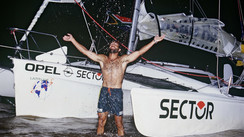
Who's Who - Mike Horn: “I fell in love with multihulls”
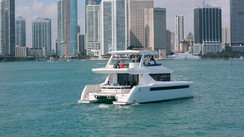
Miami & Florida - The American boating spirit
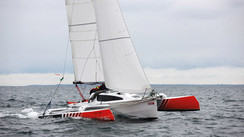
2023 Sail Buyer's Guide - Multihulls from 30 to 40 feet
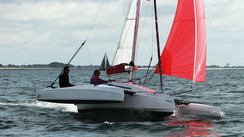
2023 Sail Buyer's Guide - Multihulls from 20 to 30 feet
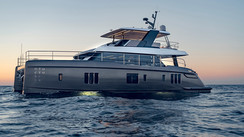
2023 Power Buyer’s Guide - 60 to 70 feet
What readers think.
Post a comment
No comments to show.
Follow us on
Vous avez ajouté " " à vos favoris., vous avez supprimé " " de vos favoris., in order to add this article to your favorites, please sign in..

How to assess your capsize risk and bring it down to near zero
Ques: when should i reef a trimaran (like the w17) and what other precautions might i take to avoid a capsize rb, antalya, turkey ... june 2022, ans: well, the ‘dumb’ answer is, ‘ reef before you capsize”, but to figure out when that is likely, a little figuring can surely help;).
There is really a long list of possible answers that depend on a long list of cases, but we have to start somewhere. The sea and wind can throw you such an infinite variety of possibilities but let’s look at 3 the most common scenarios as if you can control these, you will cut your risk of capsize by about 90%.!
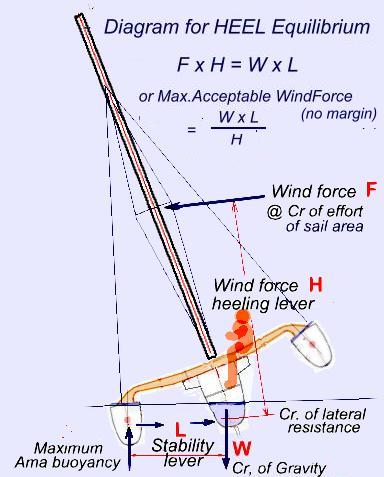
First, the capsizing arm. In this case it will closely relate to the wind force on the sail area you have up, multiplied by the height from the center of lateral resistance* to the center of pressure on the sails you have set.
*While there are arguments to using the vertical center of buoyancy instead of the center of lateral resistance, I prefer using the latter as it factors in the effect of a drop keel into capsizing .. increasing as it does, the capsize lever when its fully down. Of course, if the drop keel is weighted, then its otherwise negative effect may be compensated by a small increase of the righting moment but not unless the boat takes on significant heel.
For the righting moment, the more weight the better but its location is critical. (A lighter boat will typically capsize more easily). On a heeled multihull, the center of buoyancy will quickly move to the leeward hull or ama and for that reason, these boats are VERY stable - up until the buoyancy stops moving out, which is when the windward hull lifts above the surface. This maximum stability point can be as low as 10 degrees heel on a wide catamaran but will be more like 30-35 degrees on a trimaran, as it will take that angle to lift the center main hull out.
What happens after that will depend on the amount of buoyancy in the ama. If it’s less than the total boat weight (with crew), the ama will be pushed under and the tri will rotate with its main hull just lightly in the water, only displacing the difference between the total weight and the buoyancy offered by the ama. So if the total weight were say 800lbs and the ama buoyancy was 700lbs, the center hull would float high on its bilge, needing to donate only 100lbs of buoyancy (about 1.5 cuft of intact volume) for a state of ‘pre-capsize equilibrium’.
Whether it would stay there would depend on 1) how high the buoyancy is in the ama and 2) how low the weight is in the main hull. If the buoyancy was low in the ama and the weight high, the trimaran would turn upside down, unless this capsizing couple (leverage) could be offset with mast-top buoyancy. In practice, that’s often proven quite hard to achieve as the load on that buoyancy pod can be higher than its structural strength & attachment, or even that of the mast, though something auto-inflatable can in some cases be made effective.
But let’s look at how we might avoid this in the first place, and a look at sail area and wind loads would be a start.
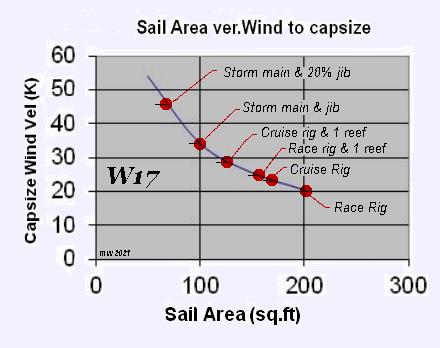
Obviously, any crew sitting to leeward, would have the reverse effect and as for any small boat, the crew should be ready to ‘quickly move to the high side’.
So here is a chart to think about. While this one is specifically for the W17, it would be wise to create one for your own trimaran, as many of the commercial models are not as stable as this one.
So one should plan on reducing sail BEFORE the wind gets up to the level indicated, as this shows the approximate static capsize point with a given side wind.
It’s important to realize that once a boat is heeled beyond its point of maximum stability, things can change fast. While the boat will still want to right itself, the 'rate' of this applied stability will get less and less with each degree of heel and eventually disappear to zero at some very high angle. This point of no-return will be particularly hard to judge in waves as the boat will change its heel angle relative to the horizontal as wave-forces of their own act on the immersed hulls of the relatively lightweight trimaran … especially if there are surface white crests that represent ‘moving’ water. (See this note on Max Stability of Multihulls )
For this Scenario #1, having the ability to quickly relieve wind pressure on sails will generally annul the situation. There are a couple of approaches to do this.
If you are near stationary, releasing the sheets, or at least the main sheet will be essential. While this ‘sounds’ straight forward, it may not be. A very strong gust can put so much load on the mainsheet of a stable trimaran that the mainsheet practically fuses to the cleat teeth, so it’s essential that the cleat be set up correctly. Many boats I’ve sailed were set up to permit the mainsheet to be easily cleated but this is wrong .... dead wrong. This cleat must be set up to be easy to get OUT of, and that typically means it will be hard to get IN. On my current boat, the camcleat is on the lower triple block and it can be swiveled up and down. I’ve set mine in the highest position, so I actually have to stand up and even stretch up to engage the cleat. But as I am always engaging this cleat in moderate conditions, it’s easy to do. Then, should I have a gust with the potential to capsize me, I only have to pull the mainsheet straight towards me to pull the rope downwards out of the cleat. So with a quick ‘tug & release’, the mainsheet runs out every time. With the maximum load* on my boat never exceeding 65lbs and generally MUCH less, that’s always doable. But if your max line load goes much over 75lbs, you will need to add more blocks to your mainsheet and also consider another cleat type (like the Spinlock rocker that releases easier). But on a larger boat say over 7m (22ft), there’s another important issue that often factors into a capsize and that is the skippers loss of balance in a highly heeled cockpit and the resulting difficulty to apply the release force quickly. As this leads to a relatively high proportions of the capsizes, I’d certainly consider an EMR (Emergency Mainsheet Release), so I will add more on this later (see NOTE at the end of this article).
*If you want to roughly calculate what your mainsheet load might be, here is a simple formula that works acceptably for me. Let’s define ‘Mainsail Area’ (sqft) as MA and the No. of Parts on your mainsheet as MP . Then your M ax Mainsheet Load (MML) will approximate: (MA/MP) x 2 . (There IS a little science to this as the 2 represents 2lb/sqft wind load ….the normal maximum point at which you would reef and reduce area). For my W17 this is (167/5) x 2 … or 67 lbs. I have not seen this level as yet, but I am aware it’s possible.
On the 25ft Magic Hempel my initial MML was 300/6 x 2 = 100 lbs and once that proved impossible to uncleat as the wind gust was enough to totally lock-up the camcleat. With an ama driven nearly 2ft underwater, it was the closest I came to capsizing her (2003) and had me changing both the no. of tackle parts AND the cleat after that. (It also triggered my first thoughts to develop an EMR).
#2 is related to the above, as it’s also a conventional capsize risk to leeward. But this time, you are moving along, dealing with high gusty winds .. caught in a situation of two much wind for the sail you have up. Ideally this should never happen of course, as by now you know you ‘must always reef in time’. (see Hoving-To [point #4 below] for that option)..
But you will occasionally run into situations when perhaps it’s either too dangerous to stop (due to a shoreline or whatever) to take a reef .. or you see from a passing black cloud that these conditions will only last a short time. You are clearly over-canvassed but need to safely survive for say 10-15 mins.
In such a case you can generally find ‘a sweet spot’ in the direction of a close reach. First, ease out the traveller to the limit and then concentrate on sailing the boat at a constant but moderate speed while retainng as constant a heel angle as you can . With the wind gusting perhaps to 50% more than the average and the direction changing 20-30 degrees, you will have your hands full, but put your mind to it as it’s not for a long period. The way you will control both heel and speed, is with the tiller. You will sail a very wiggly course as you will turn upwind when speed and heel increase, but downwind when you are headed and slowing down. About 5-6kts is a good target speed, offering excellent rudder control without excessive high speed from bearing off that can put you into the next situation of Case #3. Obviously, if the conditions have really changed for the longer term, then reefing or better still, substituting a modern storm mainsail, will be far safer and more relaxing. This is particularly effective with a rotating wingmast. More on this here .
#3 The other equally common way of capsizing a multihull is what we might term, the ‘diagonal pitchpole’. This is when one ama bow is pushed under by a complex combination of 5 variables, namely wind, heel, pitch, speed and waves. As all these things generally factor into a pitchpole, we need to focus on the ones we can control. A diagonal pitchpole typically starts when bearing away, heading on a broad-reach or downwind.
First, we can do little ourselves about either wind and waves, so we are left with heel, pitch and speed to control, so while we are comfortable ashore, let’s analyze each.
Heel can be reduced in 4 ways.
1) Adding weight to the high side. Although effective for small boats this is not always easy as you may need to stay in the cockpit. Also, while weight might be required outboard for a short burst, the need may not be there all the time, so it will depend on how athletic the crew can be. So this is not a very reliable way, especially for those no longer very athletic.
2) Head upwind more to ease pressure on the sails. This will lead to the Solution #2 above, but may not be an available option if the shore is to windward. Even when it’s possible, this must not be executed too quickly or the centrifugal forces can momentarily increase the heel.
3) Head downwind more to have the pressure pushing more downwind, when boat speed will reduce the driving wind. This can work if the waves are low enough to ride over. But can be dangerous if the bows dig into a large wave, preventing the bow from lifting. If the bows are deeply digging in, cutting speed is essential and that means either sailing as in condition #2 above, or reducing your mainsail area significantly.
4) Reduce the sail area by reefing or changing sails. If the conditions look like they are there to stay for a while or even worsen, then this is the wisest option but you will need to first hove-to . Here is how, and it’s worth practicing when conditions are moderate.
Bring the boat into a closehauled position and then tack towards a safe direction (considering any obstacles) but leave the jib sheeted as for the previous tack. Once you have tacked, slacken the mainsheet completely, push the tiller down and partly slacken the weather jib sheet until the forward half of the jib is laying on the centerline of the boat. This is the ‘hove-to’ position and with a small adjustment to the rudder and jib sheet, the boat will lay there about 50-55 degrees to the wind and only advance at about 1-2 kts. See here for a short 'how-to' VIDEO
The mainsail will be slack and closely inline with a rotating wingmast, allowing you to readily lower the sail to take in a reef (another advantage of a rotating mast). If you lower the sail completely to change to a stormsail, the boat will likely turn more downwind so you will need to ease the weather jib sheet, and lightly pull in the leeward one. You now have the safe option of sailing downwind with only the jib, or raising a stormsail to sail back upwind. Control is now back to you and you are now at very low danger of a capsize.
Forward PITCH & TRIM can be reduced in a few ways,
1) Moving weight aft
2) Using a foresail rather than a mainsail while going downwind, as the vector off the sail will lift more upwards. Spinnakers do this also.
3) Pitching can be reduced with design changes and changing weight location.
After sail area, the next most important way to reduce a Pitchpole is SPEED Speed can be reduced by either easing off the sail, changing the attack angle to the wind or by reducing sail area. Of course, in extreme conditions, one can further cut speed by towing something to add resistance over the stern, to act as a drogue. In this case, dragging this from a bridle is much preferable as this can then be trimmed to pull from either side or from the center, to give the best directional effect. As far as drogue diameter size, something about L^2/230 will typically start to be effective. (ft. units) … or L^2/70 in meters.
When sailing in a strong wind with perhaps more sail than is really needed, the best prevention against a capsize is to keep ones eye glued on the bow of the leeward ama. (If a sail often blocks your view, mark where a window is needed and get that added at the first opportunity). At the ama bow, keep a MINIMUM of 1% of your boat length ** as average minimum freeboard. (Suggest to use even 2% for safe cruising).
** This is based on having the ideal ama length of at least 90% of the boat length. So if its under 90%, take 1% of the mean of the boat length and ama length . ie: 1% of (Boat L + Ama L) / 2.
This means that while a few short wave tops can pass above that line, the solid average waterline at the bow must not. If it starts to, immediately ease the sails a little or adjust your angle of attack to the wind if navigation space permits. Having a clear view of the leeward bow is ESSENTIAL for this safety and for larger boats sailing at night time, it’s definitely an added safety feature to have a flood or spot light mounted on the cabin or hatch top that can be rotated in different locations. (This can be achieved with a simple rotating mount (plywood is fine) with a sprung lever that holds a peg in each location). These suggested positions are Port quarter, Port beam, Port bow, Mainhull bow, Starb’d Bow, Starb’d Beam, Starb’d Quarter.
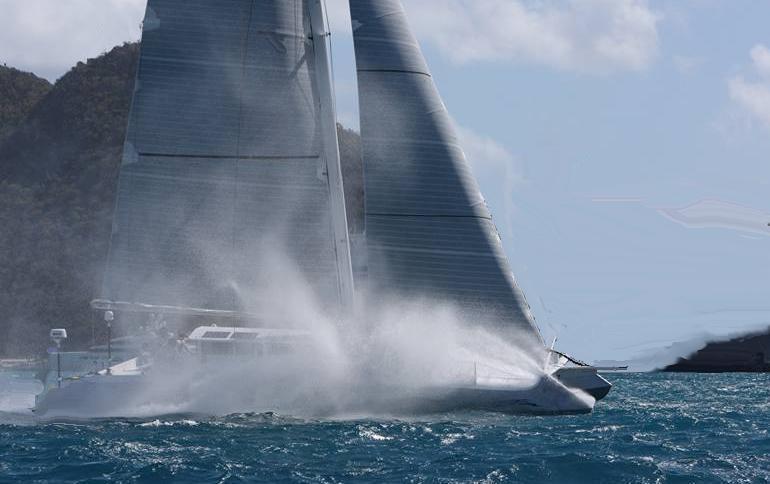
Seeing the ama just above the water level is assurance that we have a small, but ‘critical to survival’ buoyancy reserve .. and is akin to seeing a decent shoulder on a road when we drive fast. Without such a definition point, it’s far too easy to exceed the safety point. In fact if I were sailing a boat with reverse bows, I would definitely want some indicator installed to represent 1/100 th L below the deck line, or I would make my guidance safety line much lower down for common-sense security.
Note: re earlier pre 1990 designs. One case where a lower bow line will be needed is when considering an early designed ama with high sheer .. such as we see for the Hobie 14/16 beachcats but also for those impressive ‘big birds’ designed by Dick Newick. Virtually all designs since 2000 have more moderate or near straight sheers for their amas, and my above recommended indicators apply fine for these. For the Hobie cats, the high sheer is still sometimes of value, as it’s often needed for boats being launched off beaches with high surf conditions. But for boats without this need, high sheer is no longer recommended. Although the high bows can be of added comfort in short steep waves, it’s now generally accepted that this buoyancy only becomes fully effective when the boat pitches a lot, so effectively allowing it to do so, plus the high bow freeboard adds much windage when less is needed ... not to mention the shorter waterline length such amas offer. So while there was a certain elegance to the banana-shaped ama hulls, they are no longer considered the most efficient for either performance or resistance to pitching. It’s worth noting that not all designers of the 1980’s followed Newick and one major exception was the Australian Lock Crowther whose aeronautical design background had him well ahead of his time with light weight, straighter lines and greater beam, such that his designs still perform remarkably well today. (It’s no coincidence that my first trimaran was indeed a Crowther design .., they just made sense to me at the time ... ie 1980's)
So to correct for the high sheer of banana hulls, I would suggest to first mark down the bow to remove at least 1/2 the actual sheer and then mark the L/100 down from there. Otherwise, you will be assuming there is acting buoyancy ahead of the forward aka (beam) that there is not.
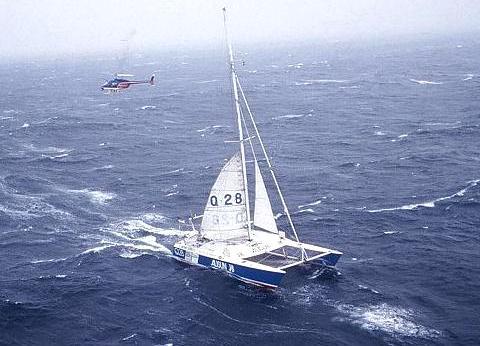
I think it’s time that more multihull sailors realized that despite their great initial stability, their often large sail area is there for light wind conditions (to offset their generally higher wetted surface that particularly adds drag at low speeds) and to therefore be more ready and accepting to reduce sail down to more sane proportions as the wind increases. Unless you are sailing a heavy roomaran, the slim hulls of multihulls do not need a large sail area in strong winds to drive them and it’s just being foolhardy and irresponsible to drive such a boat beyond its limit every chance you can. Take this 60ft cat being sailed by a seasoned circumnavigator (Henk de Velde ). The boat is triple reefed yet still clearly sailing fast and looking very comfortable in her wild environment. We should learn from such wisdom. The low center of effort of this reduced rig is great for running downwind like this, but a high-aspect ratio storm mainsail behind a rotating wingmast, will show surprising benefit going upwind.
So here is a short summary wrap-up .
* Consider carrying a storm mainsail and use it in winds above 20kts.
* Watch the leeward ama bow and use 1/100 th of the boat length as a minimum freeboard at the bow and add a window in any sail that is blocking your view of that leeward ama bow
* Add a reflective tape there at 3 levels, (about 1/70 th of Length “long”). For a pure cruising boat, I would even recommend using 1/50 th of the boat length as a guide line for minimum ama bow freeboard to maintain more reserve there.
* S et you mainsheet cleat to release with a simple straight pull
NOTE re the use of an EMR …. an Emergency Mainsheet Release. Although these have been experimented with and used on large expensive boats, their price and complexity would not generally bring them into the conversation for more modest craft that most of us might sail. But the sheer numbers of multihulls now in circulation changes things and there is little doubt that one of the aspects most talked about in the monohull vs. multihull debate , is the risk of capsize. So if we can find a way to reduce this with a solution that is both affordable and acceptably reliable, it’s certainly well worth considering. Having learnt about hard-to-avoid capsizes firsthand from both clients and friends, I joined forces with another sailor and engineer in 2021 to create SeaSafetyTech LLC to research a possible solution, so here is a link to an Introduction to the W-B EMR. (PDF) . If this potential anti-capsize solution interests you, until the product is officially launched (likely in 2024). please contact me via the Questionnaire with your questions and potential needs. (2023 update: a production prototype is now installed on a 27ft racing trimaran in Europe and undergoing on-water tests).
Copyright : Mike Waters: June 2022
NOTE: As this well researched information is given out FREE, I hope I can ask readers a small favor. If you also visit the Forums like BoatDesign.net and see something being discussed that perhaps one of my articles can shine some light on, please post for them a website reference so they can visit here, Who know, perhaps they will like one of my boat or mast designs and bring in funds to cover another article. Thanks guys, ,,,, we can all help each other a little here.
. "New articles, comments and references will be added periodically as new questions are answered and other info comes in relative to this subject, so you're invited to revisit and participate." —webmaster

Trimaran VS Catamaran – Which Boat Is Best?
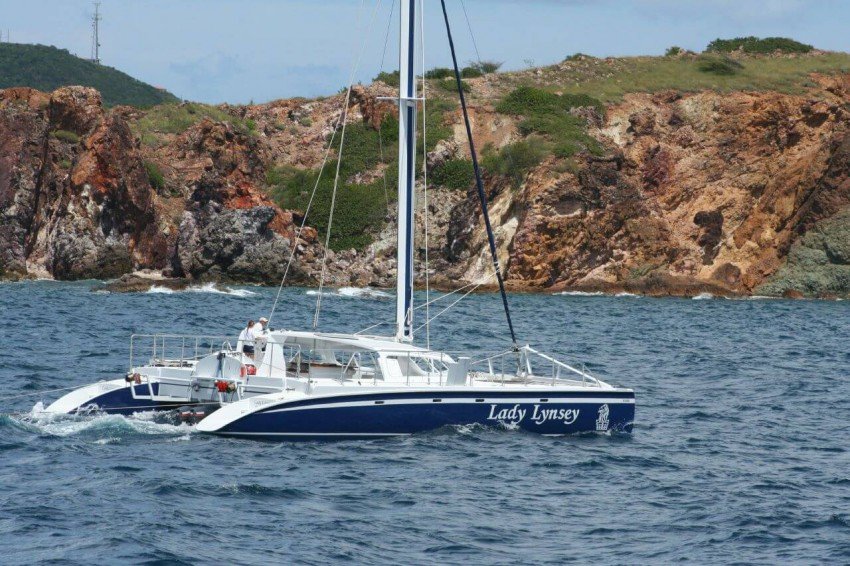
If you’re planning to buy or charter a multihull boat, you might be wondering which one is better: trimaran or catamaran. Both have their pros and cons, and the decision ultimately depends on your needs and preferences. In this article, I’ll explain the differences between these two types of vessels to help you make the best choice for your needs.
Post updated: 10 November 2023
Table of Contents
Differences Between Trimarans and Catamarans?
If you’re in the market for a new vessel or plan a family vacation on the water, you might wonder what the differences are between a catamaran and a trimaran.
Let’s see what they are:
A catamaran is a multihull vessel with two or twin hulls that are parallel to each other and fixed to a wide beam.
This design offers stability and speed, making it a popular choice for cruising long distances comfortably and even racing.
They also provide more interior space than trimarans, allowing for larger cabins and more storage.
When it comes to sailing performance, catamarans are known for their speed and agility.
Their twin hulls allow them to easily glide over the water, making them popular among boaters.
Cats are stable, fast, spacious, and super comfortable and are more stable at anchor than trimarans. However, catamarans tend to perform better in downwind conditions than in upwind conditions.
A trimaran is a multihull vessel that has three hulls. The two smaller outrigger hulls are attached to the center hull, which is larger and used for most of the boat’s functionality.
This design offers even more stability than a catamaran, making it a great choice for those who want to sail in rough waters safely.
The three-hulled design makes them super stable, and as mentioned above, they can easily handle rough waters. They also have a smaller turning radius, making them easier to maneuver in tight spaces.
Another important thing to know about Trimarans is that they provide a decent degree of livability, but they fall short of catamarans in two regards. First, they heel more than cats, making it difficult to do things like cooking on board. Second, they support much less load than catamarans.
Pros and Cons of Catamarans and Trimarans
Before making a decision whether to sail a catamaran or a trimaran, there are pros and cons you must consider. Let’s see what there are:
- Stability: Catamarans have two hulls, which makes them extremely stable. This means that you are less likely to experience seasickness or feel the boat rocking in rough waters.
- Space: Catamarans have a lot of space both inside and outside the boat. This makes them great for large groups or families who want to spend time together without feeling cramped.
- Speed: While not as fast as trimarans, catamarans are still faster than monohulls . They perform better in downwind conditions than trimarans and are great for long-distance cruising in calm waters.
- Shallow Draft: Catamarans have a shallow draft, which allows them to enter shallow waters and anchor closer to shore.
- Cost: Depending on how well the Catamaran is equipped, it can be more expensive than trimarans. Not always, though.
- Harbor Cost: As catamarans have a very large beam, this means that a berth at the marina will be higher.
- Navigation: Catamarans tend to struggle sailing close to the wind .
- Speed: Trimarans are known for being faster than cats and single-hull boats. They can easily reach high speeds and are great for racing or long-distance cruising.
- Stability: Trimarans are more stable than catamarans due to their three hulls.
- Space: Trimarans are wide, but the interior is less spacious than catamarans.
- Safety: Provide exceptional buoyancy. If a trimaran capsizes, there is almost no chance it will sink.
- Navigation: Trimarans can sail in any weather condition and perform much better upwind than cats.
- Berthing: Trimarans are more difficult to maneuver in harbors, making finding a berth in crowded marinas more challenging.
- Maneuverability: Trimarans require more ability from sailors to beach without difficulty than catamarans.
- Loading: Trimarans struggle to carry as much weight as catamarans.
- Sailing: Trimarans require more effort and work on the deck.
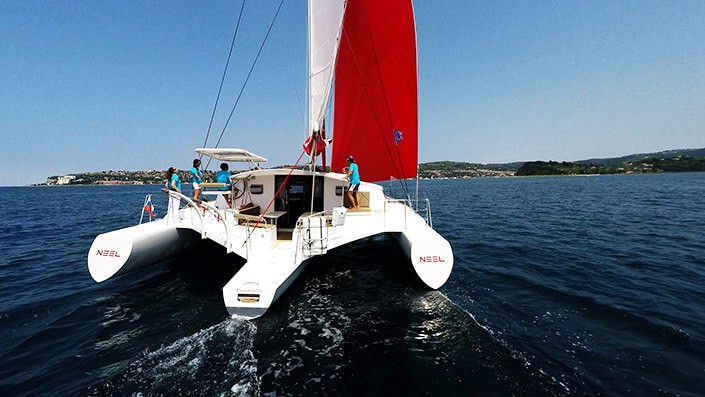
Design and Structure
When it comes to design and structure, there are significant differences between trimarans and catamarans. Below, I’ll walk you through these two multi-hull vessels’ geometry, hydrodynamics, weight, and materials.
Geometry and Hydrodynamics
One of the most significant differences between trimarans and catamarans is their geometry. A trimaran has a central hull with two outriggers connected to a large beam, while a catamaran has two parallel hulls connected by a central platform.
This twin-hull design gives catamarans a unique sense of balance and stability. On the other hand, trimarans offer superior stability and adaptability in various water conditions thanks to their three-hulled design.
The central hull of a trimaran is typically longer and narrower than the hulls of a catamaran, which leads to better hydrodynamic performance.
Both trimarans and catamarans have different hydrodynamic resistance characteristics.
For instance, trimarans have less wetted surface area, which means they experience less drag as they move through the water. This feature makes trimarans faster than catamarans in rough weather conditions and high winds.
Performance and Speed
When it comes to performance and speed, there is a clear winner between trimarans and catamarans . Trimarans are known for their speed and are often faster than catamarans of the same size and weight. This is because of their unique design, which has speed and safety qualities that provide significant advantages over catamarans.
Trimarans have less hydrodynamic resistance than catamarans due to their narrower central hull, which allows them to slice through the water more efficiently in rough seas.
While catamarans are also fast, they often fall short of trimarans in terms of speed and performance. But that’s not always true in downwind conditions because cats are light, and their sails are positioned equivalent to the wind, making them faster than tris in downwind conditions.
Heeling and Capsizing
One of the biggest concerns when it comes to stability is heeling and capsizing. Heeling means the boat leans from one side to one side, while capsizing is when the boat flips over completely.
Both trimarans and catamarans heel, but trimarans provide greater stability and are less likely to capsize due to their three hulls. However, this doesn’t mean a trimaran can’t capsize.
In rough conditions, if a wave gets higher than half the size of the beam, the boat can flip over, but because trimarans have exceptional buoyancy, they float on the surface of the water and can serve as a rescue platform, but they won’t sink!
Comfort and Space
One important factor to consider when choosing between a cat and a tri is comfort and space. So, let’s look at these two types of boat’ accommodation: storage, cockpit, and living quarters.
Accommodation and Storage
One of the main advantages of catamarans over trimarans is the amount of space they offer. Catamarans typically have larger cabins and more storage space than trimarans. This makes them a great choice for longer trips, as you’ll have plenty of room to store all your gear and personal belongings.
Trimarans, on the other hand, have smaller cabins and less storage space. This can make the passengers feel a bit cramped, especially on longer trips.
However, some trimarans do offer creative storage solutions, such as under-bunk storage compartments or overhead storage racks. Note that the latest models of trimarans are extremely spacious and offer as much comfort and space, if not more, than catamarans do.
Another difference between trimarans and catamarans is their weight. While trimarans can potentially be built lighter than some catamarans, catamarans are lighter on average due to having one fewer hull requiring structure and ballast.
The weight distribution of a trimaran is also different from a catamaran, with more weight concentrated in the central hull. This feature provides better stability and performance in rough seas and upwinds.
Catamarans, on the other hand, can support more load than trimarans. This feature makes them ideal for long-distance cruising and liveaboard lifestyles.
Frequently Asked Questions
Q: which has better resale value – trimarans or catamarans.
Resale values for both trimarans and catamarans can depend on factors such as the boat’s age, maintenance, and overall condition. Generally, catamarans have a larger market and may hold their value better due to higher demand, especially among cruisers and charter companies. However, a well-maintained trimaran can still attract buyers who value speed and performance.
Q: Which type of boat is more suitable for long-distance travel: trimaran or catamaran?
Both trimarans and catamarans are fantastic for long-distance travel. Still, catamarans are often preferred among sailors for extended cruising due to their larger living spaces and privacy on board. However, if speed is a critical factor for your journey, a trimaran might be a more attractive option.
Q: What factors should I consider when choosing between a trimaran and a catamaran?
When deciding between a trimaran and a catamaran, some key factors to consider include your intended use, performance expectations, available space, and budget.
You should ask yourself:
- What are your primary sailing goals – speed, comfort, cruising, or racing?
- How much living and storage space do you need for your crew and equipment?
- What kind of stability and performance characteristics do you value most?
- Are you willing to compromise on space or speed for the sake of your preferred multihull design?
Final Words!
So, what’s the best boat? Well, both are great. The choice between a catamaran and a trimaran will depend on your needs and personal preferences. If you are looking for a peaceful trip at a slower pace with plenty of space for the whole group, a catamaran will be your best bet. On the other hand, if you want to zip through the water and get your blood pumping, a trimaran is what you need!
Want More Tips?
Sign up to Cruising Sea newsletter to receive every two weeks the latest post straight to your inbox!
Have you sailed a catamaran or a trimaran? If so, please share your experience in the comments below.

Daniella has been passionate about travel, the sea, and nature for many years. As a child, she frequently traveled throughout the Mediterranean and continued with her journeys throughout her adult life.
Her experiences have created the desire within her to share her love for traveling with other passionate and adventurers who want to discover beautiful horizons and new cultures.
26 thoughts on “Trimaran VS Catamaran – Which Boat Is Best?”
Hey, well I’m definitely the Catamaran girl. I love my space and don’t really need the thrill of the ride as much as I value the relaxation and holiday-type feeling. What’s your personal choice? Well since I’m more the sailor’s wife than the sailor, those other problems don’t really apply to me, do they? hahahaha what’s your personal choice?
We have something in common, because I am not a fan of racing . I love comfort and space, so I would go for a Cat!
Have a great day:)
I would go for the trimaran as it’s more stable in tough conditions as I would like to explore the world, not that I want to race. Catamaran is my go to option if I just want a nice vacation boat or something I agree that that one is better if you don’t want to race. I won’t buy a boat in the near future though, I certainly have not got the money, and I live at the wrong location, not far from the sea but still, I can’t even drive (no license). Great article though and I love boats. Wondered what the difference about these 2 are and now I know.?
Hi Stephanie, Sorry for the late reply. I had a minor technical issue:) Yes, trimarans are extremely stable and are faster than catamarans. However, those beautiful boats are quite expensive and if you plan on sailing around the world, you’ll need a small crew with you to handle the boat:). I am glad this article helped you know what’s the difference between a trimaran and a catamaran. Let me know if you need more info. I am always happy to help. Thank you for the comment and I wish you a lovely day.
This is a very informative comparison of the trimaran vs. catamaran style sailboat. They look similar on the exterior to the untrained eye – but it seems like the differences are pretty dramatic. If someone was looking to charter one for a vacation – do you have a specific experience or preference for one or the other?
It will depend on your personal preferences!
What are your needs? Can you be more precise?
I personally love to sail in comfort, I also need a lot of storage, so a cat is my favorite yacht!
Have a wonderful day:)
I have sailed ON a cat but never sailed one myself. Certainly a wonderful experience unlike a single-hulled vessel that rocks and rolls with the swells. That leads me to ask: if caught in rough weather (large swells and strong winds), how reliable is the trimaran? Does either configuration have limitations in this regard?
For the same size of boat, a trimaran have higher sailing performance ,a better ability to tack and go windward. So to answer to your question, a trimaran will handle better in strong winds and will go faster! But! Bear in mind that no matter if it’s a cat, trimaran, or monohull, the safety will all depend on when the sail will be shortened and how the boat will be handled in bad weather.
I hope it helped and if you have any other question , please feel free to get in touch:)
Have a great day!
Awesome write up on the differences between the two beauties. I have learned something new here. I am more of the adventure like person and your quick analysis of the Trimaran, tells me that I probably would lead to this option when choosing between the two.I will certainly browse around your site to check out other interesting articles you have on offer.Take Care, Roopesh.
Hi Roopesh,
Thank you for the compliment and you are very welcome to stroll around my website.
Take care too and wish you an awesome day!
It’s interesting to see the different opinions shown concerning of a debate. I don’t know about these vessels but I enjoyed reading it.
To me, I’ll go for Trimaran because of the modern interiors. I mean, it’s the modern feel that I’m looking for. That’s my main, personal factor.
Still, overall, I think it’s also suffice to say that these two cannot be compared because it’s not like with like. But that’s just my opinion. Trimaran for the win anyways!
So nice to see you again on my website:)
Yes, the trimaran Neel 45 has a modern look, but not every trimaran. Also, they are much faster than catamarans, sailors usually use them more for racing and catamarans for cruising.
Thank you for the comment, I really appreciate:)
I wish you a wonderful day!
I think now the Neel have brought out the 51 the game has changed somewhat. Lots more room ,walk around bed in master room. Lare shower in main head, the inside outside Cocloon as they now call it. Heaps of space below, fantastic headroom down below in central Hull. Much more classic looking boat on the exterior. Add the speed, stability and affordability compared to similar sized Cats and there really does not appear to be any more to be said. Of course it’s just my opinion and if money was not an option i think the Gunboat 60 would be the final choice, but for around 600k the Neel 51 has definitely set the standard. Take a look https://www.youtube.com/watch?v=1-997AEXfsk
Well, that’s a beautiful trimaran you have here, effectively, this one looks much more comfortable and wider than the Neel 45! I would definitely choose the 51 over the 45! I’ve really enjoyed watching the video, and it would be interesting to write an excellent review on the 51:). I agree with you, the Gunboat is such a beautiful cat, and now it makes it even harder to choose between the two of them:) Thank you for the comment and wish you a wonderful day!
Late arrival here but after reading and watching so many negative reviews about the Neel trimarans and the Neel 45 images of one build showing their train wreck quality, there is absolutely no way you can compare a Gunboat and a Neel. You’d be better off comparing it to the Yugo automobile.
The “Sailing Yacht Ruby Rose” did a recent video review of the newer Neel 47 posted on July 18, 2019 showing very clearly that its build quality is extremely lack luster. Although it was the Neel Trimaran that gave me the sea bug, one probably couldn’t purchase a poorer quality boat at any price. It’s an awesome concept but it’s a manufacturer no individual should consider buying from. I’m hoping one of the premium Cat builders will take on the task of providing a similar concept when I’m ready with my money.
Hello Eso, The beautiful thing in life is that everyone has different taste and opinion. I am glad to have you here and thank you for sharing your experience with the readers, this will certainly be useful to many people. I wish you a fantastic day!
Yes I’ve been looking at the Neel 51, Its turning my attention some what. It would make world cruising just that little bit faster and with room and comfort. PS I like the engine room.
Hi Mercury,
Thank you for the comment! The Neel 51 is a beautiful boat. She is more spacious and comfortable than the 45 Neel, but the 65 is even better! However, the 51 is an ideal cruising trimaran to sail in comfort. She provides everything sailors have ever dreamed of such as speed, stability, space, and luxury. What more to ask for:)
Thank you again for the comment and wish you a wonderful day!
I own a Catana 47 with one owner and two guest cabins. I and my wife want four cabin boat so that We can sail with our two daughters and their family including grand children. Should I buy Catana 53, Outremer 51 or Neel 51?
Thank you for commenting!
I am not a boat seller, but I will be more than happy to answer your question. The Catana 53, Neel 51, and Outremer 51 are fantastic boats. And to be honest, I would personally buy the Neel 51 because she is extremely spacious, lightweight and more stable than any catamaran out there.If you bring children, then you would want the boat to be safe. The other boats are also great but tend to perform less well in strong winds and heavy seas than the Neel 51. So yes, the Neel 51 is unbeatable in all categories! At least to me:)
I hope it helped and, please, feel free to contact me if you need to know further information. I am always happy to assist!
Thank you again for the comment and wish you a lovely day!
It’s really a good Information. I have never been in any one of the rides but I feel personally Cat is better. Do you guys know anything similar to this other then Cat trimaran like Semi-Submersible, drone etc. as I am doing a project that will help you to ride Cat Yourself alone!. Wish me good luck and please help me achieve my goal fastly, by sharing your precious knowledge and time. thank you in advance.
Hi Mohammed,
We would like to help you, but we didn’t really understand your question, could you be more specific, please?
Thank you for the comment!
Hello Daniella, Firstly thank you very much for your kind response. I would like to have some info about the Stability equation of Catamaran and different steering Mechanisms.
You are very welcome!
Please, check out these articles, I am sure you will find all the answers to your questions: file:///C:/Users/gofri/Downloads/6962-1-10720-1-10-20130718.pdf
http://www.sailingcatamarans.com/index.php/faqs/19-sailing-and-performance-questions/109-which-steering-system-should-i-use
I hope it helped! Don’t hesitate to contact me if you need more information, I’ll be more than happy to assist!
Dear Daniela Thankyou very much for your Kind help. Could you please give some Information about the construction guidance of Catamaran. I want to construct my own for my experimental purposes. Thankyou Regards Moulasaheb Md
Hi Mohamed,
I would like to help you, but you are not in the right place for this. If you are looking for sailing holiday, then I’ll be more than happy to help!
If you want to construct your own boat, I highly recommend you to check other websites.
Thank you for the comment and wish you a great day!
Leave a Comment Cancel reply
By using this form you agree with the storage and handling of your data by this website. *
- New Sailboats
- Sailboats 21-30ft
- Sailboats 31-35ft
- Sailboats 36-40ft
- Sailboats Over 40ft
- Sailboats Under 21feet
- used_sailboats
- Apps and Computer Programs
- Communications
- Fishfinders
- Handheld Electronics
- Plotters MFDS Rradar
- Wind, Speed & Depth Instruments
- Anchoring Mooring
- Running Rigging
- Sails Canvas
- Standing Rigging
- Diesel Engines
- Off Grid Energy
- Cleaning Waxing
- DIY Projects
- Repair, Tools & Materials
- Spare Parts
- Tools & Gadgets
- Cabin Comfort
- Ventilation
- Footwear Apparel
- Foul Weather Gear
- Mailport & PS Advisor
- Inside Practical Sailor Blog
- Activate My Web Access
- Reset Password
- Pay My Bill
- Customer Service

- Free Newsletter
- Give a Gift

How to Sell Your Boat

Cal 2-46: A Venerable Lapworth Design Brought Up to Date

Rhumb Lines: Show Highlights from Annapolis

Open Transom Pros and Cons

Leaping Into Lithium

The Importance of Sea State in Weather Planning

Do-it-yourself Electrical System Survey and Inspection

Install a Standalone Sounder Without Drilling

When Should We Retire Dyneema Stays and Running Rigging?

Rethinking MOB Prevention

Top-notch Wind Indicators

The Everlasting Multihull Trampoline

Check Your Shorepower System for Hidden Dangers

How Dangerous is Your Shore Power?

DIY survey of boat solar and wind turbine systems

What’s Involved in Setting Up a Lithium Battery System?

The Scraper-only Approach to Bottom Paint Removal

Can You Recoat Dyneema?

Gonytia Hot Knife Proves its Mettle

How to Handle the Head

The Day Sailor’s First-Aid Kit

Choosing and Securing Seat Cushions

Cockpit Drains on Race Boats

Re-sealing the Seams on Waterproof Fabrics

Safer Sailing: Add Leg Loops to Your Harness

Waxing and Polishing Your Boat

Reducing Engine Room Noise

Tricks and Tips to Forming Do-it-yourself Rigging Terminals

Marine Toilet Maintenance Tips

Learning to Live with Plastic Boat Bits
Comparing trimarans & catamarans.
Trimarans tend to be more performance oriented than catamarans. In part, this is because it’s easier to design a folding trimaran, and as a result Farrier, Corsair, and Dragonfly trimarans had a disproportionate share of the market.
In spite of this and in spite of the fact that many are raced aggressively in windy conditions, capsizes are few, certainly fewer than in equivalent performance catamaran classes. But when they do go over, they do so in different ways.
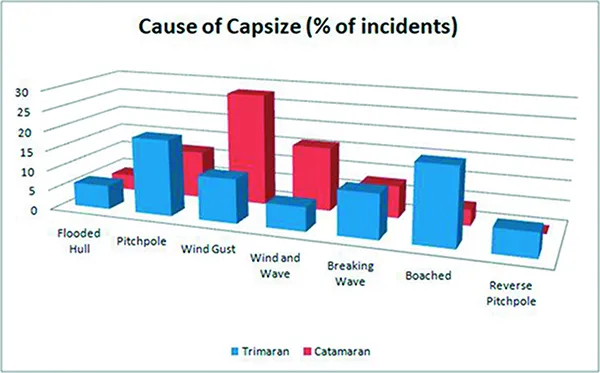
Trimarans have greater beam than catamarans, making them considerably more resistant to capsize by wind alone, whether gusts or sustained wind. They heel sooner and more than catamaran, giving more warning that they are over powered.
Waves are a different matter. The amas are generally much finer, designed for low resistance when sailing deeply immersed to windward. As a result, trimarans are more susceptible to broach and capsize when broad reaching at high speed or when caught on the beam by a large breaking wave.
In the first case, the boat is sailing fast and overtaking waves. You surf down a nice steep one, into the backside of the next one, the ama buries up to the beam and the boat slows down. The apparent wind increases, the following wave lifts the transom, and the boat slews into a broach. If all sail is instantly eased, the boat will generally come back down, even from scary levels of heel, but not always.
In the second case a large wave breaks under the boat, pulling the leeward ama down and rolling the boat. Catamarans, on the other hand, are more likely to slide sideways when hit by a breaking wave, particularly if the keels are shallow (or raised in the case of daggerboards), because the hulls are too big to be forced under. They simply get dragged to leeward, alerting the crew that it is time to start bearing off the wind.
Another place the numbers leave us short is ama design. In the 70s and 80s, most catamarans were designed with considerable flare in the bow, like other boats of the period. This will keep the bow from burying, right? Nope. When a hull is skinny it can always be driven through a wave, and wide flare causes a rapid increase in drag once submerged, causing the boat to slow and possibly pitchpole.
Hobie Cat sailors know this well. More modern designs either eliminate or minimize this flare, making for more predictable behavior in rough conditions. A classic case is the evolution of Ian Farrier’s designs from bows that flare above the waterline to a wave-piercing shape with little flare, no deck flange, increased forward volume, and reduced rocker (see photos page 18). After more than two decades of designing multihulls, Farrier saw clear advantages of the new bow form. The F-22 is a little faster, but more importantly, it is less prone to broach or pitchpole, allowing it to be driven harder.
Beam and Stability
The stability index goes up with beam. Why isn’t more beam always better? Because as beam increases, a pitchpole off the wind becomes more likely, both under sail and under bare poles. (The optimum length-to-beam ratios is 1.7:1 – 2.2:1 for cats and 1.2:1-1.8:1 for trimarans.) Again, hull shape and buoyancy also play critical roles in averting a pitchpole, so beam alone shouldn’t be regarded as a determining factor.
Drogues and Chutes
While monohull sailors circle the globe without ever needing their drogues and sea anchors, multihulls are more likely to use them. In part, this is because strategies such as heaving to and lying a hull don’t work for multihulls. Moderate beam seas cause an uncomfortable snap-roll, and sailing or laying ahull in a multihull is poor seamanship in beam seas.
Fortunately, drogues work better with multihulls. The boats are lighter, reducing loads. They rise over the waves, like a raft. Dangerous surfing, and the risk of pitchpole and broach that comes with it, is eliminated. There’s no deep keel to trip over to the side and the broad beam increases the lever arm, reducing yawing to a bare minimum.
Speed-limiting drogues are often used by delivery skippers simply to ease the motion and take some work off the autopilot. By keeping her head down, a wind-only capsize becomes extremely unlikely, and rolling stops, making for an easy ride. A properly sized drogue will keep her moving at 4-6 knots, but will not allow surfing, and by extension, pitch poling.
For more information on speed limiting drogues, see “ How Much Drag is a Drogue? ” PS , September 2016.
- Privacy Policy
- Do Not Sell My Personal Information
- Online Account Activation
- Privacy Manager
Yachting World
- Digital Edition

Catamaran Sailing Techniques Part 7: should the worst happen – with Nigel Irens
- Belinda Bird
- October 1, 2015
Capsize is very unlikely in most modern catamarans, but should the worst happen it is as well to be prepared, says Nigel Irens
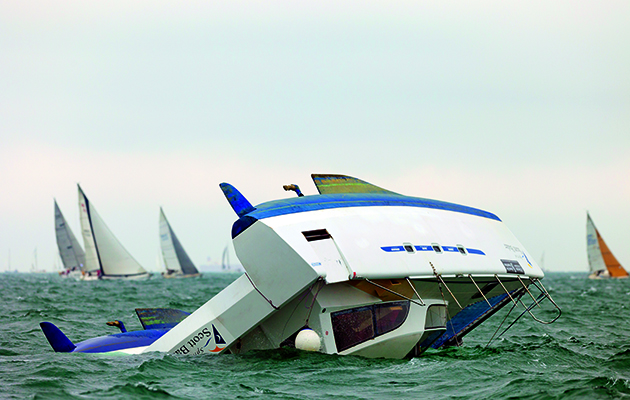
Photo: David Harding

The first thing to say is that as a general rule floating home-type catamarans are, in principle, less likely to be at risk than those designed with performance in mind.
That said, before making such a sweeping statement it’s important to mention that the level of risk involved is much more about the skill and experience of the skipper than about the qualities of the boat on which he or she goes to sea.
Over the years buyers of catamarans have tended to go more and more for the model with enhanced accommodation space (and de facto diminished performance). The bottom line is that in sailing on most ‘charter spec’ catamarans you’d have to be trying hard to win a bet to bring about a capsize.
Building catamarans down to a budget often seems to result in under-sizing of deck gear so that powering up the rig is not really possible. This really is not intended as a criticism – just a reflection on the real-life economics of this market.
If these factors combine make such a catamaran very hard to capsize then this could surely be perceived as a positive result.
Once the discussion turns from the prevention of capsize to the reality of it information and advice is not readily available. There are two different areas that need to be addressed.
The first is about actually surviving the incident in the short term. The second assumes you have managed to do that and is about surviving life on an upturned boat while summoning some help as soon as possible.
Rule one is that if you are on the inside of the boat you should immediately get away from the bridgedeck and head for one or other of the hulls as fast as possible. That’s easier said than done because you’ll be disorientated – especially if it’s dark outside and any lights inside won’t last long.
At the very least if sailing in challenging conditions (especially on a performance boat) it makes sense to bed down between watches in a hull rather than in the central saloon.

Not likely in a cruising cat!
The reasoning is that the boat is unlikely to be supported by the roof for very long when inverted and as she settles down in the water the bridgedeck will soon be close to the water, making an exit attempt risky – especially if there are warps washing around the cockpit.
Stay below if possible
As the hulls themselves are by definition watertight the boat will be buoyant enough to float with (at worst) the threshold of the companionways into the hulls at the surface.
It’s important not to rush for the escape hatch (fitted to the inboard side of each hull) because, although it provides a useful source of light, opening it will let some of the air that’s supporting the boat out of the hull, causing it to float lower in the water.
It is probably best to wait and take stock of the situation – together with anyone else who is in the same hull – and maybe wait for daylight if the capsize has happened at night. Try to find out if others are outside – or perhaps in the other hull.
If, on balance, the decision is taken to leave the hull then it is important to make a plan that results in the hatch being open for as short a time as possible.

Catamaran escape hatch
Clearly if the level of seawater inside the hull is high it is not going to provide a suitable environment for survival while waiting for assistance, so exit is the only option. If on the other hand it is only knee deep then the hull may be the place to stay.
Once again good planning for the worst before going to sea is the way to go and there is plenty of information available about that.
Discussion and planning
As part of the preparation for these dire circumstances it is important to have had a frank discussion about this whole scenario with the supplier of the boat. Has anyone ever capsized this particular design before, and what was learned from that?
Comparing the relative dangers of being at sea in a catamaran that could capsize with those of being in a monohull that could sink has always been a source of lively debate.
The truth is that there are now (and there have always been) risks in going to sea in any vessel. Our best hope in minimising that risk is to face the subject full-on and become as well informed as possible.
Man overboard
While discussing safety issues in the context of catamaran sailing we should take a brief look at that other seafarer’s nightmare – losing a man overboard.
All the normal recovery procedures apply to a catamaran with regard to the all-important location of the casualty, but there are some important differences in the way the approach is made for the recovery.
Because of the high windage of a catamaran and relatively small amount of lateral resistance under the water you can assume that, as you slow the boat down to attempt the pick-up, you’ll make a huge amount of leeway. As a result if you approach to windward of the casualty there is a real danger that the casualty’s legs will be carried under the leeward hull – with a real risk of serious injury from the propeller.

Because of high windage it can be a problem approaching a casualty in the water
To be absolutely safe from this peril just keep to leeward of the casualty. Of course this means that, despite you best efforts, you could pass too far to leeward and won’t be able to get a line to them.
A good way to avoid this problem is to motor at maybe two to three knots across the wind trailing a long line behind the boat (from the leeward stern). You should aim to pass at least 10m to windward of the casualty – which should be easy to judge because you have enough speed to have good steerage way.
Because the casualty will need to hang onto this line it should be easy in the hands – a 14-16mm 8 plait nylon mooring line or similar would be ideal.
When the casualty is directly to leeward of you turn sharply downwind, making a 180° turn that leaves you passing safely to leeward. Slow down at this point, being careful not actually to go astern and risk getting the line around the leeward propeller.
If all goes well the bight of the rope will now be encircling the casualty and at some point he or she will be able to grab hold of it.
From now on you shouldn’t need to engage the drive to either propeller. Keep the helm to leeward and the boat should lie with the wind somewhere on the quarter. If you’re moving too fast – making things difficult for the casualty – you could transfer the line to the bow so that the drag of towing will tend to make the boat round up somewhat – you should be able to control the angle at which the boat lies to the wind by moving the attachment point of the rescue line to different points along the sheer.
If all goes according to plan you should be able to haul the casualty in to the windward quarter of the boat, where they can use the emergency boarding ladder.
If they are not up to that then it should be possible to pass them another rope with a bight in the end of it big enough for them to pass it over their shoulders and under their arms so that they can be hauled aboard.
Do’s and don’ts
- DO take positive action to wise up on the risk of capsize on the catamaran you sail. Asking difficult questions of boat suppliers and collecting opinions from other owners are all valid.
- DO develop some kind of basic plan for the worst case – such as impressing on crew that if below in high-risk conditions then being in the hulls is much safer than being on the bridgedeck. In the case of a man overboard do always make the pick-up from a position downwind of the casualty.
- DON’T take the word of some designer who’s never capsized as gospel – ferret around online and find out what conclusions people who have actually been there have drawn from their experience.
- DON’T risk sailing in bad weather until you have plenty of experience with the boat in more moderate conditions.
- DON’T even think of steering by autopilot when in potentially dangerous conditions. Many accounts of capsize reveal that there was no one on the helm at the critical moment.
- DON’T make a meal of all this. Capsize is very unlikely in most cruising catamarans, but it does happen occasionally so, as with most seamanship issues, the smart move is to be on top of the subject and prepared for the worst.
Our eight-part Catamaran Sailing Skills series by Nigel Irens, in association with Pantaenius , is essential reading for anyone considering a catamaran after being more familiar with handling a monohull.
Part 8: the future of catamaran cruising
Series author: Nigel Irens
One name stands out when you think of multihull design: the British designer Nigel Irens.
His career began when he studied Boatyard Management at what is now Solent University before opening a sailing school in Bristol and later moving to a multihull yard. He and a friend, Mark Pridie, won their class in the 1978 Round Britain race in a salvaged Dick Newick-designed 31-footer. Later, in 1985, he won the Round Britain Race with Tony Bullimore with whom he was jointly awarded Yachtsman of the Year.
His first major design success came in 1984 when his 80ft LOA catamaran Formule Tag set a new 24-hour run, clocking 518 miles. During the 1990s it was his designs that were dominant on the racecourse: Mike Birch’s Fujicolour , Philippe Poupon’s Fleury Michon VIII , Tony Bullimore’s Apricot . Most famous of all was Ellen MacArthur’s 75ft trimaran B&Q, which beat the solo round the world record in 2005.
His designs have included cruising and racing boats, powerboats and monohulls, but it is multis he is best known for.
See the full series here
A special thanks to The Moorings, which supplied a 4800 cat out of their base in Tortola, BVI. www.moorings.com
If you enjoyed this….
Yachting World is the foremost international magazine for bluewater cruisers and offshore sailors. Every month we have practical features to help you plan and prepare to realise your sailing dreams. Build your knowledge month by month with a subscription delivered to your door – and at a discount to the cover price. S ee our latest offers now.
Yachting Monthly
- Digital edition

Confident catamaran handling: how to master multihulls
- Katy Stickland
- July 3, 2020
Gavin Le Sueur shows Yachting Monthly how to step on board a catamaran for the first time with confidence

The Nautitech 40 Open, despite aimed at the cruising market, places an emphasis on performance and speed
It’s official: this year, for the first time ever, yacht charter holiday businesses ordered more catamarans for their fleets than monohulls, writes Gavin Le Sueur.
Capable of creeping into the shallowest of anchorages, sailing flat and fast, while being incomparably spacious, catamarans win the numbers game hands down and are the choice of many sailors looking for a perfect charter abroad.
Still, for even the most experienced monohull sailor, taking command of two hulls and two engines can seem a tall order.
No need for trepidation though. The wind and sea remain the same. The theory of sailing is unaltered.
What does change when sailing a multihull are the handling characteristics and some basic seamanship rules.
These changes are the result of using beam rather than ballast for stability.

Stepping ashore at the stern is the only option in this situation. This changes how coming alongside manoeuvres are conducted
Inherent in this is a lighter, more stable platform that accelerates quickly and has higher windage and different motion.
Seamanship is an evolving knowledge base.
Just when we think everything is as good as it can get and there’s no need for innovation, along comes a new idea that we eventually feel is essential.
From a design viewpoint, for instance, there are now production cruising cats being foil assisted to reduce wetted surface area and drag.
Materials tech also keeps changing the goalposts for multihulls.
As they get lighter and stronger, follow-on changes occur in beam and rig styles.
Multihulls come in all shapes and sizes.
Good seamanship requires knowledge of the theory behind sailing a multihull and understanding the characteristics of the specific design you are sailing.
Like all yachts, each multihull model has its own quirks.
This article provides an outline of some of the features you should be aware of when chartering a catamaran for the first time.
This knowledge base will also be of use to those sailing and anchoring in company with a multihull.
Manoeuvring a catamaran in a harbour
Twin-engined catamarans have wonderful manoeuvrability.
They can turn in their own length, which is good as they usually have twice the beam (or more) of an equivalent monohull and will slip sideways in crosswind due to reduced lateral resistance and higher hull and cabin tops.
Most of the boat is out of the water.
When docking, know the crosswind and current effects and allow for them, and how quickly you will come to a stop with engines in neutral or hard astern.
Because multihulls are lighter and have a higher wetted surface area than a monohull, they have reduced momentum and will generally pull up quicker.

Ensure the length of the yacht is well protected by fenders as each end will be used to exercise leverage
Twin-engine knowledge is needed to exit and enter berths.
There is little advantage in using the helm under 2 knots boat speed when you have two engines well spaced apart.
Learn to control your catamaran with engines alone at low speeds.
If both propellers rotate in the same direction, there will be an advantage docking in a specific way.
Counter-rotating engines lessen this effect.
You will be handling a much larger platform and, under you develop a feel for the size of the vessel, having crew on the bows help guide distance control.
If the multihull has daggerboards, lowering these while manoeuvring will reduce any sideways slip due to windage and increase it if your sideways movement is due to current.

Spend a little time getting used to the controls outside the marina and you’ll find that despite being big, modern cats are very responsive
Many multihulls have mini-keels and the effect on these of crosswinds and currents needs to be rehearsed before attempting a tight marina berth entry.
The stability of a multihull comes with a price: the platform is level, but the motion tends to be quicker.
There is reduced momentum and, as a result, they accelerate and stop much more quickly.
When manoeuvring, ensure the crew keeps ‘one hand for the boat’.
When sails are raised, be aware that the sheet lines are loaded immediately and wind gusts can cause rapid acceleration.
There is no heeling to spill the power.
Avoid sitting on or near loaded sheets.
Coming alongside leeward in a catamaran
1. position the boat parallel.

Position the boat parallel, with the bow angled slightly off the pontoon, aiming to bring the aft quarter alongside a cleat.
2. Let the wind bring you alongside

Control the boat’s angle while the wind pushes you on, then step ashore from the aft quarter with the sternline.
3. Use the outboard engine to hold steady

With the stemline secure, a few forward revs on the outboard engine will hold the boat in place while you secure the bow,
Coming alongside windward in a catamaran
1. line up the aft quarter with a cleat.

Instead of fighting the wind, simply aim to bring the aft quarter of the boat in line with a cleat.
Don’t worry about being parallel.
2. Secure a line and turn the boat with engine

With a short line to the pontoon, motor ahead with the outboard engine to bring the bows up into the wind.
3. Balance the power for a neat alongside

A few revs astern on the inboard engine will balance the boat to keep the aft line at 90° and the quarter clear of the pontoon.
Casting off a catamaran
1. cast off forward.

Remove the forward mooring line using the engines to hold position on the pontoon.
2. Make life easy with engines

If necessary, disengage the outboard engine to ease pressure on the remaining aft mooring line, then remove it.
3. Swing the stern out

Use the outboard engine to swing them stern out.
Stop the boat moving forward with the inboard, while the bow rests on a fender.
Taking control: Under sail
Under sail, multihulls respond to the wind quickly.
They accelerate with gusts and slow with lulls.
As a result, the apparent wind (the wind you feel) changes quickly also.
On many multihulls, it is easy to become complacent as to the true wind direction and strength.
You may appear to be pointing high and flying along when in reality, you have moved the apparent wind forward as you have accelerated and are actually laying off and losing ground to windward.
There is a sweet spot for each multihull where the sea state and wind strength combine to give you the optimum velocity made good (VMG) to windward.

Gauge how the wind is affecting you before making your final approach
This is not usually pinching hard to windward and it is also unlikely to be screaming away on a reach thinking you are tight on the breeze.
Downwind, a catamaran will outperform most similar-sized monohulls. Beware of the apparent wind in this situation.
It might be blowing 25 knots, your multihull running at 12 knots and you feel a gentle breeze.
Under spinnaker and full main, problems can quickly arise.
Although multihulls track well and tend not to broach, loss of concentration or autopilot failure can put you beam on and well overpowered.
Reef early. If you think you might need to reef, then reef.

Cruising speeds well into double figures require careful attention to the load on the rig
Better to be underpowered than overpowered, especially in unsettled or variable conditions.
A well-reefed multihull with sails well set will sail flatter and faster than one overpowered.
In downwind gusty conditions, the correct action when hit by a gust is to bear away and ease the sheets.
Never luff up as this increases the apparent wind.
By bearing away, you ease the pressure on the sails.
As soon as the gust passes, it’s time to reef .
When overpowered sailing to windward, immediately ease the traveller or mainsheet.
Be aware that the increased relative power in the headsail will want to drive the boat off the breeze.

Downwind under asymmetric, a catamaran will far outpace its monohull counterparts. Passage plan accordingly to utilise wind speeds
Round up slowly and keep control. Rapidly rounding up can stall the rudders and may worsen the capsize risk in big seas.
Spinnaker, headsail and main sheets should always be secured in a quick-release cleat.
A self-tailing winch or a cleat requiring tension to be taken to release is not quick release.
Never leave a winch handle in the winch as a released sheetline can easily foul on this.
Many multihull capsizes are a result of a series of issues – a squall, overpowered rig, inability to quick release, turning the wrong way to depower.
On a cruising catamaran these are reduced, but good seamanship dictates an awareness of what to do when the unexpected occurs.
Avoid getting caught ‘in irons’
Although not unique to multihulls, getting caught ‘in irons’ is a common problem.
‘In irons’ is the state of stalling when your multihull has pointed too high into the wind or lost momentum through a tack and all forward motion is lost.
It is possible to sail or drift backwards on a multihull with considerable skill.
To get out of irons, release the headsail and push the rudder over to the opposite side you would if going forward.
The multihull will drift backwards and around on to the tack required.
As soon as the bow falls away and the mainsail has wind on the windward side, sheet in the headsail, correct the helm and only sheet in the main once you are progressing forward.
Most cruising catamarans will generally have a conservative rig and minikeels.
Due to their higher windage, reduced momentum and increased hull surface area, sailing to windward requires a different skill set than on a monohull.
First of all, don’t try to point as high as the monohull you are used to sailing.

Modern catamarans rarely get stuck in irons. Maintaining power and speed through tacks, particularly in a seaway, will normally stop the boat from staling
Lay off and go for a bit of speed.
You have less weight so will generally go faster, albeit it further off the wind.
Doing this in practice, the velocity made good equation will work out in your favour.
Sailing to windward is about making the best speed toward your destination.
You might cover more ground but will generally arrive relaxed and at the same time (or earlier).
If the sea state is choppy and you are pounding into it, lay off a bit, power up the sails and punch forward.
The sea state can stall a cruising multihull quicker due to their reduced momentum.
Use the sails to maintain drive.
1. Get sailing

Putting the wind just off the bow and dropping the sail on to the coachroof makes for a trouble-free hoist clear of crew.
2. Aim for boat speed

Having raised the main and unfurled the job, bear away.
Aim for boat speed before getting closer to the wind.
3. Use beam to shape sails

The extra-wide traveller track can be used in place of a kicking strap to put more shape in the sail on a catamaran.
4. Use your instruments

Use the yacht’s instruments to track velocity made good, as well as true and apparent wind speeds.
Cats sailing flat sail faster. Avoid becoming overpowered and always reef early.
5. Avoid overpowering

Keep an eye on your leeward shroud if it’s very loose.
Consider whether you might be overpowered and if it’s putting too much strain on your rig.
Daggerboards and their effective use
Daggerboards increase the lateral resistance and assist in tracking and sailing to windward more effectively.
To adjust boards when sailing you may need to ‘unload’ them – jiggle the helm, partially round up and bear away quickly or adjust them when tacking.
On catamarans, when sailing to windward in light to moderate conditions have the centreboards fully down.
In very light winds have only one centreboard down to reduce the wetted surface area.
Continues below…

Get ready for your yacht charter holiday
Getting to grips with a few skills and checking your boat carefully will give you a more enjoyable yacht charter…

How to plan the perfect charter holiday
Whether you own your own boat or not, chartering offers the opportunity to sail somewhere different without complication. Will Bruton…

Multihull anchoring and mooring buoys
Handling a catamaran in manoeuvres can sometimes be easier than with a monohull, but there are a few surprising differences.…
To windward in heavy conditions, partially retract the boards, starting with the leeward board.
When sailing downwind the centreboards should be adjusted to balance the helm.
When broad reaching this usually means the windward board is half down and the leeward board nearly fully up.
A small amount of board down will improve downwind steering.
In storm conditions consider the tripping effect of increased lateral resistance and adjust the boards accordingly.
Remember to retract your boards when coming into shallow water!
Not all multihulls are the same.
A trimaran generally has a wider beam, single engine and rudder, and less internal space.
They heel a bit more and are usually better windward performers.

Trimarans generally have one engine. Credit: Emil Landry
Their wide hull windage is often less, and many have a central daggerboard which aids manoeuvrability and reduces lateral slide.
A trimaran will often be quicker to respond to the helm, and as they are proportionally lighter, will accelerate faster.
This is, of course, a generalisation as there are full bridge deck cruising trimarans with the internal volume and weight of a cruising catamaran.
Trimarans, like a single-engined yachts, require knowledge to the effect of the water flow over the rudder from the propeller when undertaking tight manoeuvring.

Further reading
Multihull Seamanship by Gavin Le Sueur (Fernhurst, £14.99)
After 22 years and five reprints, Multihull Seamanship has undergone a full rewrite to update the many changes that have come with further experience and design advances.
This book is an A-Z of skills for catamarans and trimarans, cruising and racing.
Dr Gavin Le Sueur is a lifelong multihull sailor with experience racing and cruising the seven multihulls he has owned.
He has survived cyclones and capsize, raced two-handed around Australia and cruised throughout the Pacific and Asia with his wife Catherine and their three children.

TRIMARAN VS CATAMARAN
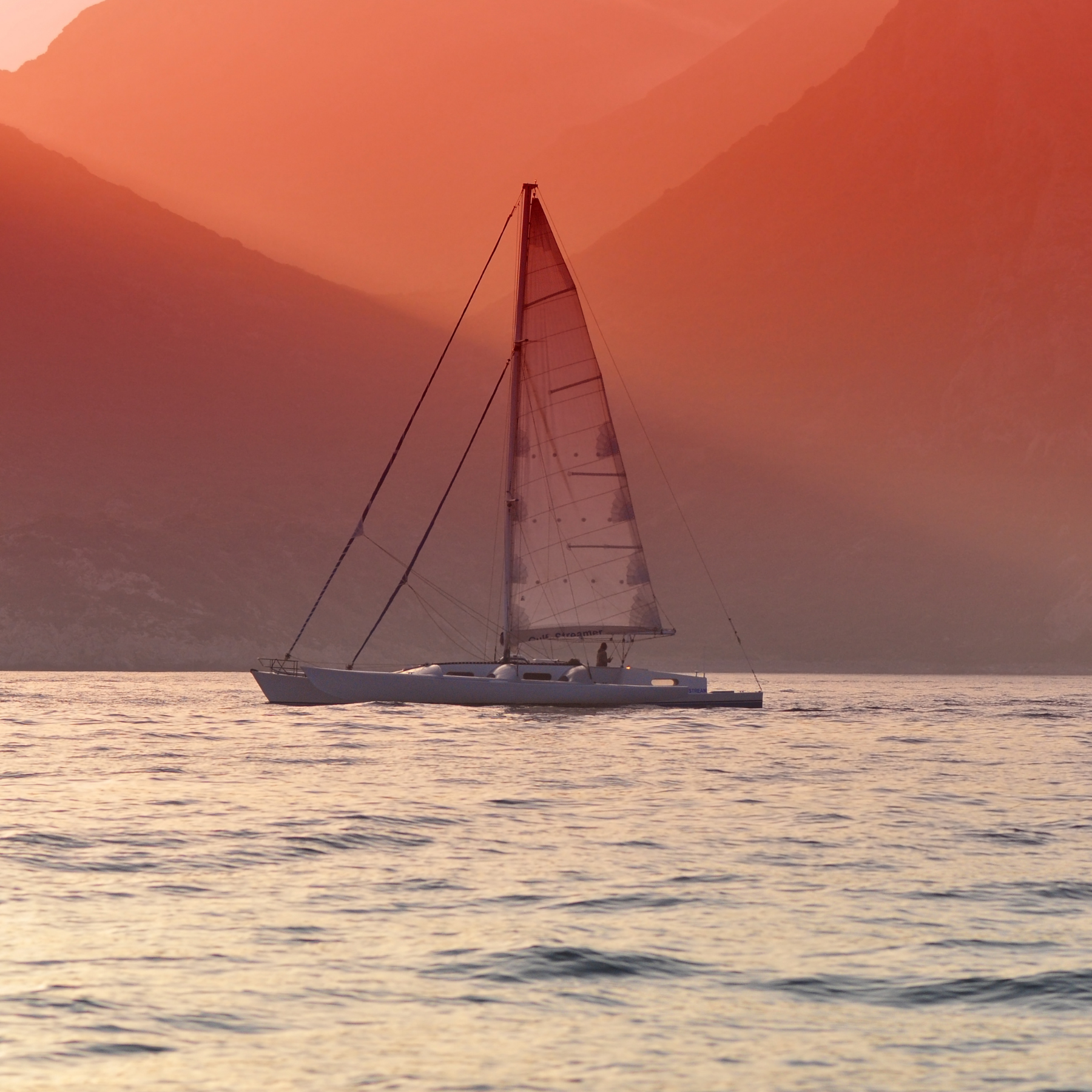
Trimarans and catamarans have a unique appeal. They are stable, fast, and comfortable. Yet, it can be hard to choose between these kinds of vessels, if you have the budget to charter or buy either.
In this article, we delve into the trimaran vs catamaran debate to establish the pros and cons of both. But first, let’s look at the key differences between them.
What are the differences between trimarans and catamarans?
A trimaran has one main, larger hull flanked by two smaller “floats”, connected by lateral beams. It’s rigged similarly to a monohull and heels. The extra hull offers less hydrodynamic resistance, which makes a trimaran faster.
Catamarans have two equal-sized parallel hulls; their wide beams offer stability. That’s why cats don’t heel.
Catamarans have become extremely popular over the past decades, especially once bigger, more comfortable models have been produced since the 90s. So much so, that there’s a rather long waiting list to get a new one built. Charter companies are purchasing more and more cruising cats to add to their fleets and many cruisers choose a cat over a monohull when they set sail on a long voyage.
Trimarans have been associated with racing only, until recently. However, new and rather spacious recreational models are slowly emerging. Finding a cruising trimaran to charter is still hard, though.
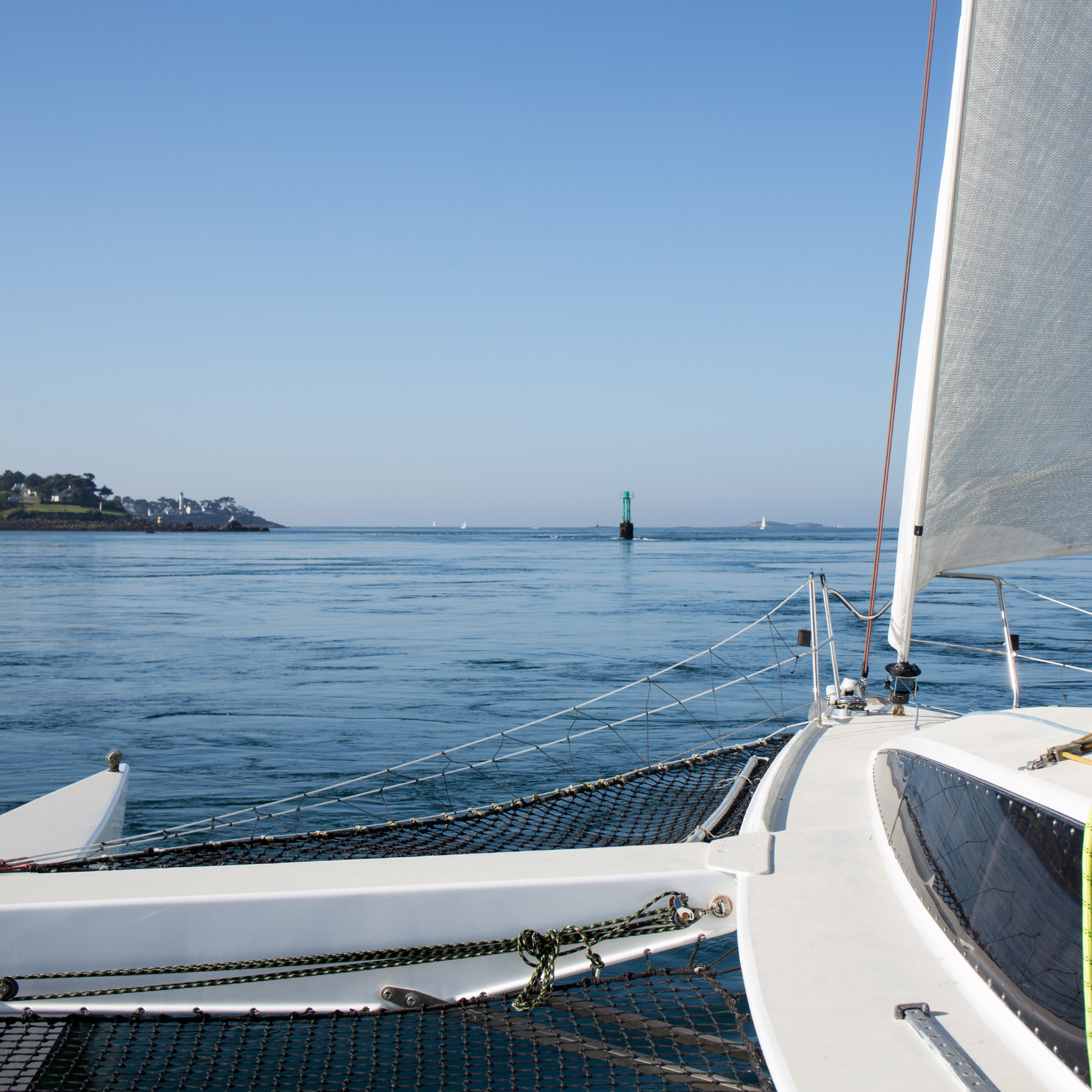
Can a trimaran capsize?
In theory, in extreme conditions, if a wave is higher than half the beam size of the boat, a trimaran can capsize. However, trimarans are rather wide vessels and their three-hull configuration makes them very stable.
A trimaran has a maximum righting moment of 27 degrees of heel, while a catamaran has a 12 degree one. Such a shorter angle can be reached in short seas, if the wind gusts are powerful enough and you haven’t reefed.
So capsizing a trimaran is extremely hard. Plus, if a trimaran flips over, it is virtually unsinkable, thanks to the three hulls. This extra safety element has led to trimarans becoming more popular than catamarans in the racing world.
Is a trimaran safer than a catamaran?
To a small extent. As we have seen above, it’s very difficult to sink a trimaran. The same goes for cats. However, trimarans have the added bonus of being harder to flip over, too.
Get the free DECKEE boating app
DECKEE helps you plan, prepare and explore the waterways with confidence.
Download app
Pros and cons of Trimarans
Let’s look at the advantages and disadvantages of trimaran sailboats.
Trimarans are very fast, typically faster than both cruising and racing catamarans
They can sail in nearly any wind conditions
Trimarans are extra stable and hard to flip over
The heeling allows you to understand when it’s time to reef
Trimarans perform better upwind than cats
The helm offers great feedback, just like on a monohull
The anchoring gear is easier to deploy, as it’s installed on the main hull.
Sailing a trimaran takes quite a bit of work on deck
They heel, making it harder to cook underway
Trimarans can be harder to maneuvre inside a marina
The space on board is typically less than on most cats
Trimarans are very weight sensitive.
Pros and cons of catamarans
Catamarans, on the other hand, have their own pros and cons.
Cats offer a stable platform underway and at anchor
Maneuvering a catamaran is very easy
Modern, cruising cats, feature lots of room above and below deck
Catamarans don’t heel
Cruising catamarans can bear a decent amount of load.
Racing cats aren’t very spacious
Catamarans can be capsize more easily than trimarans
You need to reef more often on a cat
Any catamaran is slower than a trimaran
The helm isn’t very responsive - you need to pay close attention to the instruments.
The verdict: Trimaran or catamaran?
As always, when it comes to boats, there isn’t a “better option”. A vessel needs to be tailored to the needs and preferences of her owner.
If you prefer sailing a beautiful, spacious platform, on which to cruise leisurely and entertain many guests, a cruising catamaran may be the choice for you. You won’t need to handle the lines and halyards quite as often, you won’t heel, but you will travel slower.
If, on the other hand, you enjoy the thrill of high speeds, but you’re worried about safety, a trimaran may be right for you. A recreational trimaran fitted with daggerboards or centreboards can typically sail faster than a catamaran and perform better upwind.
A performance cat may be a great option for those who need to get in and out of marinas often but want to sail fast. And if you want the fastest, most fun boat to sail, opt for a racing trimaran.
Whatever your priorities, a boat that’s the perfect balance between them all exists. Although, of course, you will need to take budget into consideration.
HOW TO GET SAILING EXPERIENCE
How to prepare for a boating trip.

Why Do Catamarans Capsize? The Facts You Need To Know
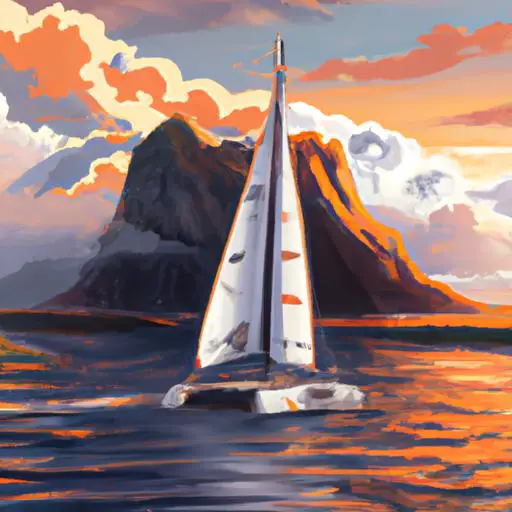
Catamarans have become increasingly popular in recent years as a fun and safe way to explore the waters around you.
But what happens if a catamaran tips over? What are the causes and safety tips to avoid it? In this article, we’ll explore why catamarans are more prone to capsizing than other boats, what can cause them to capsize, and what you should do if your catamaran tips over.
We’ll also discuss what to do if your catamaran capsizes and how to right it if possible.
So, if you’re looking to stay safe while sailing your catamaran, this article is for you!
Table of Contents
Short Answer
Catamarans can capsize due to a variety of reasons, including strong winds, large waves, and imbalance.
When a catamaran is caught in a gust of wind, the increased wind pressure on one side of the catamaran can cause it to lean to one side, which can lead to a capsize if not corrected.
Additionally, if the catamaran is not balanced properly, with too much weight on one side of the boat, it can easily capsize.
Lastly, large waves can easily cause the boat to roll, leading to a capsize.
The Design of Catamarans
Catamarans are two-hulled watercraft, which makes them inherently more susceptible to instability and capsize than more traditional vessels.
This is due to their wide-hulled design, which makes it easier for the boat to become unbalanced.
The two separate hulls also make them more difficult to steer, as the hulls act like two sails and can push the boat in unintended directions.
Additionally, catamarans have less buoyancy, making them more likely to capsize if they are overloaded with cargo.
The sails of a catamaran can also contribute to the likelihood of a capsize.
As the wind increases, the sails can act as a sail, pushing the boat over.
If the sails are not managed correctly, they can push the boat too far, resulting in a capsize.
Finally, large waves can cause a catamaran to become unstable and eventually capsize.
The wide-hulled design of catamarans makes them more vulnerable to waves, as the two hulls can move independently and cause the boat to become unbalanced.
Additionally, the asymmetrical shape of catamarans makes them more likely to flip over in high waves, as the force of the waves can push the boat in one direction and cause it to overturn.
Overall, catamarans are inherently more unstable than other types of vessels due to their wide-hulled design, and they can easily become unbalanced if improperly loaded with cargo.
Additionally, excessive wind can cause the sails of a catamaran to act as a sail, pushing it over and causing it to capsize.
Lastly, large waves can cause a catamaran to become unstable and eventually capsize.
For these reasons, it is important for catamaran owners to understand why catamarans can capsize and take the necessary precautions to prevent it.
Improper Loading Can Lead to Catamaran Capsizing

When it comes to catamarans, proper loading is key to staying afloat.
A catamaran is inherently more unstable than other types of vessels due to their wide-hulled design, and they can easily become unbalanced if improperly loaded with cargo.
This can cause the vessel to become unstable and eventually capsize.
To avoid this, it is important to ensure the catamaran is loaded correctly and that the weight is evenly distributed across the two hulls.
When loading a catamaran, it is important to consider the size, shape, and weight of the items being loaded.
It is also important to be aware of the catamarans overall weight capacity.
Overloading the vessel or having an unevenly distributed load can cause the catamaran to become off-balance, leading to dangerous and potentially life-threatening situations.
It is also important to be aware of the center of gravity when loading a catamaran.
Cargo should be distributed in such a way that the center of gravity remains low and the catamaran remains stable.
This will allow the vessel to handle waves and wind more effectively and reduce the risk of capsizing.
When loading a catamaran, it is important to be aware of the risks associated with improper loading.
Taking the time to properly load the vessel and ensure the weight is evenly distributed can help reduce the risk of capsizing and keep passengers and crew safe.
Wind Can Cause Catamarans to Capsize
When it comes to why catamarans capsize, strong winds are a major factor.
This is because catamarans are inherently more unstable than other types of vessels due to their wide-hulled design.
The wide hulls can act as sails, catching the wind and pushing the boat over.
This is especially true if the catamaran is not properly loaded, as excessive wind can quickly create an imbalance and cause it to capsize.
Additionally, strong winds can cause the sails of a catamaran to act as a sail, pushing it over and causing it to capsize.
This can be especially dangerous if the sails are not properly trimmed, as the wind can catch them and cause the catamaran to lose its balance.
Furthermore, if a catamaran is not equipped with good quality sails and rigging, they can easily break or tear in high winds, making it more difficult to control the vessel and leading to a possible capsize.
In order to prevent a catamaran from capsizing due to wind, it is important to always be aware of the current weather conditions and adjust the sails and rigging accordingly.
It is also important to make sure the catamaran is properly loaded and balanced, as an imbalance can quickly lead to capsize.
Finally, it is important to use quality sails and rigging, as they will be more resistant to strong winds and will help to keep the catamaran under control.
Large Waves Can Cause Catamarans to Capsize

When it comes to catamarans, large waves can be one of the main causes of capsizing.
This is due to the unique design of catamarans, which have two hulls connected by a platform.
This wide-hulled design gives catamarans more surface area than other types of vessels, making them inherently less stable.
While this can make them great for cruising in calm waters, it can also make them vulnerable to the effects of large waves.
When a large wave hits a catamaran, it can cause the vessel to become unbalanced.
This is because the wave can push one hull up while the other remains in the water.
This can create an imbalance in the catamarans center of gravity, causing it to become unstable and eventually capsize.
In addition to the effects of large waves, catamarans can also become unbalanced if they are improperly loaded with cargo.
As with any vessel, it is important to ensure that the catamaran is properly loaded so that it is not too top heavy.
If the vessel is carrying too much weight on one side, it can become unbalanced and be prone to capsizing.
Finally, excessive wind can also cause a catamaran to become unstable and eventually capsize.
Catamarans can act like a sail when the sails are open, and the wind can push the vessel over if it is not properly secured.
Its important to always make sure that the sails are properly secured and the catamaran is not exposed to excessive winds.
In conclusion, catamarans can capsize for a variety of reasons, such as strong winds, waves, and improper loading.
It is important to be aware of these potential dangers when operating a catamaran, and always take the necessary precautions to ensure the safety of the vessel and its occupants.
Safety Tips to Avoid Catamaran Capsizing
When it comes to owning and operating a catamaran, safety should always be your top priority.
While catamarans are inherently more unstable than other types of vessels, there are several steps you can take to help prevent your vessel from capsizing.
First, make sure your catamaran is properly loaded.
This means that the weight should be evenly distributed between the two hulls so as to maintain a balanced vessel.
Additionally, any heavy items should be secured in place to prevent them from shifting during travel.
Second, take caution when sailing in high winds or waves.
Catamarans are particularly vulnerable to strong winds and large waves, as the sails can act as a sail and push the vessel over.
If you are sailing in these conditions, make sure to keep the sails close-hauled and lower the mast to reduce wind resistance.
Additionally, try to stay away from large waves and steer into them instead of away to reduce the risk of capsizing.
Third, make sure all safety equipment is in working order.
This includes life jackets, flares, and other essential items that can be used in the event of an emergency.
Additionally, make sure that everyone on board is aware of the safety procedures and understands how to respond in case of a capsize.
By following these safety tips, you can help ensure that your catamaran remains upright and that everyone on board remains safe.
While capsizing can happen for a variety of reasons, it is important to take the necessary steps to prevent it from happening in the first place.
How to React if Your Catamaran Is Capsizing

If you find yourself in a situation where you think that your catamaran is capsizing, the most important thing to do is remain calm.
It is tempting to panic, but if you panic, you may make it harder to react in a way that can help save your vessel.
It is also important to remember that catamarans can capsize in a matter of seconds, so it is important to act quickly.
The first step you should take is to lower the sails and turn off the engine.
This will help reduce the wind pressure on the hull and the risk of the catamaran tipping over.
Next, make sure that everyone on board is wearing life jackets and has access to a floatation device.
If possible, move to the center of the boat, as this is the safest spot in case of a capsize.
If the catamaran begins to capsize, dont jump off the boat.
Instead, grab onto something solid to help keep your balance and wait for the boat to right itself.
If the boat doesnt right itself, assess the situation for any potential hazards such as rocks or logs that may be in the water.
If the boat is still in danger of capsizing, it is best to abandon ship and get to safety.
It is important to remember that catamarans can capsize in a matter of seconds, so being prepared and knowing what to do when it happens can help keep everyone safe.
It is also important to make sure that the catamaran is properly loaded, that its sail settings are appropriate for the wind conditions, and that everyone on board is wearing a life jacket in case of a capsize.
By following these tips, you can help ensure a safe and enjoyable outing on your catamaran.
Is It Possible To Right a Capsized Catamaran?
In most cases, it is possible to right a capsized catamaran.
However, the difficulty of the task depends on the size and shape of the vessel, as well as the conditions in which it capsized.
If the catamaran is small enough, it may be possible to right it by hand, but larger vessels may need to be righted with the help of a crane or other lifting device.
Additionally, the crew must take into account the weather conditions when attempting to right a capsized catamaran.
High winds can make the task more difficult, as they can push the vessel further away from the shore.
If the catamaran can be righted, the next step is to assess the damage and determine if the vessel can be safely sailed.
If the catamaran is severely damaged, the crew may need to abandon it or seek assistance from a towboat or other vessel.
If the damage is minor, the crew may be able to repair the vessel and continue sailing.
It is important to note that if a catamaran is righted, it is still vulnerable to capsizing again if it is not properly loaded or if the weather conditions are too severe.
Therefore, it is important for the crew to take all necessary precautions to ensure that the vessel is properly loaded and that the crew is aware of the conditions before continuing on their voyage.
Final Thoughts
It’s important to understand the risks associated with owning and operating a catamaran.
By taking the necessary precautions, such as proper loading, avoiding high winds and waves, and having the right safety equipment on board, you can ensure that your catamaran remains stable and you stay safe while on the water.
If you find yourself in a situation where your catamaran is capsizing, react quickly and take the proper steps to right the vessel.
With the right knowledge and preparation, you can enjoy your time on the water without worrying about a potential capsizing.
James Frami
At the age of 15, he and four other friends from his neighborhood constructed their first boat. He has been sailing for almost 30 years and has a wealth of knowledge that he wants to share with others.
Recent Posts
Does Your Boat License Expire? Here's What You Need to Know
Are you a boat owner looking to stay up-to-date on your license requirements? If so, youve come to the right place! In this article, well cover everything you need to know about boat license...
How to Put Skins on Your Boat in Sea of Thieves? (Complete Guide)
There is a unique sense of pride and accomplishment when you show off a boat you customized to your exact specifications. With Sea of Thieves, you can customize your boat to make it look like your...

My Cruiser Life Magazine
Battle of the Multihulls – Catamarans Versus Trimarans
For years, catamarans have dominated the multihull segment. Cruisers love to live aboard and sail the world on sailing catamarans. These two-hull boats are known for their speed, space, and overall attractiveness.
With their sporty three hulls, trimarans have long been regarded as fantastic race boats that will speed past catamarans and monohulls. Trimarans have stability and are comfortable at sea. Today’s modern trimarans, such as the Neel brand trimarans, are now featuring increased living space. As a result, modern trimarans are becoming more attractive and more appealing to cruising and liveaboard sailors.
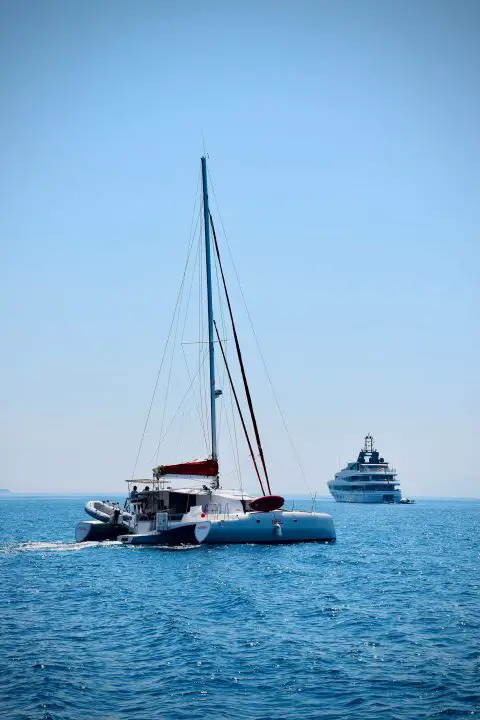
Table of Contents
Living space, catamaran vs trimaran performance, pros and cons of cruising on a monohull boat, pros and cons of cruising catamarans, pros and cons of cruising on a trimaran, multihull safety, sailing comfort, choosing between catamarans and trimarans, faqs – catamarans vs trimarans, differences of trimaran versus catamaran.
The main difference between a monohull, a catamaran, and a trimaran is the hull configuration. A monohull has just one hull. A catamaran has two hulls, and a trimaran has three hulls. The catamaran and trimaran are known as multihulls because they each have more than one hull.
A catamaran has two equally sized hulls, whereas a trimaran has one main hull with two outriggers. The two outriggers are smaller and are mirror images of each other.
The living space on a catamaran is usually luxurious compared to monohulls and trimarans. First, a large cockpit has plenty of room for guests. Second, the bridge deck, which connects the two hulls, is flat, large, and usually hosts a large living area. Third, the living area has large windows which allow excellent visibility, natural light, and ventilation. Finally, the two hulls usually house sleeping areas, bathrooms, and sometimes galleys.
On a trimaran, the living space is usually smaller than on a catamaran. The main hull is usually home to the main living quarters. Like a monohull, this space may be darker with fewer portlights. Often, the living space on a trimaran is even smaller than a comparably sized monohull. On most smaller trimarans, the outrigger hulls are kept empty or used as storage.
New, large, modern trimarans like the Neel 47 offer luxury living similar to a catamaran. On a Neel trimaran, you’ll find a large, spacious cockpit and saloon area . This area provides outdoor seating in the cockpit and an indoor lounge that rivals the comfort of home. The outriggers have space for private bunks and bathroom facilities.
The Benefits of Three Hulls
While you may give up some living space on a trimaran, there are some benefits. Trimarans are even faster than catamarans. Trimarans only have one main hull fully in the water, and the two outriggers produce less drag. As a result, trimarans have stability and are great fun to sail.
A trimaran usually has the forestay attached to the main hull. This provides a strong, stable, safe rigging platform.
A catamaran’s forestay is attached to the forward center of the boat on a crossbeam, the shrouds are attached to each hull, and there often isn’t a backstay. This catamaran rigging configuration allows for additional fatigue as the rig is being pulled in various directions.
The trimaran rigging configuration is similar to a traditional monohull. The standing rigging is connected to the center hull, thus providing increased stability and less fatigue. This configuration allows for a rigid forestay and provides good upwind performance.
When comparing trimaran and catamaran upwind performance, the trimaran usually wins. Because of the trimaran’s larger central platform and two outriggers, the trimaran pitches less when heading upwind, also known as beating. Catamarans also experience more drift while beating into the wind. So overall, trimarans experience less leeway and have better upwind performance.
Monohull boats have been around forever. As such, you can easily buy an older monohull to learn to sail on. Monohulls are inexpensive to purchase, maintain, and operate. It’s more straightforward to find marina docks and haul-out locations. When it comes to maintenance, like bottom cleaning, washing, waxing, and fiberglass work, nothing beats having a single hull!
But monohulls have much less living space than a cruising catamaran. The living space is often dark and can be called “cave-like,” as monohulls tend to have small ports.

Monohulls heel over, which is attractive to some and a deterrent to others. Some sailors feel more seasick on a monohull as it heels. On the other hand, some feel less seasick as the motion is constant, unlike a catamaran’s sometimes jerky motion underway.
Most monohulls have deeper keels than catamarans and trimarans. A shallower draft allows sailors to access shallower water. Boats with shallower keels can sneak into desirable anchorages that deeper draft boats cannot access.
Cruising catamarans have large amounts of living space and are known to be luxurious. They don’t heel over as monohulls do. Catamarans provide a stable platform for enjoying life on the water. And some sailors feel less seasick on a catamaran because of the lack of heeling motion.
Catamarans are popular with charter companies, cruisers, and sailors planning to sail around the world. Catamarans have shallow drafts and can sneak into attractive anchorages that deeper draft monohulls can’t access.
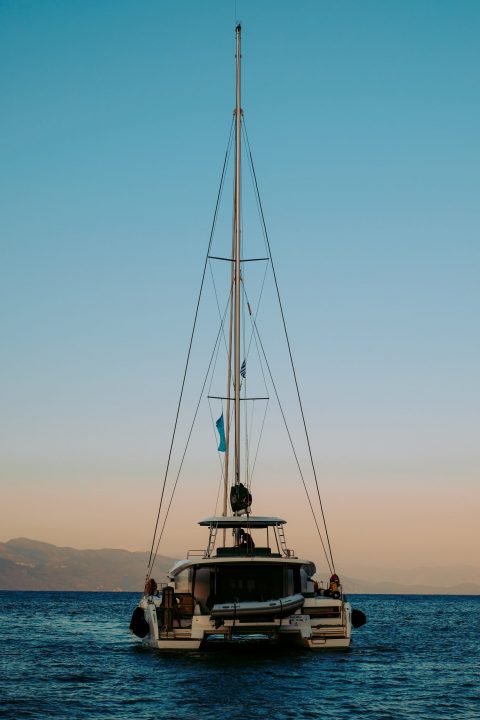
Catamarans are wider than monohulls, and it can be harder and more expensive to find marina dockage and haulouts. They don’t fit into standard-size slips and must dock in extra-wide slips or at t-heads. Many maintenance yards have standard-sized lifts that don’t accommodate the width of a catamaran. So overall, catamarans are more expensive to buy, operate, and maintain than monohull boats.
Trimarans are known for their speed! If you love to cruise past all the other boats and get to port first, a trimaran might be calling your name. Traditional trimarans have limited living space on board. Most trimarans have even less living space than similarly sized monohulls.
Maneuvering around the trimaran and living aboard can provide challenges for sailors. Like catamarans, their width can make getting dock space and haul-outs more challenging and expensive.

Cruising catamarans are usually between 18 and 25 feet wide. Cruising trimarans are usually between 25 and 30 feet wide. The additional width of a trimaran creates a more stable platform but makes finding dockage even more challenging.
Catamarans and trimarans are both considered safe vessels. While a monohull might roll, lose its rig, get holed, and sink to the bottom of the ocean, a multihull vessel will still float. This is because they do not contain lead or iron ballast.
While it is very rare, multihulls can be flipped. For instance, after Category 5 hurricanes, news outlets often share photos of flipped catamarans that were left at marinas.
However, even when a multihull is flipped, it still provides a floating platform. Boaters can wait with their large overturned vessel for help, and rescuers are more likely to spot an overturned vessel than just a small liferaft. In addition, supplies carried on the boat might still be accessible to the crew.
Cruising sailors often consider increased speed to be a safety factor. For instance, on an ocean crossing, faster speeds mean that sailors might be able to arrive before a big storm rather than getting caught in it. In addition, a faster boat might be able to adjust course and avoid the storm if outrunning it is not an option. Because trimarans are faster than both catamarans and monohulls, they can outrun or avoid more storms.
A trimaran features less roll than a catamaran. A trimaran’s weight is centered in its main hull, whereas a catamaran’s weight is distributed across both hulls. As a result, the trimaran rides smoother, whereas a catamaran will be reacting more dramatically and face a bumpier ride.

If you’re thinking about sailing on a multihull, consider the living space, speed, and sea kindliness of each. In the end, it’s a decision made from personal taste and personal preference. Trimarans are fast and fun to sail. Catamarans offer increased deck-level living space. Both are known to be safe and virtually unsinkable. Whichever choice floats your boat, you’ll be thrilled with a fun sail, comfortable ride, access to beautiful secluded anchorages in shallow waters.
Worried about getting caught in severe storm conditions in your boat ? Visit our guide!
Is a trimaran faster than a catamaran?
A trimaran is faster than a catamaran. The centered weight in the main hull provides stability. A rigid forestay provides good upwind performance. The reduction in wetted surface reduces drag. A 40-foot monohull may cruise at 6 knots, a 40 ft catamaran may cruise at 7 knots, and a 40ft trimaran may cruise at 9 knots.
Which is more stable, a catamaran or trimaran?
A trimaran has a larger maximum righting moment. Catamaran sailors must be very mindful of the wind conditions and reef sails early to prevent capsizing. The righting moment on cruising catamarans is 12 degrees, whereas the righting moment on a trimaran is 32 degrees. This means the trimaran is more stable.
In jostling rough seas, the trimaran has a smaller righting moment. As heavy seas jostle the boat, it will respond with a less choppy motion. The catamaran has a larger righting moment and will respond with a choppy ride. In a trimaran, you experience more stability. This, in turn, leads to a better-rested crew and a smoother overall ride.
All of a trimaran’s weight is centered in the main hull. In a catamaran, heavy items such as engines are located in each hull. The weight distribution on a catamaran can lead to a jerkier ride.
Can a trimaran capsize?
All boats can capsize given extreme conditions.
Many charter catamarans flipped when Hurricane Irma’s 215 mph winds hit the British Virgin Islands in 2018. The 100-foot trimaran Banque Populaire IX capsized in a gust of wind in 2018.
Multihulls are usually very stable and only encounter the risk of capsizing in severe conditions. Crews should monitor conditions and reef early to prevent overpowering the boat.
Matt has been boating around Florida for over 25 years in everything from small powerboats to large cruising catamarans. He currently lives aboard a 38-foot Cabo Rico sailboat with his wife Lucy and adventure dog Chelsea. Together, they cruise between winters in The Bahamas and summers in the Chesapeake Bay.

Farrier International
a Division of Daedalus
Mulithull Safety
The modern trimaran with its enormous stability and unsinkability is a very safe craft, and has now established an excellent safety record. They have now circled the globe many times at previously unheard of speeds, with week upon week averages of over 20 knots. However, like all modern craft, this safety is dependent on the operator and how the craft is handled and used.

Their unsinkability is now well established, with the only major hazard being capsize, and a few simple rules make this virtually impossible. Capsize is rare with well sailed cruising multihulls, but can occasionally occur with racers pushed to the limit – just like race cars. I raced and rallied cars for 5 years many years ago, and had one roll over. I have raced trimarans for over twenty five years and have never managed to roll one over.
The important factor, as with a car, is that the degree of risk is up to the driver/skipper. Drive or sail too fast for the conditions and the risk of a crash is higher. The decision is yours. It is not taken away from you by a heavy keel below, making it impossible to go fast. Nobody seriously suggests weighing down a car to prevent a roll over, nor should a sailboat be weighed down to limit performance, just because a few may not have the skill or maturity to sail a fast type of craft safely.

Thus, like a car, a multihull has the capability of very high speeds when desired, and the risk factor can consequently be higher. The choice is yours however, as it is not compulsory to go fast. There is virtually no chance that I am going to roll over the family car on the road, and similarly, there is no chance I am going to roll over a trimaran while simply cruising around.
In general, the risk factor will only begin to increase when boat speed exceeds 15 knots while reaching, or about 10 knots to windward. Thus when sailed for the conditions, or with safety in mind, and used as intended, Farrier designs are among the safest craft afloat, and better still, will never leave you fighting the elements alone.

However, the relative publicity given to multihull capsizes compared to monohull sinkings is way out of proportion, due to the unsinkable multihull stubbornly staying around to where photos can be taken, while the monohull abandons the crew and quietly sinks from sight.
One classic incident of ‘one-sided’ publicity was in the Tasman Sea in 1980, where the 40’ racing trimaran CAPTAIN BLIGH lost a float bow, but stayed upright, and the crew was eventually taken off by a liner. This was front page headline news in Australia “Four rescued off trimaran” etc. But in the same area, and in the same storm, the top line racing IOR monohull “Smackwater Jack” returning to New Zealand from the Sydney Hobart Race disappeared taking five lives. The only press coverage it ever received was four lines in the back pages stating it was missing.
This was headlining a city street fender bender, while the freeway horror smash with five dead is relegated to the back pages. Upon having this pointed out, the editor of the Brisbane paper apologized, but it was not really his fault – the news was readily available on the tri, with nothing other than a ‘missing notice’ on the mono. But the damage was done. Had CAPTAIN BLIGH sunk and lost her crew, multihulls would have been better off, or perceived as more safe, as there would have been little or no story. But because she stayed afloat and very visible, she attracted the publicity and the multihulls reputation suffered – simply by looking after the crew.
Sinking Is Not A Very Good Safety Characteristic
Sinking can be very terminal, and can result from the simplest of things, from hitting debris at sea, or even a simple malfunction in the boat. It is also far more frequent than commonly believed, as most instances just do not get reported.
AN INTERESTING STATISTIC
Meaningful comparative statistics on safety are hard to come by, but with over around 3000 Farrier designs of various types sailing there are now enough to get an idea. The capsize rate appears to be averaging around 0.2% or three or four per year for racers, whereas a rate more like 0.05% applies to cruisers.
Light aircraft make a good comparison, being another modern, fast and very comfortable ‘high tech’ form of travel. Their accidents are also very visible, well documented, and highly publicized, unlike those of the monohull which tend to disappear, without trace, and thus get much less, if any, publicity.
The current serious accident rate (resulting in death or serious injury) amongst U.S. light aircraft is 1.13% per year down from a high of 10.2% in 1948. Thus for Farrier multihulls to have an equivalent safety record as light aircraft, then we should be seeing around 22 capsizes or serious accidents a year, with the boat and crew also probably being lost as a result. It is not even close.
Not all multihulls are the same however as there are some that use huge rigs along with minimal accommodation in order to achieve high performance, and such boats will have a much higher capsize rate. The Farrier design philosophy is to always have roomy accommodation and achieve high performance by good design and efficiency, rather than brute power. All Farrier cruising designs thus have a wind capsize force of over 30 knots for safety. This is the theoretical amount of wind required to capsize the boat with full sail, sheeted in tight, and the boat at 90° to the wind. Some of the extreme boats can have a wind capsize force of less than 20 knots, which is too risky for any cruising boat.
CAPSIZE SAFETY ISSUES
Capsize is not as hazardous as sinking, but must always be considered as a possibility, even if a remote one, and be prepared for. In this regard, there should always be a special safety compartment that is accessible from both above and below for storing safety gear that will be immediately available if capsized. The following items should always be stored in this compartment, with lanyards attached, and in watertight bags:
EPIRB unit Cutting Tools Extra wrenches & tools Bolt Cutters Spare Beam Bolt Wrench Ropes VHF Hand Held Radio Pliers Flares
If an offshore design, then an emergency re-entry/escape hatch should also be fitted as standard, which will allow the crew access both in and out to the boat interior for shelter. Interior should also be setup for inverted living as per the downloadable F-41 detail sheet below.
Surge is the major enemy inside a capsized boat, and the first priority after a capsize should be to seal all hatches, vents etc. and try to keep the boat dry as possible. Pop-top on trailerables will remain in place as this will try to float upwards. Main battery switch should be turned off and all loose objects stored in the cabin settees, these now being above water. Surge will otherwise remove everything. Water level while inverted is around the bottom of the beams – float decks are only just immersed. If possible, the battery should be removed or moved higher as it will discharge under water. It should also only be a sealed unit thereby eliminating the danger of acid or gas. Check also that the watertank cannot drain if inverted, and if so, modify so that it cannot.
One now has a large, relatively comfortable life raft, and well stocked with provisions, which is much better than in a small liferaft with minimal provisions. In fact the record for the longest survival time adrift at sea is now held by the crew of a trimaran capsized off New Zealand in 1990. They were in such good condition when rescued that their story was first believed to be a hoax. The same year the offshore racing monohull GREAT EXPECTATIONS disappeared off Australia, taking 6 lives. Had the crew on this boat been on an unsinkable trimaran, then they may have survived.
RIGHTING A CAPSIZED MULTIHULL?
Righting a capsized multihull at sea, unless outside help is available, is probably not a feasible option with current technology. Best to leave the craft as it is, where the crew are safe, and await rescue. Modern satellite position indicating systems now offer very quick and easy location for a floating, but disabled multihull, whereas a sunken monohull has no such option.
When the opportunity arises, and outside assistance is available, the most successful righting system for any multihull, is to tow the capsized boat fore and aft, the tow line going to the aft end, in the form of a bridle. Which end depends on the boat, but the general rule is to choose the end that is floating highest. Thus as the boat begins to move, the lowest end, be it bows or stern, will begin to sink, and even more so as the water inside rushes forward. The boat should then flip back upright, bow over stern or visa versa.
If the above procedure does not work, then try flooding the end that needs to sink, or add some crew weight (ready to abandon ship once the end concerned starts to go under). If this fails, try towing the other direction. Some controlled flooding may also be required. Towing sideways will not work – fore and aft is the easy and only way to do it.
Another righting method, that uses the Farrier Folding System™, has been tested and shown to be workable on a Farrier designed 19′ Tramp in choppy conditions, as detailed below. It has now been used successfully to right several boats, but usually also with some outside assistance. It has not been successfully tested at sea, is not straight forward, and thus it is considered better to wait for assistance, as the righting action does tend to flood the inverted boat more. Not a good result if the righting attempt doesn’t work.
TRAMP RIGHTING EXPERIMENTS
The below photo sequence shows different stages during righting experiments with my own Tramp, after it had been deliberately capsized. Righting was proved to be possible without outside assistance, but it was difficult and special preparations are needed. Thus it is definitely not a recommended procedure offshore, but it has been used to right boats inshore (usually with some assistance). However, towing fore and aft is probably easier and quicker (as detailed above and in Sailing Manual). Offshore, it is still much safer to have the boat prepared for inverted living, with a built in safety gear emergency compartment, plus an escape/re-entry hatch, and just stay with it.
A Matter Of Safety
F-41 Catamaran Safety Aspects (downloadable PDF file)
Another Righting Test

Catamaran Vs. Trimaran (The 5 Differences)
Posted on May 30, 2022
If you’ve been on a catamaran before and you’re intrigued after hearing there are vessels with three hulls too, then you’re right. Early warning, however, is that these are two different vessels even though some of the differences aren’t obvious.
However, when it comes to catamaran and monohull, most boaters are familiar with the distinctions between the two. However, it might be hard to tell the difference between a catamaran and a trimaran since the latter’s third hull does not necessarily make an obvious difference in some functions.
They differ in anchoring, steering, accommodation, safety, and speed. Catamarans have two hulls and trimarans have three. Catamarans, on the other hand, are easier to handle at a marina and offer a higher level of comfort and space. In contrast, trimarans are very fast and more fun to sail.
Whether you’re planning to cruise on one or make a purchase, to help you decide, I’ve put together a list of the pros and cons of each option.


Catamaran Vs. Trimaran
- The hulls(#1 difference)
- Affordability and convenience
- Anchoring
We’ll look in-depth at the differences between a catamaran and a trimaran so that you can make an informed decision. First, let’s go through the different types of multihulls.

A sailing vessel having two parallel hulls is known as a catamaran . The wide beams of a cat’s paws are often used to stabilize the animal. Ballasted keels are used to stabilize monohull vessels. Displacement and hull volume of catamarans are all smaller than those of comparable-sized monohulls, as is the depth of the draught.
Catamarans date back to the 1600s when their earliest known variants appeared. Those in Tamil Nadu’s Pavaras community mostly used them for fishing, preferring them to other fishing vessels because of the added stability that the dual hulls gave. Twin-hulled boats were introduced by the British and quickly became a worldwide phenomenon.
Current Catamarans are far more advanced. There are two key ways in which they’ve grown in terms of their versatility, construction, and design.
Small Waterplane Area Twin Hulls (SWATH)
These are catamarans capable of piercing the ocean’s surface !
It is common practice to have the hulls of a SWATH catamaran underwater. As a result, they are less susceptible to the swells of the ocean, which is excellent for maintaining stability while sailing in severe waters. SWATH layouts have been utilized on rescue and research vessels in the recent past.
In contrast, their wave-piercing counterparts feature low-buoyancy bows attached to the twin hulls of their twin vessels. Catamarans with hulls that pierce waves rather than ride on top of them are faster in rough waters than SWATH catamarans. Passenger ferries, military vessels, and yachts have all recently made use of wave-piercing cat designs.

Double-outrigger trimarans are multi-hull boats that have two tiny “floats” (technically, they are outrigger hulls) on either side of the larger “float” that is joined to the larger “float” through side beams. Trimarans are extremely stable because of this design, which makes it difficult for them to capsize even in the most choppy of waters.
For centuries, the Austronesian people have used triangular-hulled fishing boats, which are currently the most frequent type of hull in Southeast Asia. There are still few warships and ferries that use double outriggers in their designs, but they are rare.
Catamarans Vs Trimarans
Because a catamaran has three separate hulls, it is distinct from a trimaran, which has two.
2. Affordability and Convenience

The shape of a cat is great for accommodating and providing comfort. You can get a large nacelle built between the two load-bearing hulls, providing additional living space . A huge cockpit and two cabins are located on either end of the boat’s hulls. This layout is ideal if you’re searching for a bit of privacy as the celebration goes on in the saloon.
Modern catamaran flybridges provide additional areas for entertaining and resting . Catamarans don’t heel much, which means that you can cook and do other things on the deck without fear. Cats can also carry a fair amount of weight, so you can stock up on food and gear if you’re going on a long trip.
Trimarans indeed have some advantages over catamarans when it comes to livability. It is difficult to perform activities like cooking onboard a boat with a dog since they tend to heel more than cats do. Catamarans, on the other hand, can handle significantly more weight. Approximately 45 feet is a good starting point (14 meters).
Trimarans, which are the same size as cats, can only carry about half the weight of a cat. Catamarans, on the other hand, offer more spacious and pleasant living quarters than trimarans.

When purchasing a boat, one of the most important considerations is how simple it is to overturn in the event of a storm. If you plan to spend more than a few hours on the water, you’ll want a boat that isn’t easily flipped or sunk because sea conditions can change quickly.
Three hulls are preferable to two when it comes to safety. A trimaran is more stable since it has one main hull and two overhangs on each side. With the side overhangs, it is less likely that the boat will turn over when it is hit by a heavy breaking wave on the side.
To further enhance stability, trimarans are constructed with the bulk of the weight concentrated on the main hull. A thorough understanding of multi-hull stability is essential for safe sailing!
What causes a catamaran to overturn?
Trimarans are designed to float even if they capsize. It also implies that a capsized trimaran will be easier to notice from the air, which might be the difference between life and death in an emergency.
Due to the widespread usage of closed-cell foam in trimarans during the past decade or so, this is the case in nearly every new model. Most trimarans can be sliced in half and still float, thanks to this type of construction.
Catamarans are more stable than monohulls, but they can’t compete with a trimaran when it comes to boat handling. If a catamaran and a trimaran were subjected to storms of equal intensity, the catamaran would be more likely to capsize than the trimaran.
Catamarans, on the other hand, are not inherently dangerous. Because they have the same closed-cell foam as a trimaran, they are nevertheless more difficult to flip over than monohulls.
While we’re talking about safety, it’s worth noting that trimarans don’t require as much attention when it comes to reefing. Catamarans have a lower heel angle, which means that most of the additional wind power is transferred to the rig, increasing speed.
To maintain a cat sailing flat, you must time your reefing carefully because the pressure on the sail practically quadruples as the wind speed doubles. Reefing a trimaran is similar, except that the boat’s modest heel offers you greater leeway in timing.
To most people who’ve ever had the opportunity to sail on one of these boats, the trimaran wins hands down. Tiller-steered trimarans, in particular, have a great reaction to the helm. They have a small heel that resembles a monohull, but the heel’s arc is restricted.
A catamaran is quite stable, but it does not roll. The thrill of sailing is enhanced by heeling, even though it’s frowned upon by those who prefer the comfort and convenience of a boat.
Trimarans combine the heel of a monohull with the stability of a catamaran thanks to their three hulls, making them the best of both worlds when it comes to sailing. If you want to practice your helming skills while having some fun, a trimaran could be a better choice.
4. Speed

Tri-hulled boats outperform their twin-hulled counterparts in speed. When it comes to speed, trimarans are often lighter than catamarans, thus they require less sail time to reach double-digit speeds. When equipped with centerboards/daggerboards, a trimaran can maintain a formidable course upwind (as is often the case for modern models).
In comparison to a monohull of the same size, a catamaran falls short of the trimaran in sheer speed. Just because tris tend to focus more on performance does not mean that catamarans are any slower.
5. Anchoring

It is easier to anchor a trimaran than a catamaran since the ground tackle can be kept in the main hull and deployed from there.
Catamarans, on the other hand, are better suited to marinas since they are more maneuverable. In addition, docking lines are handled more easily by these devices.
A catamaran is a better option than a trimaran if you need to accommodate a large group of people on board for an event like a party. However, a trimaran is an excellent choice for thrill-seekers and sailors who like to challenge themselves on every stable platform. Whichever you choose, enjoy!
- Skip to primary navigation
- Skip to main content

Bringing the second golden age of sail
We UN-Capsize A Proa!
Why is being able to un-capsize a proa such a big deal? Proas are unsinkable, right?
It’s important because we’re building an autonomous research proa (the ARC) that needs to be able to UN-capsize itself, thousands of miles out at sea during a research mission.
It’s true that well-built modern multihulls (catamarans, trimarans, and proas) ARE unsinkable.
But given big enough seas and enough wind, ANY cat, tri, or proa can capsize!
Capsize leaves you wet, cold, and exhausted, with your boat upside-down. When you capsize offshore, your boat doesn’t sink, but you’re in a life-or-death survival situation. Fire up the EPIRB (hope the battery is good), get on your survival suits, and pray.
IF you get rescued, you get to watch your boat disappear over the horizon as you leave on the rescue ship (and there’s no guarantee you WILL get rescued, that’s why you pray).

Being able to un-capsize our ARC is essential to its operation (that’s our Autonomous Research Canoe , which is based on our prototype Pocket Rocket). What’s our ARC? It’s an inexpensive but capable robot sailboat designed to gather ocean data thousands of miles from land. Why does the ARC need to un-capsize itself?
Because even though it is very difficult to capsize, it can still do so in a big storm. And far from shore, no one can predict the weather, there are no “safe harbors” to shelter in, and there is no one to help un-capsize the boat. So a robot proa needs to be able to do that by itself. We started working on this problem in early 2020, and solved it in June of 2021.
Before we could un-capsize our proa, we needed to capsize it! We demonstrate here how difficult it is to capsize the 18-foot Pocket Rocket (the prototype for the ARC):
Next we demonstrate self-righting after a capsize on the Pocket Rocket:
It’s simple: we pumped water into the outrigger until it sank and was directly under the main hull; then we pumped air into the outrigger until it was bouyant again and it floated up on the other side. Now she was right-side-up, and all we had to do was finish pumping the rest of the water out of the outrigger and main hull.
There’s one more thing you need to know: we also put a weight inside the outrigger instead of just water; because no matter how much water we pumped inside, it never would have sunk the outrigger. That’s because you need more than just water to overcome the built-in bouyancy in the outrigger’s plywood and lumber. The weight was about 70 pounds: just big enough to overcome that bouyancy, and when we filled the outrigger with water, it sank nicely. You can use a bag of beach sand; it’s really cheap!
In the ARC, we replace the humans with sensors, batteries, and electric pumps. When the ARC flips over in a storm, the sensors detect it, actuate the pumps, and within about 20 minutes the ARC is back upright and sailing again, with all the water pumped back out of the outrigger (except for the normal water ballast she carries, which is in a separate tank). We don’t need a bag of sand in the ARC, because it has 100 pounds of batteries; we put them in a watertight compartment out in the ARC’s outrigger.
So now we’ve got an intelligent robot proa that can sail AND un-capsize itself a thousand miles from anywhere.
Why is that so important? Because it opens up a valuable data-gathering opportunity that isn’t possible with other autonomous boats: chasing hurricanes for weather data! We’ll talk about it on our ARC webpage here.

Mainsail handling: Advanced sailing techniques for catamarans and multihulls
Knowing how to set up a multihull’s mainsail is crucial. Brian Thompson, one of the world’s most experienced multihull sailors, and one of the directors at Doyle Sails Solent, shares his expert tips.
A mainsail cannot know whether it is hoisted on a monohull, a catamaran or a trimaran. The principles of sail trim are universal.
On all types of yacht the traveller, mainsheet, outhaul, halyard and the Cunningham can be used to control the sail, and the information from the tell-tales can be used to help judge how much power the sail is providing and whether it is well trimmed.
But there are some important and some subtle differences between monohulls and multihulls.
Because the multihull is so much more stable at low heeling angles, the heel angle is harder to use as a reference for when the boat is overpowered. Rather like a car versus a motorbike; the car heels only a little when pressed, while on the motorbike it’s much more obvious when the limits are being approached.
So on the multihull the decision of when to depower and to reef has to be influenced more by other inputs rather than just heel angle.
Generally speaking, a multihull’s wide beam allows for a much longer traveller than on an equivalent monohull, so there is much better control of the boom position when reaching and downwind sailing. This can make a boom vang/kicking strap unnecessary.
A multihull does not roll downwind like traditional monohulls, so the risk of an accidental gybe is much reduced, though not eliminated. Additionally the boom is less of a danger to the crew as it is often high and above a long cabin top – though that can then mean that visibility to the mainsail is more restricted, and you may have to move to find the best spot to look at the mainsail trim.
With the shrouds further outboard and often further aft than on a monohull, a multihull’s mast is well supported and permanent backstays and runners are not required. This allows for a bigger roach on the mainsail and a more powerful sail for the same mast height. The big roach on the main then necessitates full-length battens with cars on the mast, rather than short battens.
Inflexible mast
The high righting moment of the multihull combined with a lack of backstay or runners, means that the mast has to be strong and stiff and is not adjustable in bend under way, whether it is a fixed or wing mast. So it won’t be possible to flatten the mainsail with mast bend, as you might do in a monohull with a backstay.
And because of that wide shroud base, and consequent reduced mast compression, some performance multihulls can have rotating wing masts, to reduce the aero drag of the mast and clean up the airflow to the mainsail. This does not really change the mainsail trim but it is a slight performance gain.
But with the shrouds further aft and with full battens in the mainsail, it can be more of a challenge to reef downwind, as the battens and sail will chafe against the shrouds more.
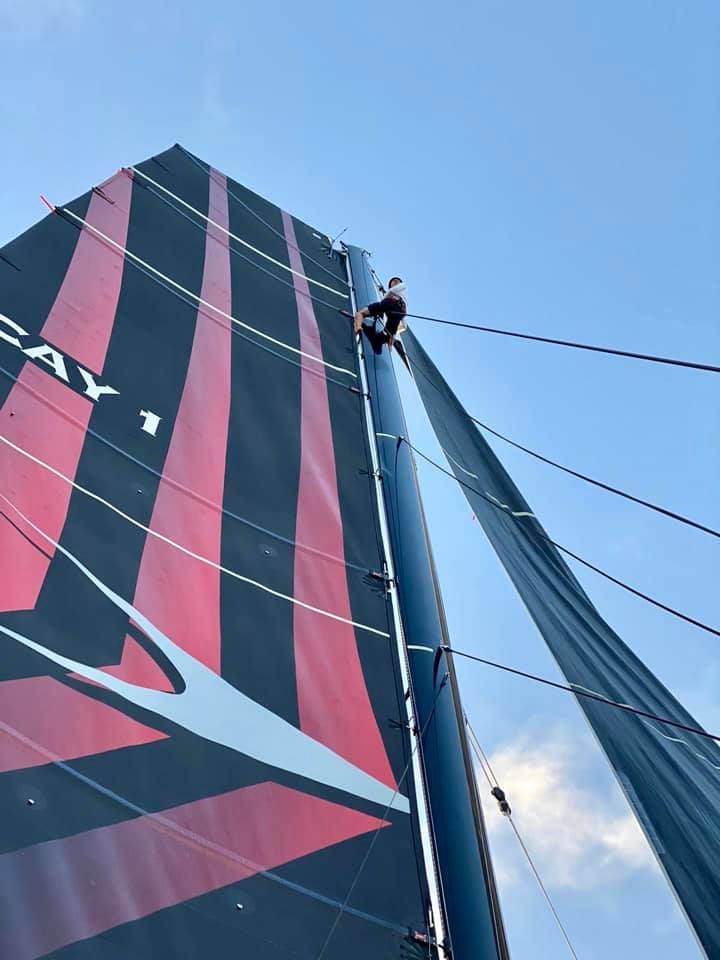
Knowing when to reef
The fundamental control on the power of the mainsail is what size sail you have decided to set. As the wind increases it is very important to reef at the appropriate wind speed and not wait too long, otherwise the boat becomes overloaded.
For instance, when racing on a MOD 70 trimaran, we’d usually go to first reef at 20 knots true wind speed, upwind and downwind. Of course, you could temporarily carry full main to 25 knots, if you are careful on the helm and with sail trim, but the boat will be slower as the sails will be eased and creating more drag. It is also far more dangerous to overload a 7-tonne trimaran that can capsize.
However, on delivery with the same boat, the reefing wind speed would be 17 knots True, as we reef as early as we can without losing significant speed.
As a guide to boat speed on delivery, upwind we are happy to be doing 16 knots and downwind 25 knots, and we want to achieve those speeds with the minimum of sail. When racing of course we try to go faster with a 20 knots target speed upwind and 30 knots downwind!
As the boat is very powerful, we would go to second reef at 26 knots and third reef at about 33 knots on the MOD70, less on delivery of course.
When cruising or on delivery, I always like to learn the minimum wind speed that I can reef while maintaining a similar boat speed. That way there is less stress to the boat, rigging and crew. The centre of effort of the sails also goes down, so heel and pitching reduce. Downwind, the bow down trim will reduce and the boat will be safer and lighter on the helm.
If the wind is expected to increase, I’d confidently change down at these minimum wind speeds, but if the wind is oscillating up and down in strength I would make sure the wind was really holding above that minimum wind speed before reefing.
And if unsure of what is going to happen with the wind – when sailing into squalls, into night time, or into gusty offshore winds near high land and headlands – then I would always aim to err on the side of caution. When cruising, being set up for the higher wind speeds than expected, is an old axiom.
The MOD is a super high performance trimaran of course, but to find out what the limits should be on a popular cruising cat I spoke to Graham Laver at Ancasta, who sent me the sailing guide for the Lagoon 52.
Interestingly, it’s not that different. With the standard pinhead mainsail, the first reef is recommended to go in at 21 knots both upwind and downwind, and in less wind with the optional square-top main, or in a bad sea-state. The second reef is recommended at 33 knots and the third is at 40 knots. These are higher winds than the MOD70, but then it’s a less powerful, heavier boat with a shorter rig.
Here we are talking all the time about wind speed in True, which requires a reasonably accurate instrument system. This is now common on most boats, but it’s very worthwhile to put in a little time to calibrate this as well as possible.
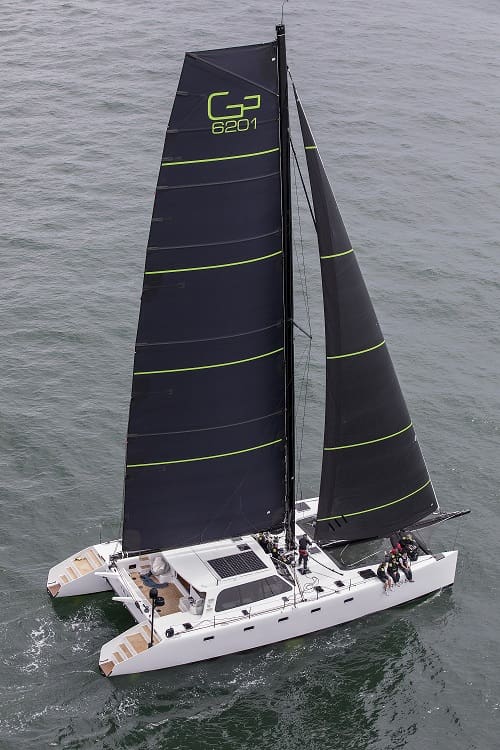
Not all about numbers
And this opens up the whole subject of instrument calibration. In essence the wind cups will, out of the factory, read the correct upwind and reaching apparent wind speed, but to get accurate true wind speed, the calibration of wind vane angle to the centreline, the boat speed and the compass are all very important so that the wind speed reads the same, tack to tack.
Downwind, the windspeed will often overread due to the upwash of wind from the square-top mainsail at full hoist, or a spinnaker, so be aware this may add about 2 knots to the windspeed. This can be calibrated out with advanced instrument systems
Even if the instruments are really well calibrated I like to always imagine how I would sail if they suddenly stopped working. So what are the other clues to use to estimate the wind speed?
Very important is the look of the wind on the water, the amount of white caps, as in the classic Beaufort scale, and also the feel of the boat: the speed through the water, the subtle heel angle changes, the amount of helm that is needed, and the balance of the boat.
For instance, how much you have to depower the boat to achieve a certain boat speed is a good guide. If I have eased quite a lot of mainsheet and traveller and the boat speed is as desired, and the front 20% of the main is luffing, then its probably past time to reef, even without looking at the true wind speed numbers.
In 2001, I sailed in the Mini Transat Race. At that time those boats had no wind instruments and it soon became second nature to know wind speed and direction, day or night. It’s a good exercise to always check your estimate of the wind speed against the instruments.
Of course you want your instrument and power system to be super reliable and well calibrated, so you don’t lose wind data on a dark night, but also you want to blend that information with your own judgement of the situation and have confidence in that judgement/intuition. The wind number is not an absolute guide to the forces on the boat anyway.
For instance, the same 20 knots wind speed is less powerful in the warm tropics than in the cold Southern Ocean. And on a foggy day with cold water and warm damp air, the wind is less powerful as there will be a lot of wind shear and the wind at the deck level is much less than the wind at the masthead.
So on a day when the wind is better mixed, the same 20 knots at the masthead is more powerful than that foggy day with laminar flow wind.
To summarise the discussion on reefing limits: it’s not just about the digital TWS number, but also what is right for the conditions you feel, the feedback from the behaviour of the boat, your predictions about what is going to happen in the future, the goal of the sailing and the abilities of the crew.
Reefing tips
Reefing is easy to do upwind or reaching, and I often slow right down to reef, and then get going again when the reef is finished. This keeps the apparent wind speed down, and makes for a safer platform for the crew. Downwind it can be trickier, with the friction of the sail and full length battens on the shrouds. If it’s not possible to head up, then winching the luff down at the same time as the leech should get the sail down slowly.
On very fast boats such as MOD70s you can keep going fast enough downwind to keep the apparent wind angle at 50° just with the gennaker, and then the mainsail can flap without hitting the shrouds when the traveller and mainsheet are eased. Then, once you are reefed, you can get back to your 37° to 40° of apparent wind angle and 30 knots of boat speed!
Mainsail trim
So now we have the right size mainsail for the situation, how are we best going to trim that sail?
The big controls are the mainsheet and the traveller, and the minor controls are the outhaul, halyard and Cunningham (and on some boats some of these last three are not adjustable).
So let’s talk first about upwind and reaching in moderate, flat water conditions, when the mainsail is trimmed the tightest – let’s say in 12 knots of wind.
For the mainsheet, you can keep trimming until the top telltale is folded to leeward of the leech about 20% of the time, and the other 80% of the time it, and all the other leech telltales, are flying. That is max main trim, giving the straightest leech and minimum twist. I like to think of this as 1 out of 10, or ‘minimum twist’. I like to look up the back of the leech sometimes to assess the amount of twist.
In fact, if you can then mark the mainsheet at this position along a scale on the boom, you could have marks from 1 to 10, with 1 being the most trimmed in you can go, and with 10 being the most eased. This is ‘maximum twist’, perhaps used when you are reefing.
I really like to have marks on the mainsheet (and everywhere else it might apply), as it’s easy to then repeat your settings, and also to pass on information to the rest of the crew in a concise form. In these upwind conditions, position the traveller so the clew of the mainsail is on the centreline.
As it gets windier, the first thing I would do is ease just a little mainsheet, to mark 2 or 3 on your scale so that the top of the main opens a little to reduce the power up top, and to reduce all of the loads. All the leech telltales will be flying now.
After that start easing the traveller down a little to depower further. Then, when you have 20% of the front of the sail luffing, its certainly time to reef, which will provide the same power, with less drag, so will be faster and safer.
In lighter winds you’d again have slightly less leech tension, perhaps also at twist mark 2 or 3, and the traveller slightly higher up the track so the clew still stays on the centreline. In light conditions you might use a little lazyjack or topping lift to stop the weight of the boom closing the leech. But by then most people will be motorsailing!
Use those leech telltales again when sailing downwind and reaching to set the correct twist through the mainsheet, and use the traveller to set the correct angle of the whole sail to the wind.
In waves you need to have more twist than in flat water as the apparent wind angle changes much more with all the heeling, pitching, and course changes, so you need a more tolerant setting.

Tweaking minor controls
The use of the minor sail controls can depend on the boat set up. Most boats will have an outhaul, to control the foot of the mainsail, and this will be tighter for strong winds and eased a little in the moderate, downwind and light conditions.
You can use either the halyard or Cunningham to control the luff of the sail. The goal is to barely eliminate the wrinkles in the luff and the sag between the batten and intermediate cars, but no more than that. Downwind you can ease the luff tension but still get rid of the wrinkles. On a bigger multihull with full battens, you can’t significantly move the draft forward of the sail with more luff tension or bend the mast like you can in a smaller cat.
The lazyjacks or topping lift should be left loose enough not to interfere with the mainsail but tight enough to hold the boom up if you forget to tighten them up before reefing or dropping the main.
Setting up your mainsail
When you first put on a fully battened mainsail on a multihull, the first thing you’ll notice is that it’s heavier than on an equivalent length monohull: the area is higher with the big roach, the full-length battens heavier, plus the weight of the mast track cars that go with the battens. The sail is typically made in a tougher cloth because the righting moment of the boat is greater than a monohull. So once you have that heavier sail into the lazyjacks, here are some tips for setting it up properly.
- Head: Set the correct distance between the head ring and the mast. If it’s adjustable you’ll find that bringing the head ring closer to the mast will put more fullness in the top of the main and make the leech tighter.
- Battens: Check the batten tension: ideally you want to be just getting rid of any vertical creases around the batten pockets. Too tight and the sail will be overly stressed and you can see the batten making the sail locally deeper.
- Depth: The mast is not tuneable in bend without a backstay, but one trick with full batten mains is to tune the thread that attaches the batten car to its mainsail track car. If you have more thread showing then the mainsail will get locally deeper as it is the equivalent of straightening the mast.
- Foot: Make sure the tack is lashed with the appropriate distance to the mast track so that it follows the luff of the sail. Ensure the clew is lashed down close to the boom and the outboard reef lines are run in the correct position.
- Reef lines: Due to the righting moment of the boat, the loads on the reef lines are higher than a monohull. Bigger multihulls will benefit from a hook arrangement for the reef so that it engages with a loop or a shackle on the leech of the main. This can help with chafe problems on lines and lessen compression on the boom.
- Telltales and stripes: Cut strips of red spinnaker cloth to use as telltales on the leech end of each batten. Big is better. The top one is particularly critical to make sure the mainsail is not over-trimmed. One trick for night sailing is to sew a little retroreflective tape to the back end of the telltales so they show up well when a flashlight is shone on them.
Draft stripes are useful on the mainsail to look at the shape at three different heights, and these can also have retroreflective alongside them for nighttime sailing

Brian Thompson – Director, Doyle Sails Solent
Brian Thompson is one of the world’s foremost multihull sailors and has sailed more miles in multihulls than any other British sailor.
Thompson, 58, has been sailing since he was three years old. He has competed in virtually every major offshore race, including the Mini Transat Race, the Vendée Globe, round the world records for the Jules Verne Trophy, the Route du Rhum and the Volvo Ocean Race.
Thompson has held most offshore records over the last three decades, including spending 11 years sailing with the American adventurer Steve Fossett. He has become the go-to helmsman for multihull sailing records and during his more recent time aboard the MOD70 Phaedo3, helped set ten world records. Thompson is currently campaigning the MOD70 Argo and is one of the directors of Doyle Sails UK.
For more information on Doyle Sails UK click HERE

Are Catamarans More Stable?

Last Updated by
Daniel Wade
June 15, 2022
Catamarans are known for stability. But why are they so even-keeled, and how much better are they than monohulls?
Catamarans are significantly more stable than monohulls, and they don’t heel at dramatic angles when underway. This is because catamarans distribute their displacement across a wide beam and keep minimal contact with the water.
In this article, we’ll examine why catamarans are more stable than monohull sailboats and what the true extent of their stability is. We’ll compare catamaran and monohull sailboat stability underway and at anchor, along with the few instances where monohulls have an advantage.
We sourced the information used in this article from experienced sailors and the testimony of marine architects and engineers.
Table of contents
How Catamaran Stability Works
Catamarans are stable because of their unique design and wide beam. A wide boat can’t be shaken back and forth as easily, but the magic comes from the dual-hull design of a catamaran.
Catamarans distribute their weight equally over two identical hulls. Like outrigger sailboats, they resist tilting to one side because the other hull’s buoyancy overcomes the force of the rising or falling sea.
But unlike outriggers, which usually have their sails and weight on the larger hull, catamarans have it all in the middle. That means that the effect is equal on both sides.
It also makes much of the wave interference simply travel underneath the center of the catamaran instead of pushing it off to one side.
Other Benefits of Catamaran Buoyancy
As we alluded to before, catamarans can be made virtually unsinkable due to their inherent buoyancy and additional positive buoyancy that’s worked into the design by manufacturers.
Additionally, catamarans often employ low-buoyancy bows, which further increase speed and stability. They create an effect called ‘wave-piercing,’ in which the low-buoyancy bows are forced through waves instead of riding over them.
This plowing effect causes the catamaran’s bows to cut through the tops of waves like a knife, thus effectively decreasing the difference between the peak and the trough. This reduces front-to-back rolling and also prevents pounding in most situations.
The Pendulum Effect
The pendulum effect is based on a simple rule that monohulls have to contend with. Every action has an opposite reaction. Let’s examine a typical monohull to see how this phenomenon works.
Most monohull sailboats have a low center of gravity. On a single-hull vessel, this is an important safety feature as it allows the boat to recover from rolls. It also slows the rolling motion somewhat for the sake of the crew.
Picture this scenario. A displacement monohull with a deep and heavy keel is traveling perpendicular to the roll of the waves. A large wave rolls under the boat, lifting it up on the opposite side and causing it to roll towards the next wave.
Then, the weight of the keel swings it back, but the momentum carries it to a roll in the opposite direction, just like a clock pendulum. By the time the next wave arrives, the vessel is in the perfect position to be knocked sideways again.
This effect doesn’t occur on catamarans for a few reasons. Firstly, they have virtually no ballast and thus nothing to compound the roll or overcompensate for it—no pendulum effect.
Additionally, catamaran hulls can’t be rolled sideways without pushing the other hull down into the water, which its high buoyancy and shallow draft resist with great force. No push, no roll.
Heeling While Underway
Catamarans don’t heel for the same reason they don’t roll dramatically—buoyancy. Catamarans are highly buoyant, as they carry no ballast and feature thin hulls with tall freeboard. As a result, the sideways force of the wind isn’t sufficient to force the leeward hull very far down.
Benefits of Anti-Heeling Characteristics
Boats that don’t heel excessively have numerous benefits, especially for inexperienced sailors. A heavily-heeling monohull is very difficult to move around inside, as the floor is suddenly sideways.
Additionally, the deck and cockpit become wet and perilous. Catamarans stay level regardless of how fast they’re moving, which allows anyone to safely move around the boat, cook, eat, shower, and sleep without being thrown to the side or rolling out of bed.
Catamaran Reserve Buoyancy
Reserve buoyancy is any watertight space or material that keeps a boat afloat beyond its open and occupied spaces. It’s basically how much ‘float’ a boat has left when open spaces begin to float. And catamarans have a whole lot of it.
Because of their split design and wide footprint, catamarans can store a lot of reserve buoyancy in the form of un-ballasted spaces, unsinkable foam, and more. This is excellent for safety, but it doesn’t necessarily mean a boat will roll less.
What makes catamarans so special is how their hulls are designed. They sit high in the water and high above the water because the weight is well-distributed, and there are huge pockets of air in each of the hulls.
Examples of Incredible Catamaran Stability
But how stable are catamarans, and what does it mean for the passengers and crew? We found some anecdotes told by catamaran owners that are sure to make monohull owners envious.
For example, catamarans are known to be so stable that wine glasses don’t fall off galley tables during high winds. Additionally, people can enjoy a meal on the deck and stay dry during afternoon chop and plentiful whitecap activities.
Can Catamarans Capsize?
Under normal circumstances, the chances of a catamaran capsizing are extremely slim. The same factors that give way to superior inherent stability also do an excellent job preventing capsize. But the answer is a little more complicated than that.
There are some limited instances where a catamaran can capsize, and the results are a lot more troublesome than monohull capsizing. Yes, when a massive wave undercuts a catamaran under the right conditions (usually perpendicular to the waves and wind and in rough weather), a catamaran can flip over.
Unlike monohull sailboats, which rely on a low center of gravity and deep displacement for stability, catamarans gain most of their stability from factors above the water. This means that, when capsized, catamarans cannot self-right. In other words, if a catamaran capsizes, it’ll stay that way.
However, there are some benefits to catamarans when it comes to capsizing. For example, a capsized catamaran has the same buoyancy as an upright one. That means that the now inverted vessel makes for a great life raft and will remain stable in the upside-down position.
Given that catamarans are very difficult (or impossible) to sink, this can still be considered a safer scenario than a serious capsize in a monohull sailboat.
Are Catamarans Stable at Anchor?
Yes, catamarans are highly stable at anchor and generally don’t noticeably roll. Instead, they tend to bob up and down (if they even move at all). This is advantageous, as it keeps decks level and prevents guests from getting seasick.
Related Articles
I've personally had thousands of questions about sailing and sailboats over the years. As I learn and experience sailing, and the community, I share the answers that work and make sense to me, here on Life of Sailing.
by this author
Learn About Sailboats
Most Recent

What Does "Sailing By The Lee" Mean?
October 3, 2023

The Best Sailing Schools And Programs: Reviews & Ratings
September 26, 2023
Important Legal Info
Lifeofsailing.com is a participant in the Amazon Services LLC Associates Program, an affiliate advertising program designed to provide a means for sites to earn advertising fees by advertising and linking to Amazon. This site also participates in other affiliate programs and is compensated for referring traffic and business to these companies.
Similar Posts

Affordable Sailboats You Can Build at Home
September 13, 2023

Best Small Sailboat Ornaments
September 12, 2023

Discover the Magic of Hydrofoil Sailboats
December 11, 2023
Popular Posts

Best Liveaboard Catamaran Sailboats
December 28, 2023

Can a Novice Sail Around the World?
Elizabeth O'Malley

4 Best Electric Outboard Motors

How Long Did It Take The Vikings To Sail To England?

10 Best Sailboat Brands (And Why)
December 20, 2023

7 Best Places To Liveaboard A Sailboat
Get the best sailing content.
Top Rated Posts
Lifeofsailing.com is a participant in the Amazon Services LLC Associates Program, an affiliate advertising program designed to provide a means for sites to earn advertising fees by advertising and linking to Amazon. This site also participates in other affiliate programs and is compensated for referring traffic and business to these companies. (866) 342-SAIL
© 2024 Life of Sailing Email: [email protected] Address: 11816 Inwood Rd #3024 Dallas, TX 75244 Disclaimer Privacy Policy
Accidents : How capsize-proof are cruising catamarans?
Johannes Erdmann
· 20.09.2023
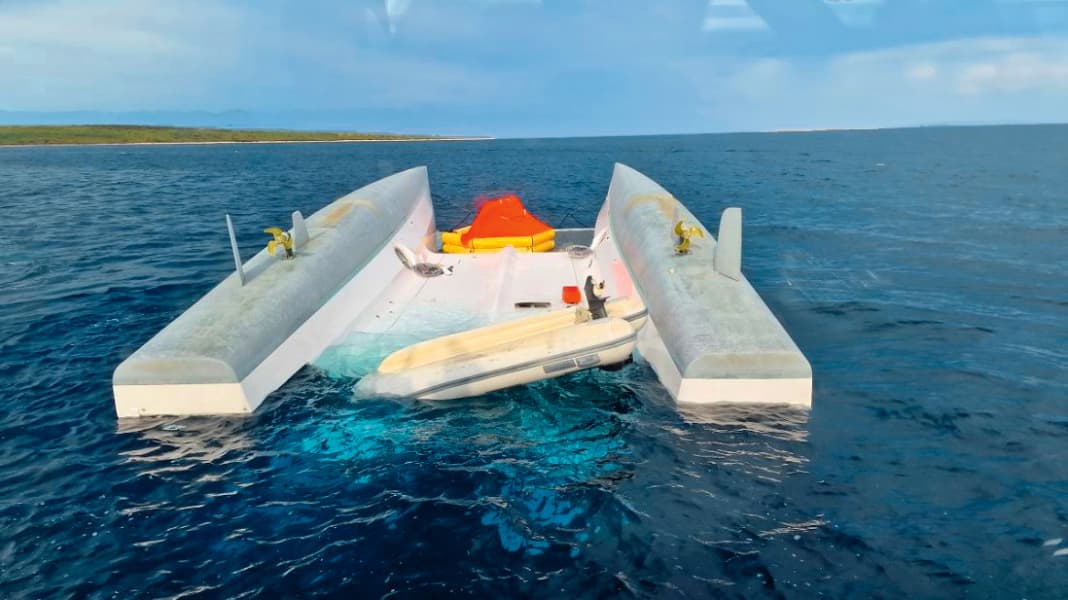
When monohull yachts reach their stability limits, their crews can clearly feel it. The heeling increases sharply, often accompanied by a brilliant sun shot and loudly rattling sails. If there is too much cloth, the boat can overtake so far that it is difficult to hold on to the cockpit, let alone furl the genoa and tie in a reef. In other words: orange alert!
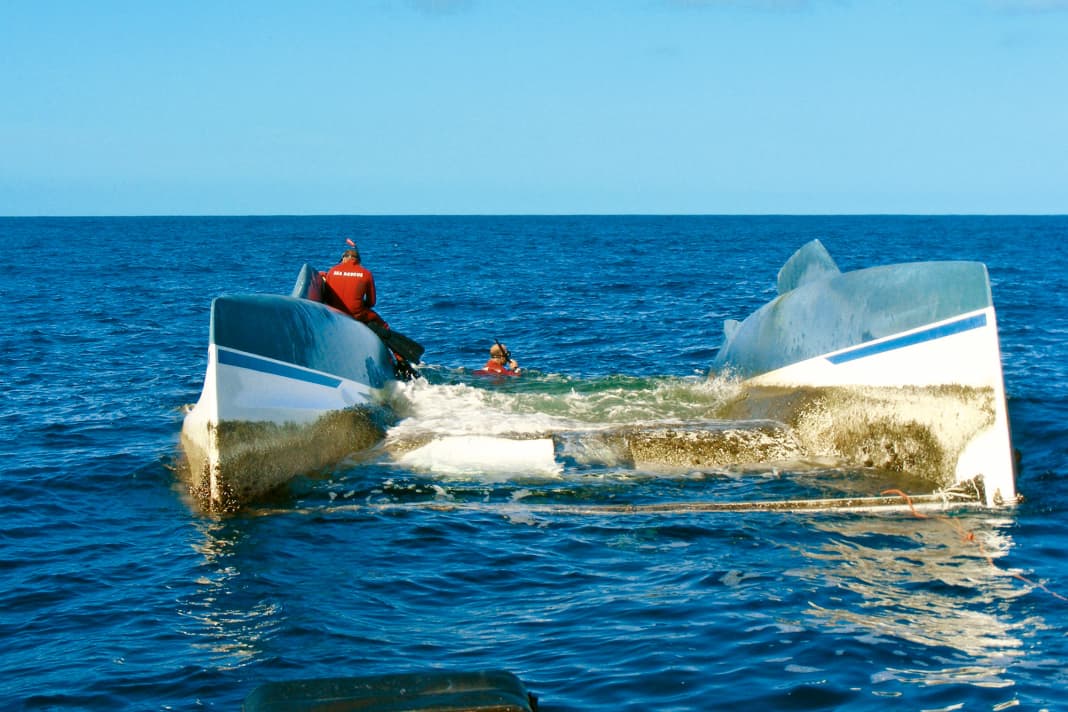
If you have already reduced the sail area with foresight, you will only be noticeably laid on your side in a gust. This reduces the wind pressure in the rig, and as soon as it eases, the ship rights itself again. This self-regulation and the ability to communicate at the limit makes keel yachts comparatively easy to handle. This is another reason why they are considered by many to be more seaworthy and safer.
Most read articles
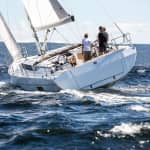
Ride-on cats react differently to monohulls
A heavy, seven or even eight metre wide twin hull hardly heels. Thanks to its dimensional stability, its rig can withstand the force of the gust for much longer. This characteristic is particularly appreciated by beginners and occasional sailors, who often feel uneasy when sailing monohulls.
Static stability in comparison
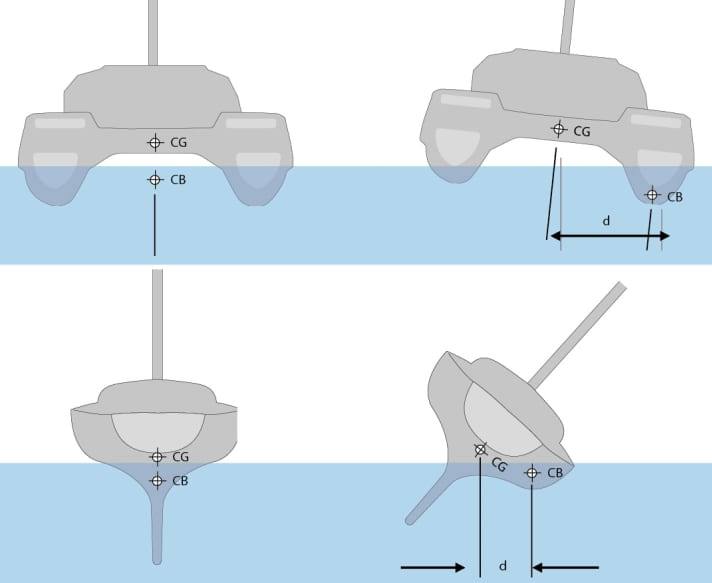
The righting moment (RM) defines how much resistance a yacht has to lateral forces. It is calculated from the product of the weight of the ship and the distance (d) between the centre of gravity (CG) and the centre of buoyancy (CB). In a monohull, both centres of gravity are close together even when heeled. Although the cat hardly heels when sailing, the empty hull is pushed slightly under water by the wind and the centre of buoyancy also moves to leeward. Due to the greater distance between the two centres of gravity, the righting moment of a catamaran is many times that of a monohull.
Stability curves
However, the advantage of greater initial stability does not override physics, nor does it replace the need for good seamanship. If the force applied is too great, even multihulls can tip over - not with long notice, but suddenly.
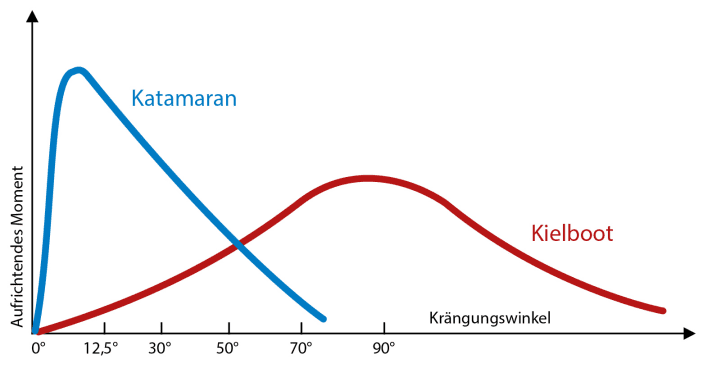
Even if the circumstances and the boats were very different and require a differentiated analysis, the overall picture nevertheless raises fundamental questions:
- Under what conditions can it become critical on catamarans?
- What safety reserves do they offer?
- And how has their design changed in recent years?
Firstly, it is important to categorise the accidents. The catamaran off Corsica, for example, was not an ordinary cruising catamaran, but an extremely lightweight construction from the 1990s. According to the shipyard, the Outremer 43 had an unladen weight of less than four tonnes. By comparison, a Lagoon 42 designed for cruising weighs a good three times as much today. Furthermore, the boat did not capsize while sailing, but at anchor after the wind had reached under the bridge deck with peaks of up to 90 knots.
The cat that capsized off Vlieland was also a lightweight construction, and an extremely compact one at that, with a hull length of just eight metres. The French-built Rackham 26, which was available in a basic and a regatta version until it was discontinued, is more of a sports catamaran than a touring catamaran and does not fulfil the CE requirements for offshore use. In the stormy conditions that were its undoing, it simply had no place in the choppy North Sea.
When does a catamaran capsize?
How much wind or wave does it take to exceed the stability limit? The physical background to stability is quite simple to outline: A boat that experiences a lateral force in the rig due to wind pressure always has a tendency to lean to one side. To prevent it from capsizing, it needs a righting moment (RM) that is stronger than the force applied. It can be understood as a kind of built-in static resistance to tipping and describes the product of the ship's weight and the distance (d) between the centre of gravity (CG ) and the centre of buoyancy (CB). Drift also plays a role, i.e. the tendency to counteract the wind pressure by pushing it away.
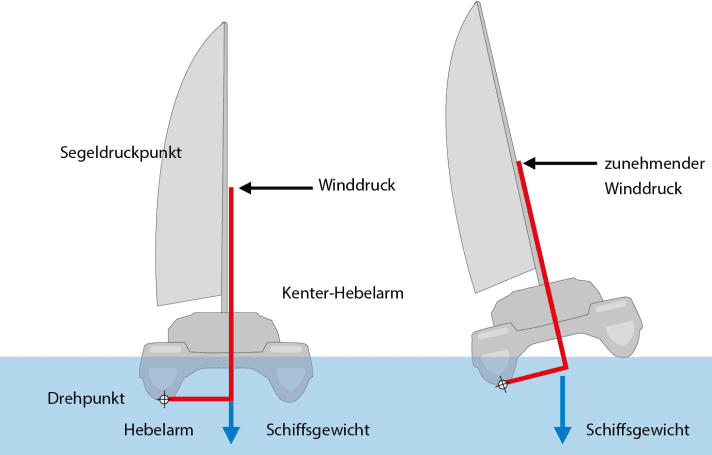
For those switching from a keelboat, this "sailing by the chart" is unfamiliar. But on a catamaran, there is no feedback for reefing by feel. Even more so than with a monohull: if in doubt, it is better to reduce the sail area too early than too late. A reefed cat sails better than an over-rigged one anyway.
The reaction to gusts also differs. If the wind suddenly picks up or there is more wind in a cloud than expected, there are two ways to temporarily compensate for the overclocking: When sailing courses from half to room wind, it helps to drop as far as possible without risking a gybe. Under no circumstances, however, should you jibe under pressure, otherwise the apparent wind will increase even more.
To quickly take pressure out of the sail, luff up on upwind courses, drop in half to full breeze
On an upwind course, on the other hand, it helps to lean a little, because usually only a few degrees are needed to reduce the pressure. The headsail and main may invert noticeably in the luff, i.e. show a counter-belly. On all courses, reef immediately after the gust has passed!
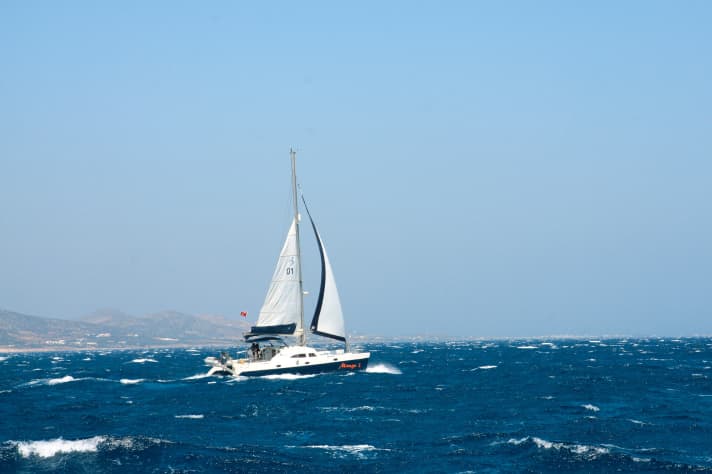
Bruno Belmont recommends always keeping an eye on the boat's speed in heavy weather and not surfing too fast into the valleys in big waves, otherwise capsizing over the bow is possible, especially with light trimarans.
Capsizing over the bow
With heavy cruising catamarans, there is hardly any risk of being undercut by the waves with the bows and going upside down when surfing. Today's boats have sufficient buoyancy in the bridge deck and in the area of the bows to quickly pull the bow tips back to the water surface when undercut. Capsizes over the bow happen more frequently on trimarans, such as the Dragonfly 28 on the Silverrudder 2015, on fast beach cats or extreme vessels such as the 72-foot America's Cupper from Oracle (see gallery above).
In a storm, Belmont advises setting a small storm jib when running off the waves and slowing the boat down with trailing lines, which he usually lays in long loops from stern cleat to stern cleat. If this is no longer sufficient, he recommends turning under a drift anchor.
He himself has only been scared once on a cruising catamaran, and that was decades ago. Back then, he was testing the prototype of the Lagoon 37 TPI in a severe winter storm. The problem: "The keels were still far too long back then, and we always had the feeling that we were about to capsize sideways." Keels that were too deep were a common problem with the cruising cats of the first generations because they had too much resistance leeward and caused the boats to stumble. For this reason, the windward centreboard is used at most on cats with centreboards in storms.
According to Belmont, capsizes are generally very rare. "We may have missed a few cases," he says, "but to my knowledge, only a handful of the 6,400 ships built have capsized."
So something must have gone wrong in Croatia when the Outremer 45 of a Berlin family capsized during a storm in mid-July. "In the storm, it only took a moment for the boat to capsize," the Croatian rescue team announced on its Facebook page. "But it took four long and labour-intensive days to turn the boat back around."
A well-built catamaran is extremely safe. Only a fire or a cargo ship can sink it
Once a cat is upside down, it is difficult to turn it back again. "One of the most fundamental laws of physics is that everything in nature seeks its most stable position," writes American blogger and catamaran fan David Crawford on his website. And admits: "Once a catamaran is upside down in the ocean, it has found its most stable position." As unfortunate as this is, Crawford also sees the good in it: "For a monohull, the most stable position is at the bottom of the ocean." In his opinion, there is no safer ship than a catamaran. "The most that can sink a well-built cat is a fire or a cargo ship."
Unsinkable life raft
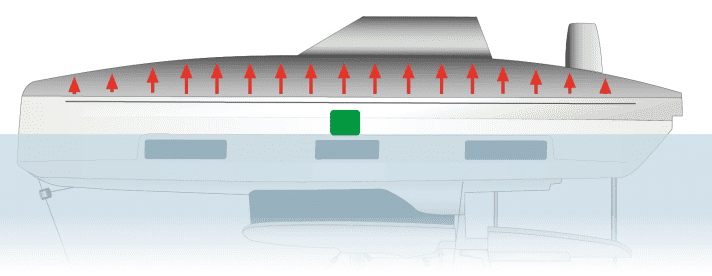
Ridetheducks.com is reader-supported. When you buy through links on our site, we may earn an affiliate commission. Learn more
Trimaran vs Catamaran
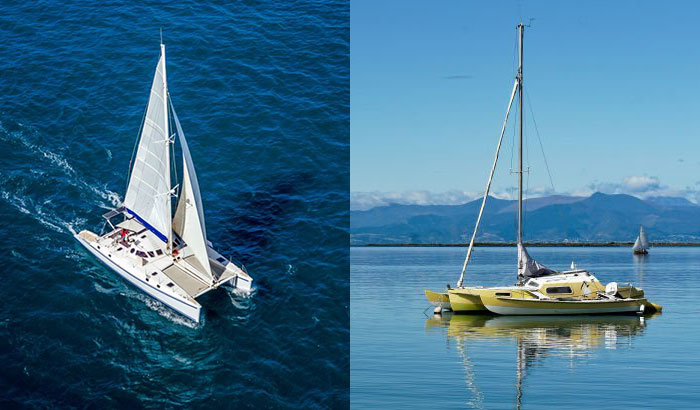
Trimaran and Cataraman are quite similar in design, making it difficult for many people to distinguish between the two, let alone choose one. However, you might be surprised to know that their differences are rather significant.
In this post, we will compare the Trimaran and Catamaran so that you can clearly identify them and make an informed decision when purchasing one.
About Trimaran boats
About catamaran boat, so, which boat do you think is better.
A Trimaran is a type of boat that has three hulls instead of the usual one. The front and back hulls are usually small and used for stability, while the middle hull is larger and used for most of the boat’s functionality.
Some Trimarans can also be configured to be sailed as a Catamaran by removing the front and/or back hulls.
Trimaran boats have several unique features that make them better suited for certain tasks than other types of boats.
- Trimarans are more stable in rough water than other boats, and they are often used for racing or long-distance sailing
- The extra hulls make Trimarans more stable and less likely to capsize in rough water
- They also provide more space inside the boat for passengers or cargo and can be faster and more maneuverable than other boats of similar size
- Trimarans are also good for sailing in shallow waters since they can float on two hulls while the third one is still submerged
Despite their advantages, Trimarans do have some drawbacks.
- They can be more difficult to dock or more than other boats, and they require more crew members to operate effectively
- They are also more expensive to build and maintain than other boats
However, for those who are looking for a fast, stable, and versatile boat, the Trimaran is a great option.
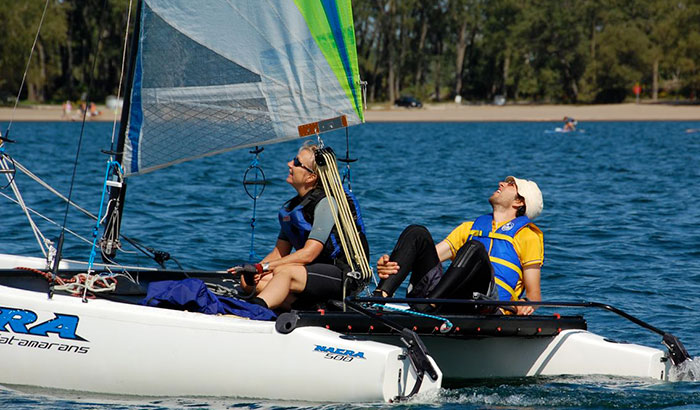
Catamaran boats are a type of boat that has two hulls, making them comfortable vessels to ride.. They can also be more comfortable to ride in than other types of boats.
Here’re some of this boat’s advantages:
- Catamaran boats can be sailed by a smaller screw than other types of boats. This also makes them a popular choice for charters and sailing vacations
- Their prices are more affordable, thus suitable for family use
- Catamarans are usually built from lightweight materials, making them ideal for speed and agility
- The most distinguishing feature of a Catamaran boat is the lack of any external rigging. This means that the sails are mounted on the mast and boom directly to the hulls, rather than to a frame that hangs below the hulls
- Therefore, they have a great range of sail shapes and sizes, which can be adapted to changing wind conditions
- Another advantage of a Catamaran boat is its stability. Because the hulls are wide and shallow, they offer more resistance to overturning than a monohull boat of the same size. This makes Catamarans an ideal choice for sailing on rough seas
However, Catamarans do have a few drawbacks.
They are less agile than monohull boats, making docking in confined places more challenging
- Docking these boats is costly
- In big waves, there is a chance of slapping
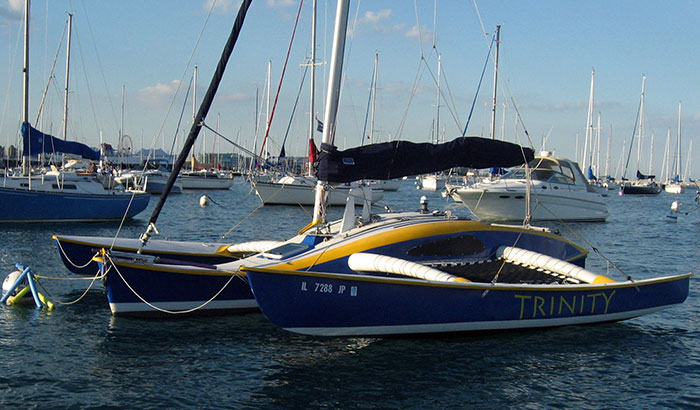
- Speed – The Trimaran is the faster of the two boats. It can reach speeds of up to forty knots, while the Catamaran can only reach about half that speed.
- Stability – The Trimaran is more stable than the Catamaran. This is because it has three hulls instead of two. This makes it less likely to capsize in rough seas.
- Space – The Catamaran is bigger than the Trimaran. This means that it can hold more people and cargo. The Catamaran can also be used for longer trips, while the Trimaran is better suited for shorter trips.
A Trimaran is a multi-hull boat with three hulls, while a Catamaran has two hulls. Both types of boats can be made from a variety of materials, including wood, aluminum, and fiberglass.
More Stable and Ideal for Racing: Trimaran
The main advantage of a Trimaran is its stability in rough waters. Catamarans are also stable boats, but they are not as resistant to strong winds and waves as Trimarans.
Trimarans also typically have more deck space than Catamarans, which makes them ideal for sailing or fishing trips.
A Trimaran is typically faster and more stable than a Catamaran, making it ideal for racing or long-distance travel. A Catamaran, on the other hand, is better at handling rough seas and is more agile.
Ideal for Calm Water: Catamaran
Catamarans are usually faster and less expensive to build than Trimarans, making them a popular choice for recreational boaters. However, due to their size, Catamarans are not as seaworthy as Trimarans and are not recommended for use in rough waters.
Trimarans and Catamarans are both types of sailing vessels . They have many similarities, but there are also some important differences between them. If you’re interested in learning more about these boats or in purchasing one for your use, it’s important to understand the pros and cons of each type.
Overall, the Trimaran is the better boat. It is faster, more stable, and has more space. However, the Catamaran is cheaper and can be used for longer trips. If you are looking for a boat that is good in all areas, the Trimaran is the best choice.
Hopefully, this article has helped you do that. Thanks for reading!
Leave a Comment Cancel Reply
Your email address will not be published. Required fields are marked *
Save my name, email, and website in this browser for the next time I comment.
- Advertising
- Distribution
- Good Jibes Podcast
- Boat In Dining
- Sailboat Charters
- Business News
- Working Waterfront
- Youth Sailing

The three crewmembers onboard were all airlifted to safety by a Moroccan Army helicopter and turned over to the French consulate in Casablanca. The boat, meanwhile, was reportedly still mostly intact with all its hulls and crossbeams in place, though the mast broke into several pieces. A technical team with three members from Banque Populaire and two rescue divers arrived back at the boat on Monday to prepare the boat for towing. Conditions at the scene were said to have been pretty manageable, but weather was coming, so time was of the essence. The divers salvaged some parts and cut away other parts before towing could commence. The tow was slow to avoid further damage; it took 48 hours to cover 130 miles.
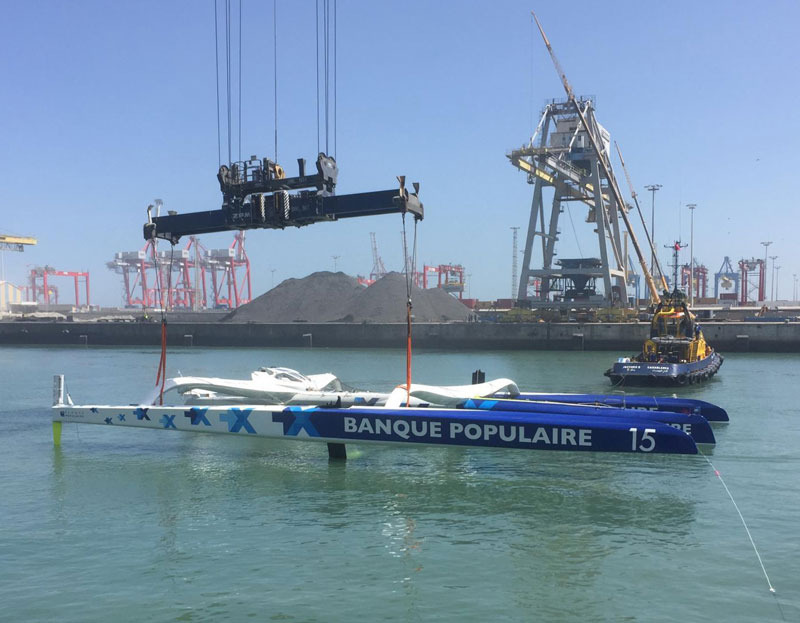
Ronan Lucas, director of the Banque Populaire team, said they would "make an initial assessment of the damage; it is found that many parts of the central hull deck around the mast foot are damaged, as well as the deck of the floats and the arm fairings; some of the caps were washed away."
The incident is a major setback for both Team Banque Populaire and for the new Collectif Ultim group that is promoting the racing of such monstrous boats. This new ‘league’ of mostly solo maxi-trimaran racing is just getting underway with their first big regatta in a week’s time as they prepare for the Route du Rhum later this fall and a round-the-world race to begin next year.
You can watch a video of BPIX’s first sail here . The brand-new boat reportedly cost between $15 and $20 million euros to construct.
Leave a Comment Cancel Reply
Notify me via e-mail if anyone answers my comment.
California Condor Spotted in Tiburon The boat, not the bird. Mikey Radziejowski goes out on a limb — er, boom — trying to heel California Condor off the mud.
Déjà Vu at Aquatic Park There have been a few developments in the case of ‘that one boat’ at Aquatic Park, a roughly 30-ft trimaran that has been the center of controversy for the last few weeks — or rather, there’s been a case of déjà vu. But
Meet the Experts at Our Boat Show Booth Martin assembles the WinchRite booth in Richmond’s historic Craneway Pavilion, where Fords were formerly assembled.
Watch CBS News
Dozens of high school students, 2 adults from Connecticut rowing club rescued after boats capsize
By Katie Houlis, CBS New York Team, Alecia Reid
Updated on: March 21, 2024 / 11:09 AM EDT / CBS New York
WESTPORT, Conn. -- Nearly 30 members of a Connecticut rowing club, including more than two dozen high schoolers, were rescued from the Long Island Sound on Wednesday after their boats capsized.
Police said just before 5 p.m., three rowing sculls and one chase boat launched from Saugatuck Rowing Club in Westport . Each rowing scull carried nine rowers, all males between the ages of 14-18. The chase boat was operated by one coach.
Rowing club releases statement
The Saugatuck Rowing Club released a statement about the rescue, thanking emergency responders.
"First and foremost, we are grateful that all 29 individuals involved in the incident are safe and accounted for. Two students had hypothermia and were taken to Norwalk Hospital, and they have recovered. Our rower's well-being remains our utmost priority, and we commend the swift and effective response of the authorities involved in ensuring their rescue. As with any outdoor sport, rowing inherently involves certain risks, and our club takes comprehensive measures to prioritize safety. However, despite thorough planning and adherence to safety protocols, unexpected weather changes can occur, as was the case in this instance. We are currently conducting a review of the incident to understand the circumstances fully and to identify any areas where our safety procedures can be further strengthened. In the meantime, we would like to extend our sincere gratitude to all emergency responders involved: Marine Police, Firefighters, EMTs and The Coast Guard, for their professionalism and dedication in ensuring the safety of our young rowers and coaches. Saugatuck Rowing Club remains dedicated to providing a safe and enjoyable environment for all members, and we appreciate the continued support of our community during this time."
What led to the rowing accident?
According to police, as the boats reached Cockenoe Island, the weather began to change and they tried to head back to the club, but two of the rowing sculls began to take on water and capsized, throwing 18 students into the water. Some of the students then swam to the chase boat and hung onto the side, which caused the chase boat to sink.
Sixteen-year-old Davis Evans was on one of the boats that capsized and had to be rescued.
"It was really scary. I'm still kinda shaken up," he said. "It was really clean and then really right as we spun, it just, it got windy and the waves were just crashing into our boat and it was just filling up with water. It was really scary."
Watch: Westport officials provide update on water rescue in Long Island Sound
Police say a second coach launched another chase boat from the rowing club and began to shuttle people to Compo Beach Marina as first responders were sent to the scene.
"We had dispatch reports that were coming from 911 calls from the actual incident on the water. So the first calls were actually from someone [who] reported that they were in a capsized boat and in the water," Westport Deputy Fire Chief Nicholas Marsan said.
According to police, the temperature of the water was approximately 44 degrees at the time.
Chaotic scene in water and on shore
"Responding units found a chaotic scene of youths swimming to shore. Some of them were arriving by boat. Some were swimming. Some were still in the water between Compo Beach and Cockenoe Island," Westport Police Chief Foti Koskinas said. "First responders immediately began providing care to those individuals who were on shore and coordinating the recovery of people in the water."
"When we finally got back on the beach, we had to run back on the beach towards the trucks and we were, like, falling and stuff. We couldn't really walk. It was rough," Davis said.
The rescues
A total of 27 high school students and two adults were rescued, with at least 12 rowers being pulled out of the water by Westport Marine Police and the Westport Fire Department.
Police say the last victim was recovered from the water around 6 p.m. -- somewhere between 48-52 minutes after the boats capsized.
Two students were taken to a local hospital to be treated for hypothermia. The rest of the victims were treated on the scene.
"Team effort"
"This was truly an incredible team effort by all. By the coaches that were involved from the rowing club and by all the first responders," Koskinas said.
When asked if he'll be back on the water any time soon, Davis said, "Yeah, rowing is my sport. It's what I do."
We reached out to Saugatuck Rowing Club, but they declined to comment.
The police chief says they're still looking into exactly what happened out on the water. The goal of the investigation is to work with community partners to make sure something like this doesn't happen again.
- Long Island Sound
- Westport News
Featured Local Savings
More from cbs news.

2 injured, 1 critically, in Queens apartment building fire

NYPD officer shot and killed during traffic stop in Queens

5 firefighters injured battling high-rise fire in Lower Manhattan

Man killed, 17-year-old injured in shooting at party on Long Island
- Share full article
Advertisement
Supported by
Guest Essay
My Country Is Witnessing a Messy, Buffoonish End of Rule

By Boubacar Boris Diop
Mr. Diop is a Senegalese novelist, journalist and screenwriter. He wrote from Dakar, Senegal.
On Dec. 31, 1980, Léopold Sédar Senghor , the first president of Senegal, announced that he was leaving power. At 74, he felt that his time was up. When courtiers tried to convince him to reverse his decision, he reportedly replied, with a smile: “Don’t you know how the Senegalese are? If I go back on my word, they’ll laugh at me.” His act was especially remarkable at a time when dictators for life were common across the African continent. Even if his political record remains controversial to this day, Mr. Senghor, a fervent Catholic poet, was open-minded enough to lead a majority Muslim country and even managed to make it a model of stability in the region.
Things are very different today. In Mr. Senghor’s homeland, we are in the midst of a messy and at times buffoonish end of rule that threatens to capsize the country’s hard-won equilibrium. In early February, President Macky Sall, approaching the end of his two terms in office, postponed an election set for later that month. The move immediately plunged Senegal into disarray, setting off widespread protests, parliamentary chaos and a full-blown constitutional crisis. In one of the very few African countries never to have experienced a military coup , the last-minute postponement felt tantamount to a coup d’état.
If Mr. Sall’s gambit was to remain in power, it didn’t work. Into the vacuum stepped the constitutional council, the country’s highest court, which ruled that the delay was illegal . Backed into a corner, Mr. Sall eventually agreed to leave office on April 2 and the election was rearranged for March 24 , this Sunday. For Mr. Sall, holed up in the presidential palace he was so loath to leave, it marks an embarrassing reversal, to say the least. But for Senegal it is much more serious. The country’s destiny, entrusted to Mr. Sall for 12 years, is now in danger.
Since committing not to run for a third term last summer, Mr. Sall has never been quite the same. He has become irritable, humiliating his ministers in public and naming boulevards after himself. Let down by his own people and his traditional Western supporters, he gave vent to his anger in a February speech with a very strong Wolof expression — “Doyal naa ci sëkk!” — which can be politely translated as: “I’m more than fed up with this power, take it back whenever you want!”
Such a disastrous end to Mr. Sall’s career is all the more perplexing given that he had very good intentions at the outset. In April 2012, two weeks after his swearing-in, he announced from the Élysée Palace in France his decision to reduce presidential terms of office from seven to five years. After the change was eventually upheld in a referendum , applying to his second term rather than his first, Mr. Sall seemed to have honored his word. But his subterfuge in recent weeks suggests that, in the end, even this dream was too big for him.
This post-independence president, the fourth to hold the office, is the first to be so often called a dictator. Is he one? The answer is no, when you consider the carnage being perpetrated by Mahamat Idriss Déby’s regime in Chad, for example. I’m well aware, however, that this kind of comparison not only leads nowhere but is also rather dangerous. Each country must be judged on the basis of its own history, and it would be very sad to end up congratulating ourselves on having fewer dead bodies in the streets of Dakar than in those of Ndjamena.
Nevertheless, the man who vowed in April 2015 to all but eliminate the opposition has shown himself to be increasingly authoritarian and violent in the past three years. After turning the opposition leader, Ousmane Sonko, into a mythical figure by demonizing and imprisoning him, Mr. Sall brutally repressed all demonstrations in his support. Since March 2021, when Mr. Sonko was arrested, security forces have killed at least 40 young protesters. For good measure, the government threw 1,000 activists in prison, including Bassirou Diomaye Faye, another leading opposition figure. Credible reports of torture have not been investigated.
It’s a lot of collateral for Mr. Sall’s ultimately failed attempt to outstay his welcome. His detractors would like to see him prosecuted by international justice but, in the world as it is, this seems unlikely. Senegalese civil society, though, may demand that whoever succeeds Mr. Sall hold him accountable for his actions. That’s where a new amnesty law passed by Parliament in early March could prove crucial. The law, which pardons acts committed in connection with political unrest since March 2021, has led to Mr. Sonko and Mr. Faye, who is a candidate in the election, both being freed . But many fear that it could be also used to protect the security forces and, of course, Mr. Sall himself.
For now, the constitutional council has succeeded in calming things down, but Senegalese democrats shouldn’t sing victory too soon. The worst — contested results setting off violently repressed protests, for example, amid the threat of military involvement and foreign interference — could be still to come. Even if the election goes smoothly, it’s hard to imagine certain high-profile figures in the presidential camp allowing themselves to be held to account by the next administration without a major reaction. There could well be more trouble ahead.
But whatever happens, these three years of turmoil may not have been in vain. Senegalese citizens are now more aware of the strengths and weaknesses of their democracy — and it is reasonable to assume that no future president, unless he has lost his mind, will try to serve more than two terms. This is a great thing, but it could have been achieved without disgracing the country and creating this much grief.
Indeed, the debates about Mr. Sall’s successor have rarely gone beyond speculation about who will soon occupy the presidential palace. The question of what the winner intends to do for the country is almost never raised. In the lead-up to Sunday’s election, many voters will have only a vague idea of the programs and capabilities of the many different candidates. As things stand, there is every reason to be concerned about the near future. Only one person is responsible for this uncertainty: Mr. Sall, the man who turned his back on the history of his people.
Boubacar Boris Diop is a Senegalese novelist, journalist and screenwriter. He is the author, among other books, of “Murambi, the Book of Bones” and the winner of the 2022 Neustadt International Prize for Literature.
The Times is committed to publishing a diversity of letters to the editor. We’d like to hear what you think about this or any of our articles. Here are some tips . And here’s our email: [email protected] .
Follow the New York Times Opinion section on Facebook , Instagram , TikTok , WhatsApp , X and Threads .

Today's Paper | March 26, 2024
11 rohingya found dead after indonesia boat capsize.
MEULABOH: The bodies of at least 11 Rohingya refugees have been recovered off Indonesia’s westernmost coast after their boat believed to be carrying around 150 people capsized last week, officials said on Monday.Indonesian rescuers called off the search for any remaining Rohingya refugees on Friday after 75 were rescued, despite reports from some survivors that dozens of people were swept away when their boat and another trying to help them capsized days earlier.
The head of the local search and rescue operation, Muhammad Fathur Rachman said nearly half-a-dozen Rohingya were found dead at sea 14 nautical miles (26 kilometres) from shore.
“Six more bodies are being evacuated right now,” he said by phone on Monday afternoon.
“They were all women. We heard about the bodies from a fisherman. The bodies will be taken to the hospital.” Earlier on Monday, United Nations refugee agency (UNHCR) officials said five bodies had been recovered in recent days. On Thursday, authorities staged a dramatic rescue of 69 Rohingya who had been adrift at sea for weeks before the boat capsized, with many found clinging to the hull of the overturned vessel. Six others were rescued by fishermen on Wednesday.
Published in Dawn, March 26th, 2024

UK blames China for two ‘malicious’ cyberattacks
Five killed, 1,000 homes destroyed in png earthquake.

Anti-establishment candidate wins Senegal presidency

ڈان انویسٹی گیشن: بحریہ ٹاؤن کراچی کی مسلسل غیرقانونی توسیع کی مشکوک کہانی

سکندر اعظم نے کس بادشاہ کی موت پر کہا کہ ایک بادشاہ کو اس طرح نہیں مرنا چاہیے؟

‘زخم اور ہڈی ٹوٹی ہوتی تو بریانی کیسے بناتا؟’، انور مقصود کی افواہوں کی تردید

Weekly Economic Roundup: Global Warming To Raise Food Prices

What Is Ahad Cheema’s Role In Michael Thomas’ Resignation?

“Pakistanis Must Prepare For Further Economic Crutch”

America And China Are Destined To Be Rivals: Steven R. David

Week’s Must-Know Headlines: National Day Of Mourning In Russia After Concert Hall Massacre

Bahria Town-Linked Firm On FBR Radar For ‘Laundering Rs23Bn’

Pakistan Urges Afghanistan To Address Terrorism

How Is The World Reacting To Moscow Attack?
Dear visitor, the comments section is undergoing an overhaul and will return soon.
Latest Stories

Punjab govt issues show-cause notice to PML-N MPA Malik Waheed over ‘misbehaviour’ with police official

Ahad Cheema urges Punjab governor to continue Aitchison’s fee policy but withdraws from availing facility himself

Julian Assange wins temporary reprieve from extradition to US

Indian opposition supporters detained ahead of protest at Modi’s Delhi home

Major bridge collapses in Baltimore after cargo ship rams into pylon

IMF programme no excuse to retard growth: PM Shehbaz

People are unsatisfied with the UN Security Council resolution for a Ramazan ceasefire in Gaza

Adnan Malik pays tribute to his friend, ‘warrior and visionary’ Khadijah Shah
Liberating literature: five powerful books about women by women, most popular.

Dawn Investigations: Bahria Town — catch me if you can

Govt appoints Ghulam Nabi Memon as new IGP Sindh
Cm maryam orders province-wide crackdown on kite flying.

Dar says Pakistan to examine trade situation with India

The ‘prince’ who used his diplomatic skills to serve cricket

THE RISE AND FALL OF JUNEJO

PCB chief announces ‘reorganised’ selection committee comprising 7 members with equal powers

After Imad, veteran pacer Amir takes back retirement citing ‘positive’ conversation with PCB

Caretakers hiked project costs by 30pc before exit

Editorial: Will Israel abide by UNSC resolution on Gaza or live up to reputation of being rogue state?

Something else about March 23

Efforts to bring women in the mainstream have to begin with changing mindsets

A woman’s story

All that glitters

Wasting waste

Censorship with impunity

Ceasefire, finally
Afghan return, planes and plans.

Smog country
Taxing traders.

IHK political curbs
Khyber schoolchildren denied free textbooks.

- Culture & Lifestyle

- Madhesh Province
- Lumbini Province
- Bagmati Province
- National Security
- Koshi Province
- Gandaki Province
- Karnali Province
Sudurpaschim Province
- International Sports
- Brunch with the Post
- Life & Style
- Entertainment
- Investigations
- Climate & Environment
- Science & Technology
- Visual Stories
- Crosswords & Sudoku
- Corrections
- Letters to the Editor
- Today's ePaper
Without Fear or Favour UNWIND IN STYLE

What's News :
- Apex court gives affiliation to Prasai's college
- Karnali vegetable imports
- Youth exodus in Bajura
- Cricketers acquitted
- Mental health
One dead in Bajura boat capsize
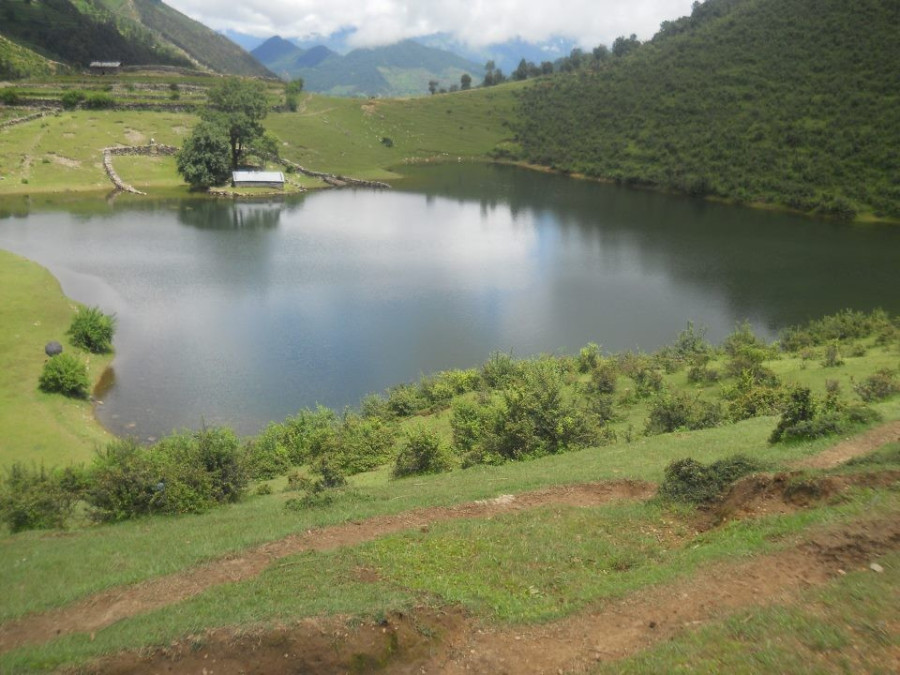
Post Report
Five others survived by swimming to safety, but Rawat drowned. Police said their investigation has found none of the men on the boat had worn lifejackets.
Related News

Youth exodus to India leaves Bajura villages with ageing, ailing residents

Woman buried to death in Doti

Five killed as tractor overturns in Achham
Darchula man ‘kills wife, injures two others with hoe’.

Nagarik Unmukti Party to back Congress-led government in Sudurpaschim
Most read from sudurpaschim province.

Editor's Picks

Rabi’s Freudian slip

‘Worry’ as Nepal’s forex reserves soar to record Rs1.84 trillion
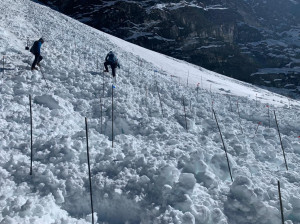
Tracking chip now mandatory for Everest aspirants

Rural women deprived of reproductive health rights

Indian travellers can now scan and pay in Nepal
E-paper | march 27, 2024.
- Read ePaper Online

IMAGES
VIDEO
COMMENTS
To understand when a catamaran or trimaran will capsize, I suggest you read this article: Why Catamarans Capsize. On the other hand, Trimarans are well-known for their righting torque (the ability of a vessel to right itself before flipping over). These vessels can reach a 27° angle before they flip over, but the trimaran will likely remain ...
In addition, as a trimaran heels, the downward pressure of wind on the sail increases, increasing the risk of capsize. The initial heel on a trimaran is more than it is on catamarans, and all of that downward force pushes the ama even deeper in the water. Thus, like monohulls, it usually makes sense to keep heel moderate.
The risk of capsize on a catamaran of more than 40 feet with a displacement of more than 10 tons is almost non-existent. ... reputation. But you really can't compare those racing machines with our cruising multihulls. Even among extreme vessels there are differences. An Ultim trimaran takes off in around 16 knots of wind. An Ocean Fifty sails ...
Anchoring and mooring a trimaran. While mooring a catamaran is complicated by the lack of a central bow, things should be simpler on a trimaran, and they are, mostly. Picking up a mooring buoy from the main hull bow with a low freeboard and dropping the pick-up line onto a cleat is easier even than a monohull.
Trimarans may range from having their maximum at 25 o for a wide tri with large volume amas supporting over 100% total weight, ... is the risk of capsize. So if we can find a way to reduce this with a solution that is both affordable and acceptably reliable, it's certainly well worth considering. ...
Both trimarans and catamarans heel, but trimarans provide greater stability and are less likely to capsize due to their three hulls. However, this doesn't mean a trimaran can't capsize. In rough conditions, if a wave gets higher than half the size of the beam, the boat can flip over, but because trimarans have exceptional buoyancy, they ...
Trimarans have greater beam than catamarans, making them considerably more resistant to capsize by wind alone, whether gusts or sustained wind. They heel sooner and more than catamaran, giving more warning that they are over powered. Waves are a different matter. The amas are generally much finer, designed for low resistance when sailing deeply ...
Capsize is very unlikely in most modern catamarans, but should the worst happen it is as well to be prepared, says Nigel Irens ... Most famous of all was Ellen MacArthur's 75ft trimaran B&Q ...
Rapidly rounding up can stall the rudders and may worsen the capsize risk in big seas. Spinnaker, headsail and main sheets should always be secured in a quick-release cleat. ... Trimarans, like a single-engined yachts, require knowledge to the effect of the water flow over the rudder from the propeller when undertaking tight manoeuvring ...
Can a trimaran capsize? In theory, in extreme conditions, if a wave is higher than half the beam size of the boat, a trimaran can capsize. However, trimarans are rather wide vessels and their three-hull configuration makes them very stable. A trimaran has a maximum righting moment of 27 degrees of heel, while a catamaran has a 12 degree one.
The sails of a catamaran can also contribute to the likelihood of a capsize. As the wind increases, the sails can act as a sail, pushing the boat over. If the sails are not managed correctly, they can push the boat too far, resulting in a capsize. Finally, large waves can cause a catamaran to become unstable and eventually capsize.
Maneuvering around the trimaran and living aboard can provide challenges for sailors. Like catamarans, their width can make getting dock space and haul-outs more challenging and expensive. ... All boats can capsize given extreme conditions. Many charter catamarans flipped when Hurricane Irma's 215 mph winds hit the British Virgin Islands in 2018.
The modern trimaran with its enormous stability and unsinkability is a very safe craft, and has now established an excellent safety record. ... and a few simple rules make this virtually impossible. Capsize is rare with well sailed cruising multihulls, but can occasionally occur with racers pushed to the limit - just like race cars. I raced ...
Catamarans are more stable than monohulls, but they can't compete with a trimaran when it comes to boat handling. If a catamaran and a trimaran were subjected to storms of equal intensity, the catamaran would be more likely to capsize than the trimaran. Catamarans, on the other hand, are not inherently dangerous.
Trimarans capsize: And proas capsize. At least, proas that have NO leeward bouyancy pods! ... Because even though it is very difficult to capsize, it can still do so in a big storm. And far from shore, no one can predict the weather, there are no "safe harbors" to shelter in, and there is no one to help un-capsize the boat. ...
On all types of yacht the traveller, mainsheet, outhaul, halyard and the Cunningham can be used to control the sail, and the information from the tell-tales can be used to help judge how much power the sail is providing and whether it is well trimmed. ... It is also far more dangerous to overload a 7-tonne trimaran that can capsize. However, on ...
The same factors that give way to superior inherent stability also do an excellent job preventing capsize. But the answer is a little more complicated than that. There are some limited instances where a catamaran can capsize, and the results are a lot more troublesome than monohull capsizing.
Although they can theoretically (and practically) capsize, cruising catamarans are the favourite type of boat among blue water sailors. Every year, dozens of family crews set off on their Lagoons, Fountaine Pajots, Nautitechs, Outremers and other series-produced catamarans on long voyages across the Atlantic or even around the world.
Speed - The Trimaran is the faster of the two boats. It can reach speeds of up to forty knots, while the Catamaran can only reach about half that speed. Stability - The Trimaran is more stable than the Catamaran. This is because it has three hulls instead of two. This makes it less likely to capsize in rough seas.
Bowsprit camera view of a Corsair F31 1D production trimaran at full speed in the San Francisco's Northbay. An unexpected strong gust causes the Ama/float to...
New Trimaran's Shocking Capsize. A shocking bit of news came out of western Europe over the weekend as current Vendée Globe champion and Banque Populaire skipper Armel le Cléac'h and a shorthanded crew capsized the brand-new Banque Populaire IX maxi-trimaran west of Morocco and the Strait of Gilbraltar while on a delivery from the team ...
1 - the bad tack, 2 - the sideways , 3 - the sideways on the wire , 4 - the gybe on the wire , 5 - newton's cradle , 6 - pitchpole sitting in , 7 - pitchpol...
Tokyo — A South Korean tanker capsized off an island in southwest Japan on Wednesday, authorities said, killing at least eight people on board. One crew member survived, and the fate of two ...
WESTPORT, Conn. -- Nearly 30 members of a Connecticut rowing club, including more than two dozen high schoolers, were rescued from the Long Island Sound on Wednesday after their boats capsized ...
Mr. Diop is a Senegalese novelist, journalist and screenwriter. He wrote from Dakar, Senegal. On Dec. 31, 1980, Léopold Sédar Senghor, the first president of Senegal, announced that he was ...
11 Rohingya found dead after Indonesia boat capsize AFP Published March 26, 2024 Updated March 26, 2024 07:00am . 0. Join our Whatsapp channel.
A 32-year-old man drowned when a wooden boat capsized in Chhededaha lake of Bajura, a hill district of Sudurpaschim Province, on Sunday. According to Deputy Superintendent of Police Kabindra Bohara, Birendra Rawat of ward 7 of Khaptad Chhededaha Rural Municipality died in the incident. A group of ...